Analysis: Effective Communication Impact in Project Management
VerifiedAdded on 2022/08/20
|34
|12391
|12
Report
AI Summary
This report investigates the impact of effective communication on project management. The study begins with an introduction to the concept of communication and its importance in project settings, followed by a literature review exploring various types of communication, barriers, and the critical role of effective communication for project managers. The research methodology outlines the approach, including interviews with project managers to gather data. The data analysis section presents the findings, discussing communication theories, plans, and the significance of both formal and informal communication, knowledge sharing, and verbal and non-verbal communication. The report concludes with recommendations for improving communication within projects, emphasizing its crucial role in achieving project success. The report highlights the necessity of effective communication as a key factor for project success.
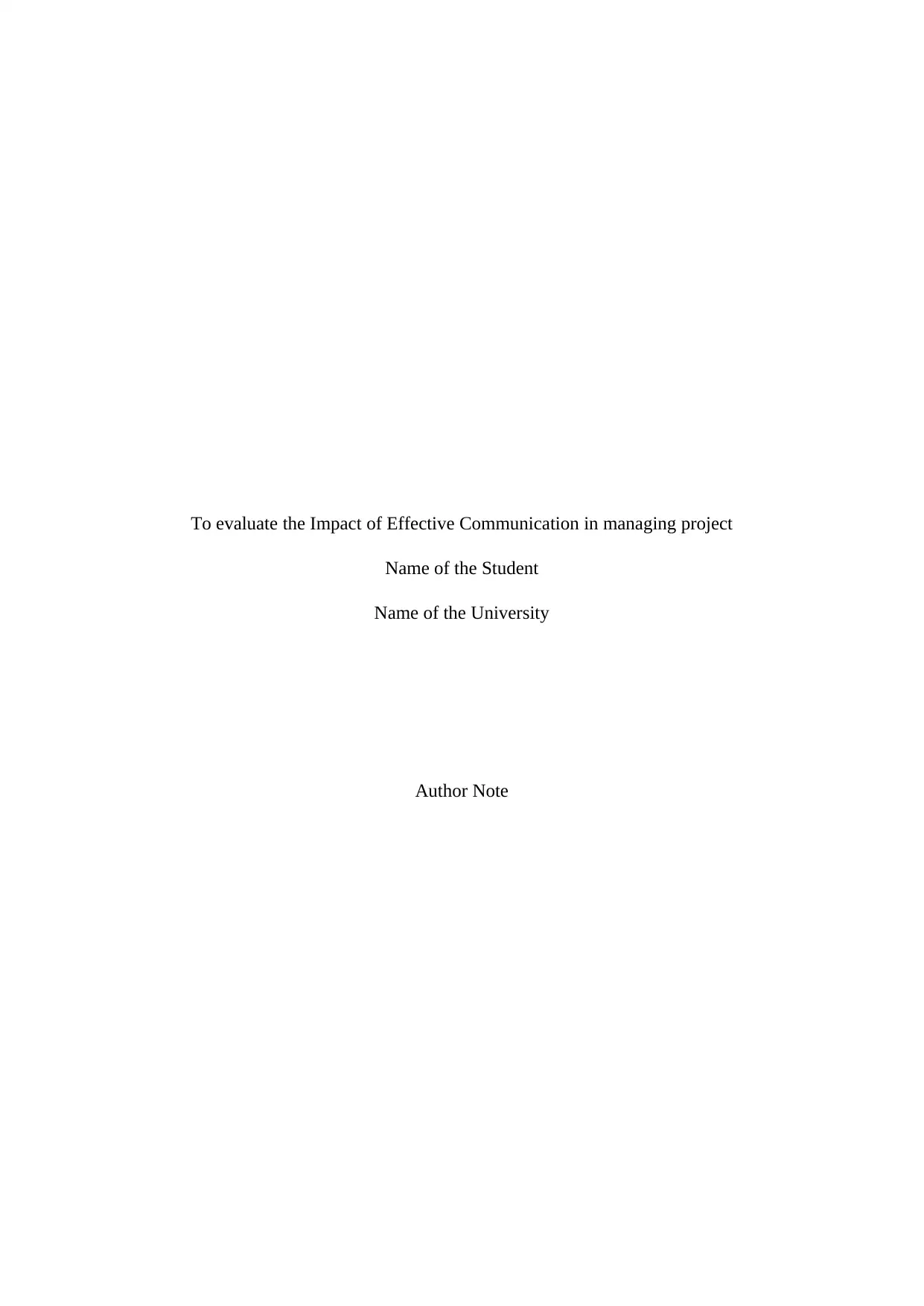
To evaluate the Impact of Effective Communication in managing project
Name of the Student
Name of the University
Author Note
Name of the Student
Name of the University
Author Note
Secure Best Marks with AI Grader
Need help grading? Try our AI Grader for instant feedback on your assignments.
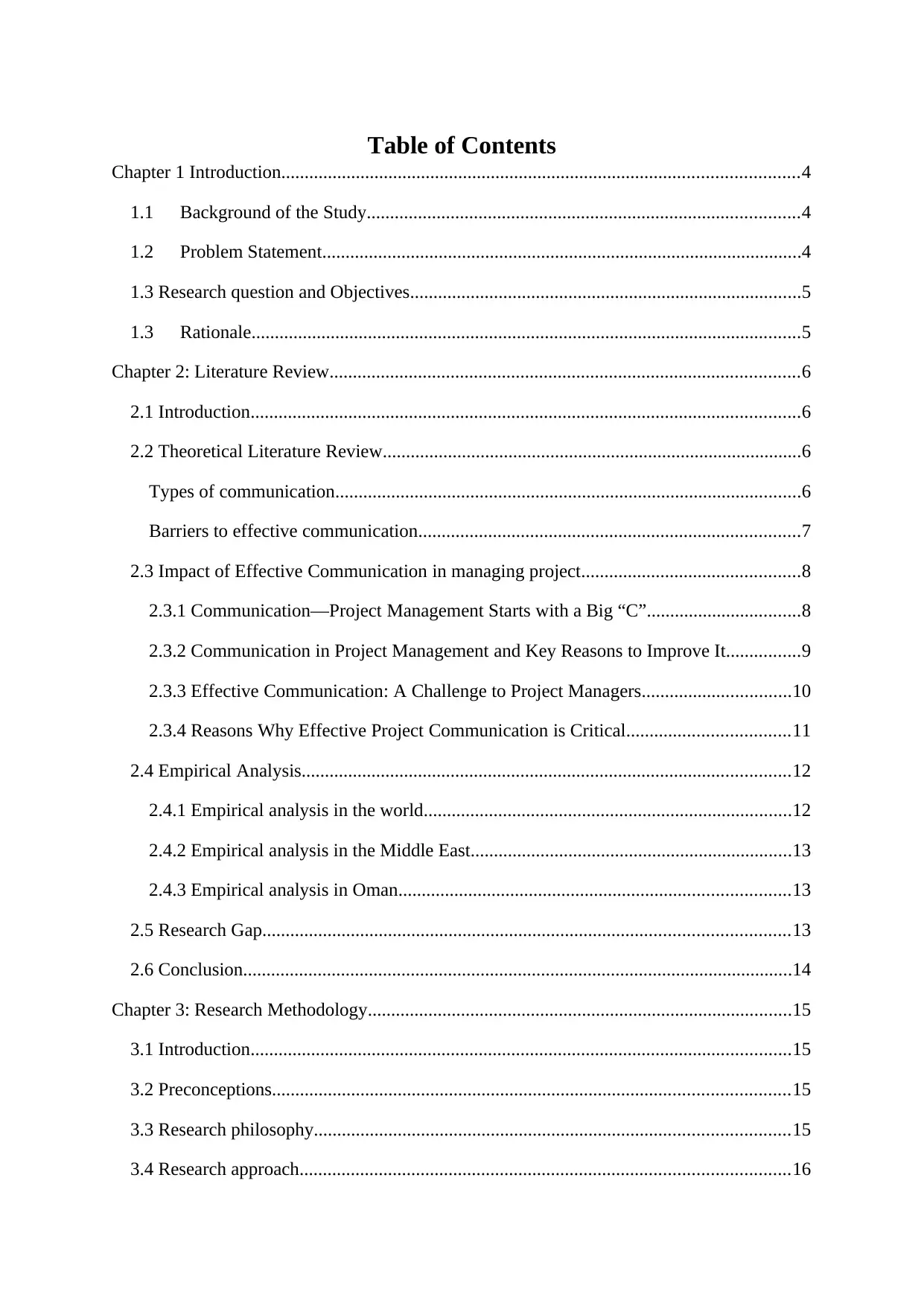
Table of Contents
Chapter 1 Introduction...............................................................................................................4
1.1 Background of the Study.............................................................................................4
1.2 Problem Statement.......................................................................................................4
1.3 Research question and Objectives....................................................................................5
1.3 Rationale......................................................................................................................5
Chapter 2: Literature Review.....................................................................................................6
2.1 Introduction......................................................................................................................6
2.2 Theoretical Literature Review..........................................................................................6
Types of communication....................................................................................................6
Barriers to effective communication..................................................................................7
2.3 Impact of Effective Communication in managing project...............................................8
2.3.1 Communication—Project Management Starts with a Big “C”.................................8
2.3.2 Communication in Project Management and Key Reasons to Improve It................9
2.3.3 Effective Communication: A Challenge to Project Managers................................10
2.3.4 Reasons Why Effective Project Communication is Critical...................................11
2.4 Empirical Analysis.........................................................................................................12
2.4.1 Empirical analysis in the world...............................................................................12
2.4.2 Empirical analysis in the Middle East.....................................................................13
2.4.3 Empirical analysis in Oman....................................................................................13
2.5 Research Gap.................................................................................................................13
2.6 Conclusion......................................................................................................................14
Chapter 3: Research Methodology...........................................................................................15
3.1 Introduction....................................................................................................................15
3.2 Preconceptions...............................................................................................................15
3.3 Research philosophy......................................................................................................15
3.4 Research approach.........................................................................................................16
Chapter 1 Introduction...............................................................................................................4
1.1 Background of the Study.............................................................................................4
1.2 Problem Statement.......................................................................................................4
1.3 Research question and Objectives....................................................................................5
1.3 Rationale......................................................................................................................5
Chapter 2: Literature Review.....................................................................................................6
2.1 Introduction......................................................................................................................6
2.2 Theoretical Literature Review..........................................................................................6
Types of communication....................................................................................................6
Barriers to effective communication..................................................................................7
2.3 Impact of Effective Communication in managing project...............................................8
2.3.1 Communication—Project Management Starts with a Big “C”.................................8
2.3.2 Communication in Project Management and Key Reasons to Improve It................9
2.3.3 Effective Communication: A Challenge to Project Managers................................10
2.3.4 Reasons Why Effective Project Communication is Critical...................................11
2.4 Empirical Analysis.........................................................................................................12
2.4.1 Empirical analysis in the world...............................................................................12
2.4.2 Empirical analysis in the Middle East.....................................................................13
2.4.3 Empirical analysis in Oman....................................................................................13
2.5 Research Gap.................................................................................................................13
2.6 Conclusion......................................................................................................................14
Chapter 3: Research Methodology...........................................................................................15
3.1 Introduction....................................................................................................................15
3.2 Preconceptions...............................................................................................................15
3.3 Research philosophy......................................................................................................15
3.4 Research approach.........................................................................................................16
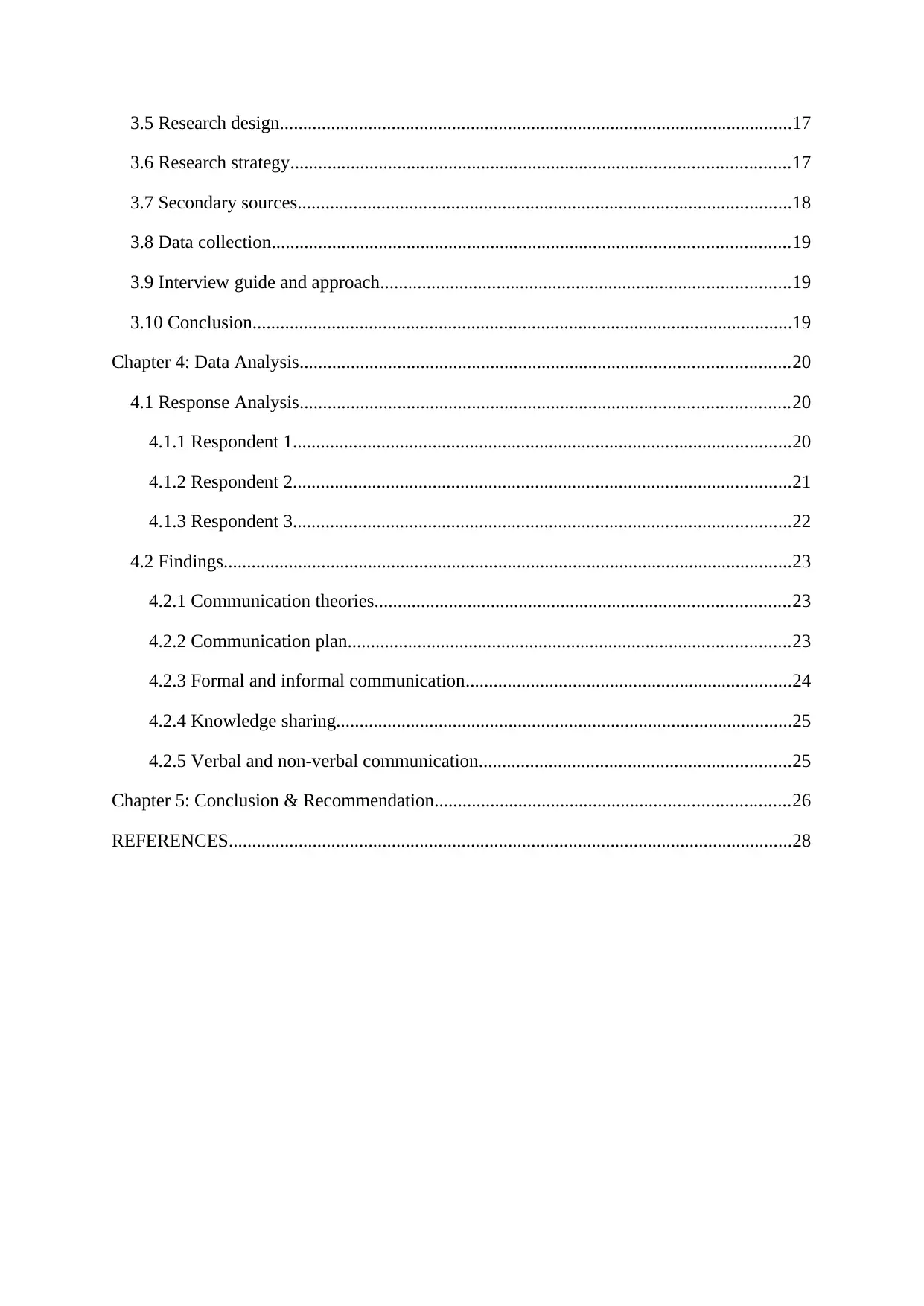
3.5 Research design..............................................................................................................17
3.6 Research strategy...........................................................................................................17
3.7 Secondary sources..........................................................................................................18
3.8 Data collection...............................................................................................................19
3.9 Interview guide and approach........................................................................................19
3.10 Conclusion....................................................................................................................19
Chapter 4: Data Analysis.........................................................................................................20
4.1 Response Analysis.........................................................................................................20
4.1.1 Respondent 1...........................................................................................................20
4.1.2 Respondent 2...........................................................................................................21
4.1.3 Respondent 3...........................................................................................................22
4.2 Findings..........................................................................................................................23
4.2.1 Communication theories.........................................................................................23
4.2.2 Communication plan...............................................................................................23
4.2.3 Formal and informal communication......................................................................24
4.2.4 Knowledge sharing..................................................................................................25
4.2.5 Verbal and non-verbal communication...................................................................25
Chapter 5: Conclusion & Recommendation............................................................................26
REFERENCES.........................................................................................................................28
3.6 Research strategy...........................................................................................................17
3.7 Secondary sources..........................................................................................................18
3.8 Data collection...............................................................................................................19
3.9 Interview guide and approach........................................................................................19
3.10 Conclusion....................................................................................................................19
Chapter 4: Data Analysis.........................................................................................................20
4.1 Response Analysis.........................................................................................................20
4.1.1 Respondent 1...........................................................................................................20
4.1.2 Respondent 2...........................................................................................................21
4.1.3 Respondent 3...........................................................................................................22
4.2 Findings..........................................................................................................................23
4.2.1 Communication theories.........................................................................................23
4.2.2 Communication plan...............................................................................................23
4.2.3 Formal and informal communication......................................................................24
4.2.4 Knowledge sharing..................................................................................................25
4.2.5 Verbal and non-verbal communication...................................................................25
Chapter 5: Conclusion & Recommendation............................................................................26
REFERENCES.........................................................................................................................28
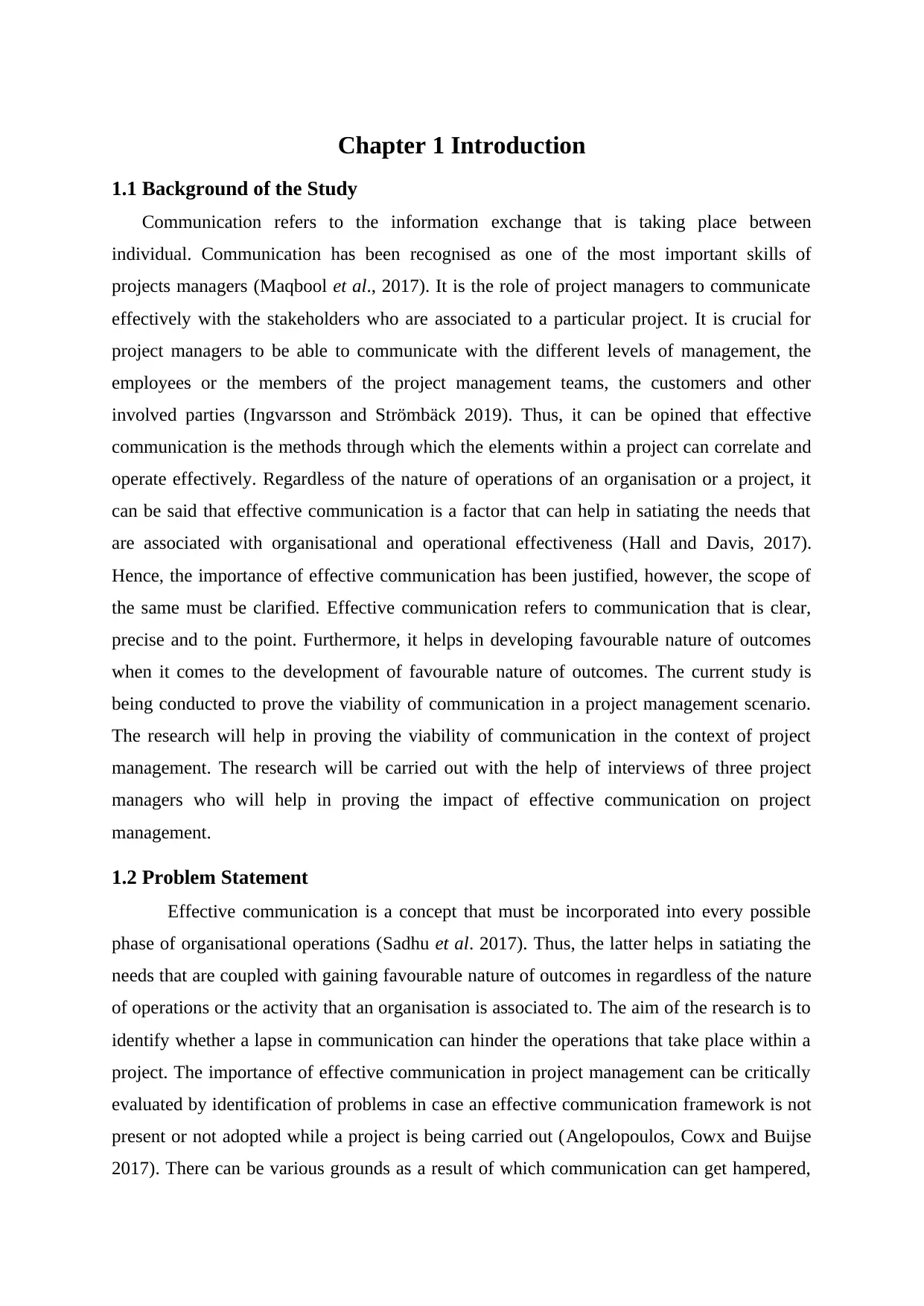
Chapter 1 Introduction
1.1 Background of the Study
Communication refers to the information exchange that is taking place between
individual. Communication has been recognised as one of the most important skills of
projects managers (Maqbool et al., 2017). It is the role of project managers to communicate
effectively with the stakeholders who are associated to a particular project. It is crucial for
project managers to be able to communicate with the different levels of management, the
employees or the members of the project management teams, the customers and other
involved parties (Ingvarsson and Strömbäck 2019). Thus, it can be opined that effective
communication is the methods through which the elements within a project can correlate and
operate effectively. Regardless of the nature of operations of an organisation or a project, it
can be said that effective communication is a factor that can help in satiating the needs that
are associated with organisational and operational effectiveness (Hall and Davis, 2017).
Hence, the importance of effective communication has been justified, however, the scope of
the same must be clarified. Effective communication refers to communication that is clear,
precise and to the point. Furthermore, it helps in developing favourable nature of outcomes
when it comes to the development of favourable nature of outcomes. The current study is
being conducted to prove the viability of communication in a project management scenario.
The research will help in proving the viability of communication in the context of project
management. The research will be carried out with the help of interviews of three project
managers who will help in proving the impact of effective communication on project
management.
1.2 Problem Statement
Effective communication is a concept that must be incorporated into every possible
phase of organisational operations (Sadhu et al. 2017). Thus, the latter helps in satiating the
needs that are coupled with gaining favourable nature of outcomes in regardless of the nature
of operations or the activity that an organisation is associated to. The aim of the research is to
identify whether a lapse in communication can hinder the operations that take place within a
project. The importance of effective communication in project management can be critically
evaluated by identification of problems in case an effective communication framework is not
present or not adopted while a project is being carried out (Angelopoulos, Cowx and Buijse
2017). There can be various grounds as a result of which communication can get hampered,
1.1 Background of the Study
Communication refers to the information exchange that is taking place between
individual. Communication has been recognised as one of the most important skills of
projects managers (Maqbool et al., 2017). It is the role of project managers to communicate
effectively with the stakeholders who are associated to a particular project. It is crucial for
project managers to be able to communicate with the different levels of management, the
employees or the members of the project management teams, the customers and other
involved parties (Ingvarsson and Strömbäck 2019). Thus, it can be opined that effective
communication is the methods through which the elements within a project can correlate and
operate effectively. Regardless of the nature of operations of an organisation or a project, it
can be said that effective communication is a factor that can help in satiating the needs that
are associated with organisational and operational effectiveness (Hall and Davis, 2017).
Hence, the importance of effective communication has been justified, however, the scope of
the same must be clarified. Effective communication refers to communication that is clear,
precise and to the point. Furthermore, it helps in developing favourable nature of outcomes
when it comes to the development of favourable nature of outcomes. The current study is
being conducted to prove the viability of communication in a project management scenario.
The research will help in proving the viability of communication in the context of project
management. The research will be carried out with the help of interviews of three project
managers who will help in proving the impact of effective communication on project
management.
1.2 Problem Statement
Effective communication is a concept that must be incorporated into every possible
phase of organisational operations (Sadhu et al. 2017). Thus, the latter helps in satiating the
needs that are coupled with gaining favourable nature of outcomes in regardless of the nature
of operations or the activity that an organisation is associated to. The aim of the research is to
identify whether a lapse in communication can hinder the operations that take place within a
project. The importance of effective communication in project management can be critically
evaluated by identification of problems in case an effective communication framework is not
present or not adopted while a project is being carried out (Angelopoulos, Cowx and Buijse
2017). There can be various grounds as a result of which communication can get hampered,
Secure Best Marks with AI Grader
Need help grading? Try our AI Grader for instant feedback on your assignments.
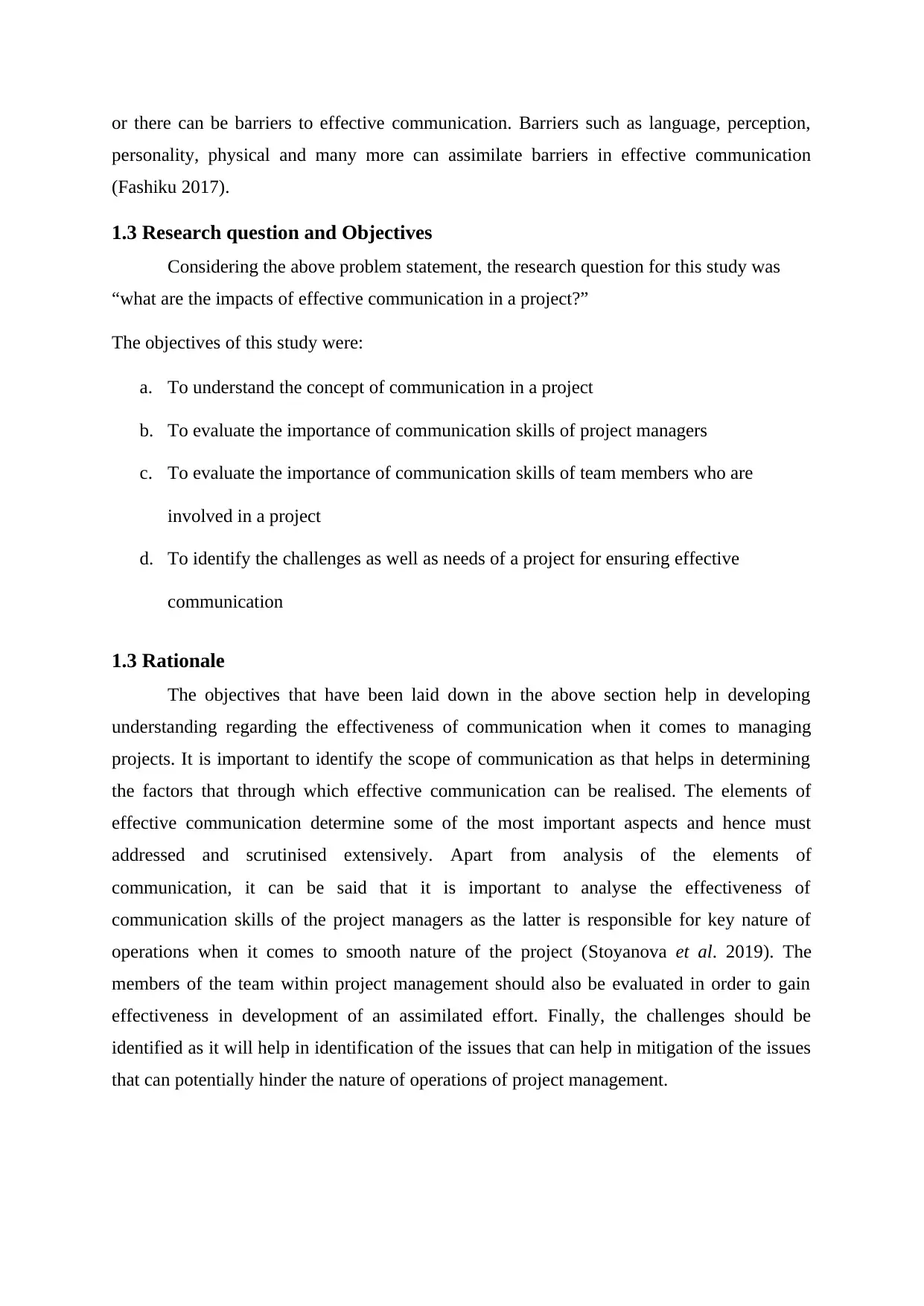
or there can be barriers to effective communication. Barriers such as language, perception,
personality, physical and many more can assimilate barriers in effective communication
(Fashiku 2017).
1.3 Research question and Objectives
Considering the above problem statement, the research question for this study was
“what are the impacts of effective communication in a project?”
The objectives of this study were:
a. To understand the concept of communication in a project
b. To evaluate the importance of communication skills of project managers
c. To evaluate the importance of communication skills of team members who are
involved in a project
d. To identify the challenges as well as needs of a project for ensuring effective
communication
1.3 Rationale
The objectives that have been laid down in the above section help in developing
understanding regarding the effectiveness of communication when it comes to managing
projects. It is important to identify the scope of communication as that helps in determining
the factors that through which effective communication can be realised. The elements of
effective communication determine some of the most important aspects and hence must
addressed and scrutinised extensively. Apart from analysis of the elements of
communication, it can be said that it is important to analyse the effectiveness of
communication skills of the project managers as the latter is responsible for key nature of
operations when it comes to smooth nature of the project (Stoyanova et al. 2019). The
members of the team within project management should also be evaluated in order to gain
effectiveness in development of an assimilated effort. Finally, the challenges should be
identified as it will help in identification of the issues that can help in mitigation of the issues
that can potentially hinder the nature of operations of project management.
personality, physical and many more can assimilate barriers in effective communication
(Fashiku 2017).
1.3 Research question and Objectives
Considering the above problem statement, the research question for this study was
“what are the impacts of effective communication in a project?”
The objectives of this study were:
a. To understand the concept of communication in a project
b. To evaluate the importance of communication skills of project managers
c. To evaluate the importance of communication skills of team members who are
involved in a project
d. To identify the challenges as well as needs of a project for ensuring effective
communication
1.3 Rationale
The objectives that have been laid down in the above section help in developing
understanding regarding the effectiveness of communication when it comes to managing
projects. It is important to identify the scope of communication as that helps in determining
the factors that through which effective communication can be realised. The elements of
effective communication determine some of the most important aspects and hence must
addressed and scrutinised extensively. Apart from analysis of the elements of
communication, it can be said that it is important to analyse the effectiveness of
communication skills of the project managers as the latter is responsible for key nature of
operations when it comes to smooth nature of the project (Stoyanova et al. 2019). The
members of the team within project management should also be evaluated in order to gain
effectiveness in development of an assimilated effort. Finally, the challenges should be
identified as it will help in identification of the issues that can help in mitigation of the issues
that can potentially hinder the nature of operations of project management.
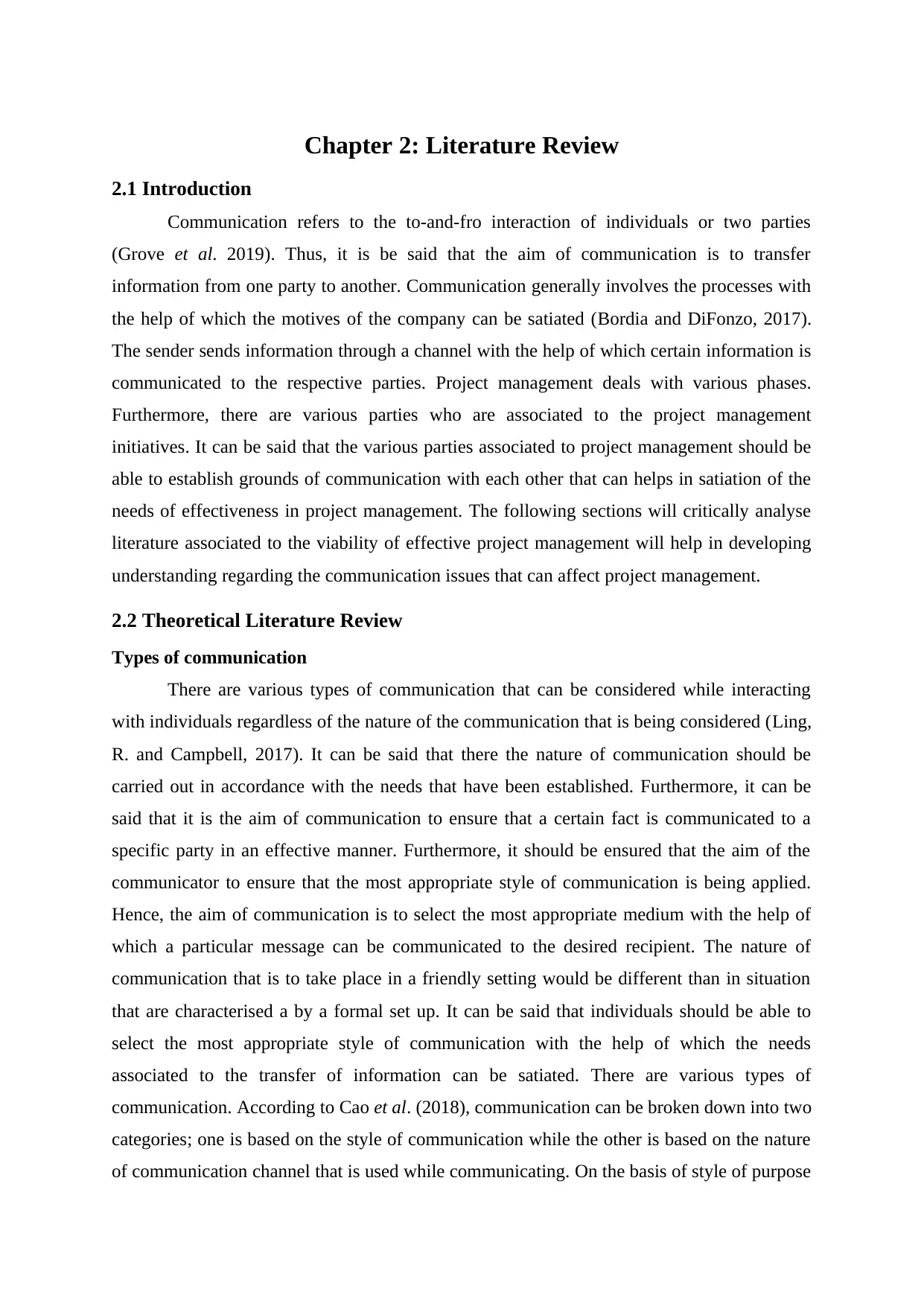
Chapter 2: Literature Review
2.1 Introduction
Communication refers to the to-and-fro interaction of individuals or two parties
(Grove et al. 2019). Thus, it is be said that the aim of communication is to transfer
information from one party to another. Communication generally involves the processes with
the help of which the motives of the company can be satiated (Bordia and DiFonzo, 2017).
The sender sends information through a channel with the help of which certain information is
communicated to the respective parties. Project management deals with various phases.
Furthermore, there are various parties who are associated to the project management
initiatives. It can be said that the various parties associated to project management should be
able to establish grounds of communication with each other that can helps in satiation of the
needs of effectiveness in project management. The following sections will critically analyse
literature associated to the viability of effective project management will help in developing
understanding regarding the communication issues that can affect project management.
2.2 Theoretical Literature Review
Types of communication
There are various types of communication that can be considered while interacting
with individuals regardless of the nature of the communication that is being considered (Ling,
R. and Campbell, 2017). It can be said that there the nature of communication should be
carried out in accordance with the needs that have been established. Furthermore, it can be
said that it is the aim of communication to ensure that a certain fact is communicated to a
specific party in an effective manner. Furthermore, it should be ensured that the aim of the
communicator to ensure that the most appropriate style of communication is being applied.
Hence, the aim of communication is to select the most appropriate medium with the help of
which a particular message can be communicated to the desired recipient. The nature of
communication that is to take place in a friendly setting would be different than in situation
that are characterised a by a formal set up. It can be said that individuals should be able to
select the most appropriate style of communication with the help of which the needs
associated to the transfer of information can be satiated. There are various types of
communication. According to Cao et al. (2018), communication can be broken down into two
categories; one is based on the style of communication while the other is based on the nature
of communication channel that is used while communicating. On the basis of style of purpose
2.1 Introduction
Communication refers to the to-and-fro interaction of individuals or two parties
(Grove et al. 2019). Thus, it is be said that the aim of communication is to transfer
information from one party to another. Communication generally involves the processes with
the help of which the motives of the company can be satiated (Bordia and DiFonzo, 2017).
The sender sends information through a channel with the help of which certain information is
communicated to the respective parties. Project management deals with various phases.
Furthermore, there are various parties who are associated to the project management
initiatives. It can be said that the various parties associated to project management should be
able to establish grounds of communication with each other that can helps in satiation of the
needs of effectiveness in project management. The following sections will critically analyse
literature associated to the viability of effective project management will help in developing
understanding regarding the communication issues that can affect project management.
2.2 Theoretical Literature Review
Types of communication
There are various types of communication that can be considered while interacting
with individuals regardless of the nature of the communication that is being considered (Ling,
R. and Campbell, 2017). It can be said that there the nature of communication should be
carried out in accordance with the needs that have been established. Furthermore, it can be
said that it is the aim of communication to ensure that a certain fact is communicated to a
specific party in an effective manner. Furthermore, it should be ensured that the aim of the
communicator to ensure that the most appropriate style of communication is being applied.
Hence, the aim of communication is to select the most appropriate medium with the help of
which a particular message can be communicated to the desired recipient. The nature of
communication that is to take place in a friendly setting would be different than in situation
that are characterised a by a formal set up. It can be said that individuals should be able to
select the most appropriate style of communication with the help of which the needs
associated to the transfer of information can be satiated. There are various types of
communication. According to Cao et al. (2018), communication can be broken down into two
categories; one is based on the style of communication while the other is based on the nature
of communication channel that is used while communicating. On the basis of style of purpose
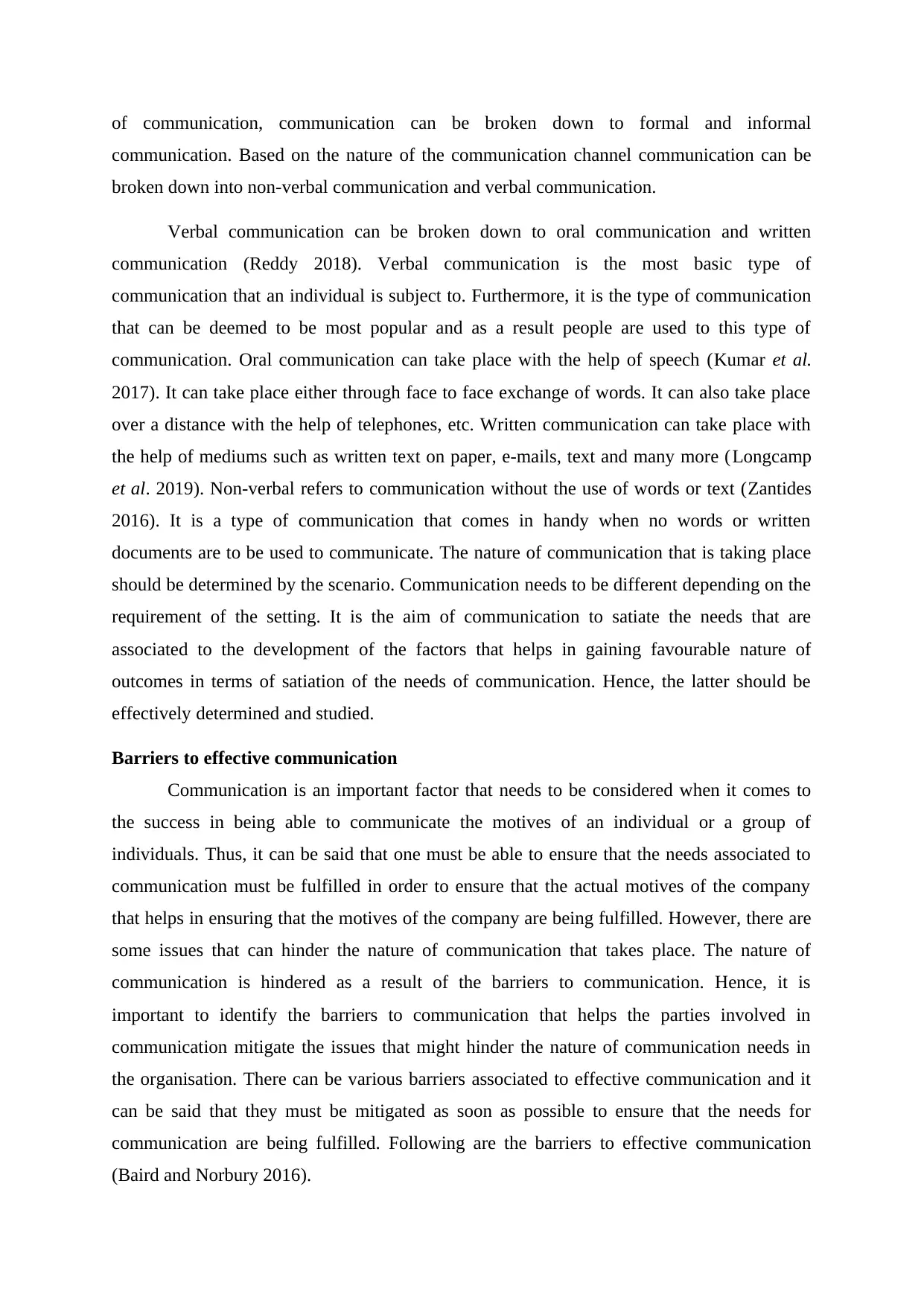
of communication, communication can be broken down to formal and informal
communication. Based on the nature of the communication channel communication can be
broken down into non-verbal communication and verbal communication.
Verbal communication can be broken down to oral communication and written
communication (Reddy 2018). Verbal communication is the most basic type of
communication that an individual is subject to. Furthermore, it is the type of communication
that can be deemed to be most popular and as a result people are used to this type of
communication. Oral communication can take place with the help of speech (Kumar et al.
2017). It can take place either through face to face exchange of words. It can also take place
over a distance with the help of telephones, etc. Written communication can take place with
the help of mediums such as written text on paper, e-mails, text and many more (Longcamp
et al. 2019). Non-verbal refers to communication without the use of words or text (Zantides
2016). It is a type of communication that comes in handy when no words or written
documents are to be used to communicate. The nature of communication that is taking place
should be determined by the scenario. Communication needs to be different depending on the
requirement of the setting. It is the aim of communication to satiate the needs that are
associated to the development of the factors that helps in gaining favourable nature of
outcomes in terms of satiation of the needs of communication. Hence, the latter should be
effectively determined and studied.
Barriers to effective communication
Communication is an important factor that needs to be considered when it comes to
the success in being able to communicate the motives of an individual or a group of
individuals. Thus, it can be said that one must be able to ensure that the needs associated to
communication must be fulfilled in order to ensure that the actual motives of the company
that helps in ensuring that the motives of the company are being fulfilled. However, there are
some issues that can hinder the nature of communication that takes place. The nature of
communication is hindered as a result of the barriers to communication. Hence, it is
important to identify the barriers to communication that helps the parties involved in
communication mitigate the issues that might hinder the nature of communication needs in
the organisation. There can be various barriers associated to effective communication and it
can be said that they must be mitigated as soon as possible to ensure that the needs for
communication are being fulfilled. Following are the barriers to effective communication
(Baird and Norbury 2016).
communication. Based on the nature of the communication channel communication can be
broken down into non-verbal communication and verbal communication.
Verbal communication can be broken down to oral communication and written
communication (Reddy 2018). Verbal communication is the most basic type of
communication that an individual is subject to. Furthermore, it is the type of communication
that can be deemed to be most popular and as a result people are used to this type of
communication. Oral communication can take place with the help of speech (Kumar et al.
2017). It can take place either through face to face exchange of words. It can also take place
over a distance with the help of telephones, etc. Written communication can take place with
the help of mediums such as written text on paper, e-mails, text and many more (Longcamp
et al. 2019). Non-verbal refers to communication without the use of words or text (Zantides
2016). It is a type of communication that comes in handy when no words or written
documents are to be used to communicate. The nature of communication that is taking place
should be determined by the scenario. Communication needs to be different depending on the
requirement of the setting. It is the aim of communication to satiate the needs that are
associated to the development of the factors that helps in gaining favourable nature of
outcomes in terms of satiation of the needs of communication. Hence, the latter should be
effectively determined and studied.
Barriers to effective communication
Communication is an important factor that needs to be considered when it comes to
the success in being able to communicate the motives of an individual or a group of
individuals. Thus, it can be said that one must be able to ensure that the needs associated to
communication must be fulfilled in order to ensure that the actual motives of the company
that helps in ensuring that the motives of the company are being fulfilled. However, there are
some issues that can hinder the nature of communication that takes place. The nature of
communication is hindered as a result of the barriers to communication. Hence, it is
important to identify the barriers to communication that helps the parties involved in
communication mitigate the issues that might hinder the nature of communication needs in
the organisation. There can be various barriers associated to effective communication and it
can be said that they must be mitigated as soon as possible to ensure that the needs for
communication are being fulfilled. Following are the barriers to effective communication
(Baird and Norbury 2016).
Paraphrase This Document
Need a fresh take? Get an instant paraphrase of this document with our AI Paraphraser
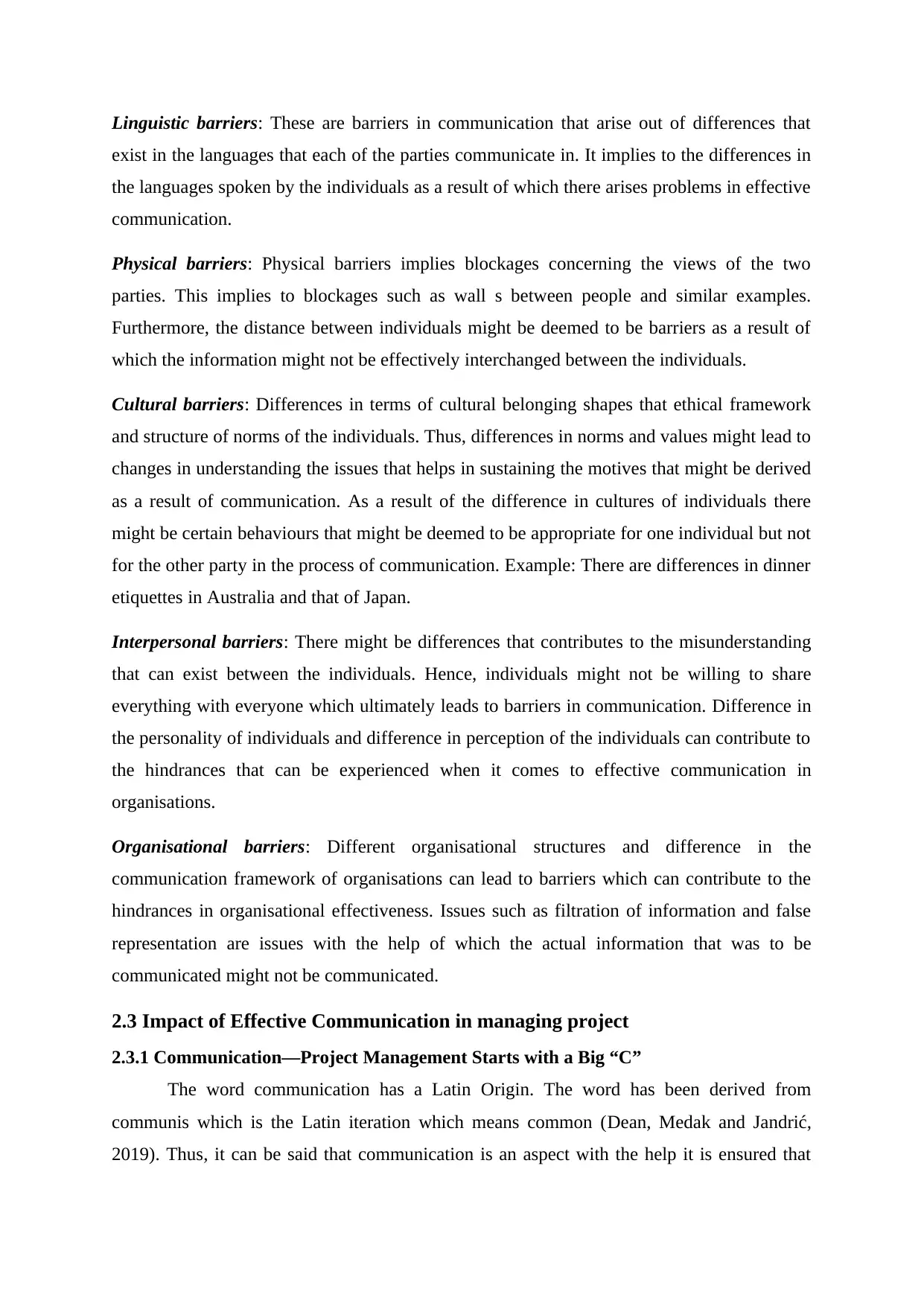
Linguistic barriers: These are barriers in communication that arise out of differences that
exist in the languages that each of the parties communicate in. It implies to the differences in
the languages spoken by the individuals as a result of which there arises problems in effective
communication.
Physical barriers: Physical barriers implies blockages concerning the views of the two
parties. This implies to blockages such as wall s between people and similar examples.
Furthermore, the distance between individuals might be deemed to be barriers as a result of
which the information might not be effectively interchanged between the individuals.
Cultural barriers: Differences in terms of cultural belonging shapes that ethical framework
and structure of norms of the individuals. Thus, differences in norms and values might lead to
changes in understanding the issues that helps in sustaining the motives that might be derived
as a result of communication. As a result of the difference in cultures of individuals there
might be certain behaviours that might be deemed to be appropriate for one individual but not
for the other party in the process of communication. Example: There are differences in dinner
etiquettes in Australia and that of Japan.
Interpersonal barriers: There might be differences that contributes to the misunderstanding
that can exist between the individuals. Hence, individuals might not be willing to share
everything with everyone which ultimately leads to barriers in communication. Difference in
the personality of individuals and difference in perception of the individuals can contribute to
the hindrances that can be experienced when it comes to effective communication in
organisations.
Organisational barriers: Different organisational structures and difference in the
communication framework of organisations can lead to barriers which can contribute to the
hindrances in organisational effectiveness. Issues such as filtration of information and false
representation are issues with the help of which the actual information that was to be
communicated might not be communicated.
2.3 Impact of Effective Communication in managing project
2.3.1 Communication—Project Management Starts with a Big “C”
The word communication has a Latin Origin. The word has been derived from
communis which is the Latin iteration which means common (Dean, Medak and Jandrić,
2019). Thus, it can be said that communication is an aspect with the help it is ensured that
exist in the languages that each of the parties communicate in. It implies to the differences in
the languages spoken by the individuals as a result of which there arises problems in effective
communication.
Physical barriers: Physical barriers implies blockages concerning the views of the two
parties. This implies to blockages such as wall s between people and similar examples.
Furthermore, the distance between individuals might be deemed to be barriers as a result of
which the information might not be effectively interchanged between the individuals.
Cultural barriers: Differences in terms of cultural belonging shapes that ethical framework
and structure of norms of the individuals. Thus, differences in norms and values might lead to
changes in understanding the issues that helps in sustaining the motives that might be derived
as a result of communication. As a result of the difference in cultures of individuals there
might be certain behaviours that might be deemed to be appropriate for one individual but not
for the other party in the process of communication. Example: There are differences in dinner
etiquettes in Australia and that of Japan.
Interpersonal barriers: There might be differences that contributes to the misunderstanding
that can exist between the individuals. Hence, individuals might not be willing to share
everything with everyone which ultimately leads to barriers in communication. Difference in
the personality of individuals and difference in perception of the individuals can contribute to
the hindrances that can be experienced when it comes to effective communication in
organisations.
Organisational barriers: Different organisational structures and difference in the
communication framework of organisations can lead to barriers which can contribute to the
hindrances in organisational effectiveness. Issues such as filtration of information and false
representation are issues with the help of which the actual information that was to be
communicated might not be communicated.
2.3 Impact of Effective Communication in managing project
2.3.1 Communication—Project Management Starts with a Big “C”
The word communication has a Latin Origin. The word has been derived from
communis which is the Latin iteration which means common (Dean, Medak and Jandrić,
2019). Thus, it can be said that communication is an aspect with the help it is ensured that
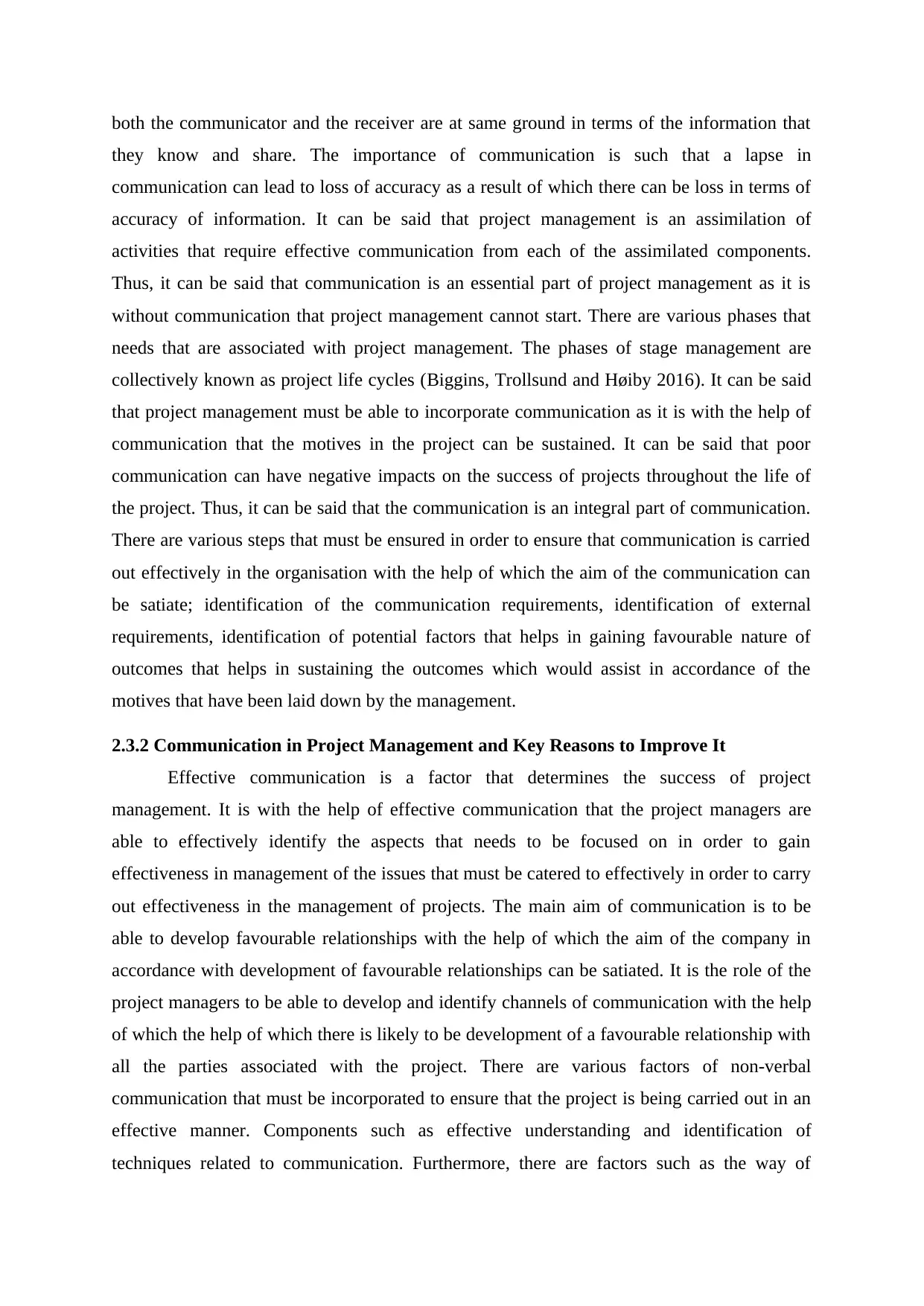
both the communicator and the receiver are at same ground in terms of the information that
they know and share. The importance of communication is such that a lapse in
communication can lead to loss of accuracy as a result of which there can be loss in terms of
accuracy of information. It can be said that project management is an assimilation of
activities that require effective communication from each of the assimilated components.
Thus, it can be said that communication is an essential part of project management as it is
without communication that project management cannot start. There are various phases that
needs that are associated with project management. The phases of stage management are
collectively known as project life cycles (Biggins, Trollsund and Høiby 2016). It can be said
that project management must be able to incorporate communication as it is with the help of
communication that the motives in the project can be sustained. It can be said that poor
communication can have negative impacts on the success of projects throughout the life of
the project. Thus, it can be said that the communication is an integral part of communication.
There are various steps that must be ensured in order to ensure that communication is carried
out effectively in the organisation with the help of which the aim of the communication can
be satiate; identification of the communication requirements, identification of external
requirements, identification of potential factors that helps in gaining favourable nature of
outcomes that helps in sustaining the outcomes which would assist in accordance of the
motives that have been laid down by the management.
2.3.2 Communication in Project Management and Key Reasons to Improve It
Effective communication is a factor that determines the success of project
management. It is with the help of effective communication that the project managers are
able to effectively identify the aspects that needs to be focused on in order to gain
effectiveness in management of the issues that must be catered to effectively in order to carry
out effectiveness in the management of projects. The main aim of communication is to be
able to develop favourable relationships with the help of which the aim of the company in
accordance with development of favourable relationships can be satiated. It is the role of the
project managers to be able to develop and identify channels of communication with the help
of which the help of which there is likely to be development of a favourable relationship with
all the parties associated with the project. There are various factors of non-verbal
communication that must be incorporated to ensure that the project is being carried out in an
effective manner. Components such as effective understanding and identification of
techniques related to communication. Furthermore, there are factors such as the way of
they know and share. The importance of communication is such that a lapse in
communication can lead to loss of accuracy as a result of which there can be loss in terms of
accuracy of information. It can be said that project management is an assimilation of
activities that require effective communication from each of the assimilated components.
Thus, it can be said that communication is an essential part of project management as it is
without communication that project management cannot start. There are various phases that
needs that are associated with project management. The phases of stage management are
collectively known as project life cycles (Biggins, Trollsund and Høiby 2016). It can be said
that project management must be able to incorporate communication as it is with the help of
communication that the motives in the project can be sustained. It can be said that poor
communication can have negative impacts on the success of projects throughout the life of
the project. Thus, it can be said that the communication is an integral part of communication.
There are various steps that must be ensured in order to ensure that communication is carried
out effectively in the organisation with the help of which the aim of the communication can
be satiate; identification of the communication requirements, identification of external
requirements, identification of potential factors that helps in gaining favourable nature of
outcomes that helps in sustaining the outcomes which would assist in accordance of the
motives that have been laid down by the management.
2.3.2 Communication in Project Management and Key Reasons to Improve It
Effective communication is a factor that determines the success of project
management. It is with the help of effective communication that the project managers are
able to effectively identify the aspects that needs to be focused on in order to gain
effectiveness in management of the issues that must be catered to effectively in order to carry
out effectiveness in the management of projects. The main aim of communication is to be
able to develop favourable relationships with the help of which the aim of the company in
accordance with development of favourable relationships can be satiated. It is the role of the
project managers to be able to develop and identify channels of communication with the help
of which the help of which there is likely to be development of a favourable relationship with
all the parties associated with the project. There are various factors of non-verbal
communication that must be incorporated to ensure that the project is being carried out in an
effective manner. Components such as effective understanding and identification of
techniques related to communication. Furthermore, there are factors such as the way of
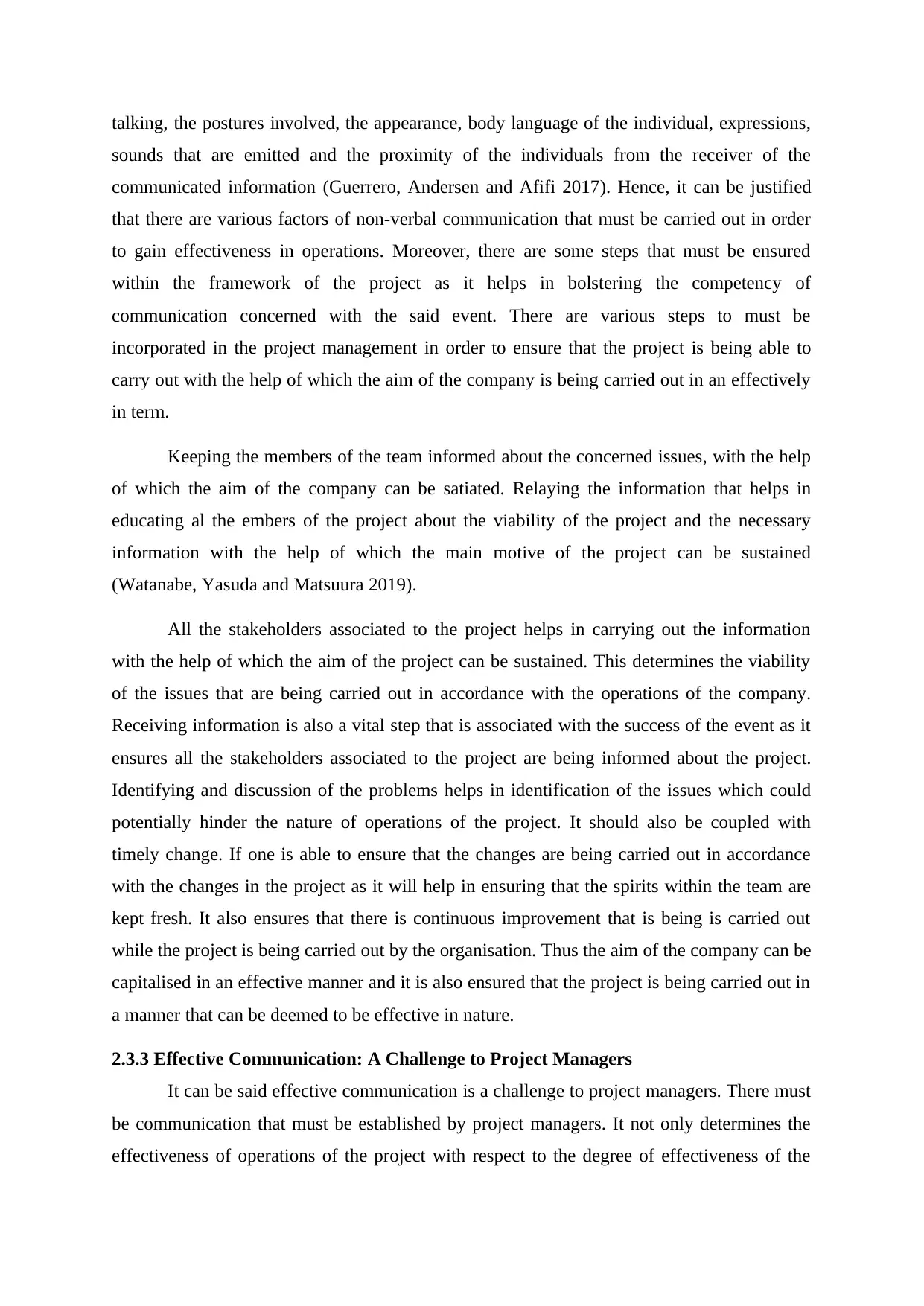
talking, the postures involved, the appearance, body language of the individual, expressions,
sounds that are emitted and the proximity of the individuals from the receiver of the
communicated information (Guerrero, Andersen and Afifi 2017). Hence, it can be justified
that there are various factors of non-verbal communication that must be carried out in order
to gain effectiveness in operations. Moreover, there are some steps that must be ensured
within the framework of the project as it helps in bolstering the competency of
communication concerned with the said event. There are various steps to must be
incorporated in the project management in order to ensure that the project is being able to
carry out with the help of which the aim of the company is being carried out in an effectively
in term.
Keeping the members of the team informed about the concerned issues, with the help
of which the aim of the company can be satiated. Relaying the information that helps in
educating al the embers of the project about the viability of the project and the necessary
information with the help of which the main motive of the project can be sustained
(Watanabe, Yasuda and Matsuura 2019).
All the stakeholders associated to the project helps in carrying out the information
with the help of which the aim of the project can be sustained. This determines the viability
of the issues that are being carried out in accordance with the operations of the company.
Receiving information is also a vital step that is associated with the success of the event as it
ensures all the stakeholders associated to the project are being informed about the project.
Identifying and discussion of the problems helps in identification of the issues which could
potentially hinder the nature of operations of the project. It should also be coupled with
timely change. If one is able to ensure that the changes are being carried out in accordance
with the changes in the project as it will help in ensuring that the spirits within the team are
kept fresh. It also ensures that there is continuous improvement that is being is carried out
while the project is being carried out by the organisation. Thus the aim of the company can be
capitalised in an effective manner and it is also ensured that the project is being carried out in
a manner that can be deemed to be effective in nature.
2.3.3 Effective Communication: A Challenge to Project Managers
It can be said effective communication is a challenge to project managers. There must
be communication that must be established by project managers. It not only determines the
effectiveness of operations of the project with respect to the degree of effectiveness of the
sounds that are emitted and the proximity of the individuals from the receiver of the
communicated information (Guerrero, Andersen and Afifi 2017). Hence, it can be justified
that there are various factors of non-verbal communication that must be carried out in order
to gain effectiveness in operations. Moreover, there are some steps that must be ensured
within the framework of the project as it helps in bolstering the competency of
communication concerned with the said event. There are various steps to must be
incorporated in the project management in order to ensure that the project is being able to
carry out with the help of which the aim of the company is being carried out in an effectively
in term.
Keeping the members of the team informed about the concerned issues, with the help
of which the aim of the company can be satiated. Relaying the information that helps in
educating al the embers of the project about the viability of the project and the necessary
information with the help of which the main motive of the project can be sustained
(Watanabe, Yasuda and Matsuura 2019).
All the stakeholders associated to the project helps in carrying out the information
with the help of which the aim of the project can be sustained. This determines the viability
of the issues that are being carried out in accordance with the operations of the company.
Receiving information is also a vital step that is associated with the success of the event as it
ensures all the stakeholders associated to the project are being informed about the project.
Identifying and discussion of the problems helps in identification of the issues which could
potentially hinder the nature of operations of the project. It should also be coupled with
timely change. If one is able to ensure that the changes are being carried out in accordance
with the changes in the project as it will help in ensuring that the spirits within the team are
kept fresh. It also ensures that there is continuous improvement that is being is carried out
while the project is being carried out by the organisation. Thus the aim of the company can be
capitalised in an effective manner and it is also ensured that the project is being carried out in
a manner that can be deemed to be effective in nature.
2.3.3 Effective Communication: A Challenge to Project Managers
It can be said effective communication is a challenge to project managers. There must
be communication that must be established by project managers. It not only determines the
effectiveness of operations of the project with respect to the degree of effectiveness of the
Secure Best Marks with AI Grader
Need help grading? Try our AI Grader for instant feedback on your assignments.
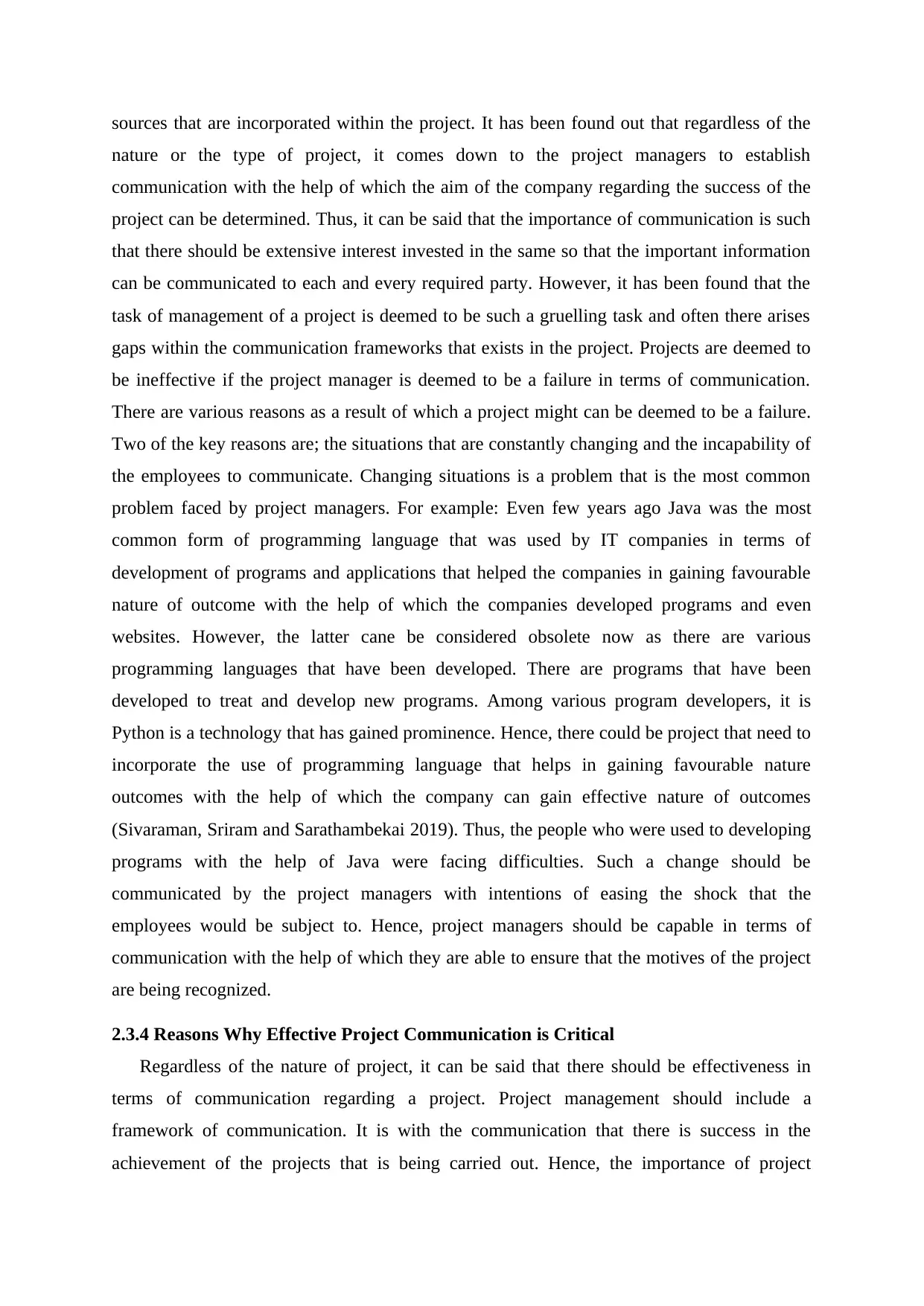
sources that are incorporated within the project. It has been found out that regardless of the
nature or the type of project, it comes down to the project managers to establish
communication with the help of which the aim of the company regarding the success of the
project can be determined. Thus, it can be said that the importance of communication is such
that there should be extensive interest invested in the same so that the important information
can be communicated to each and every required party. However, it has been found that the
task of management of a project is deemed to be such a gruelling task and often there arises
gaps within the communication frameworks that exists in the project. Projects are deemed to
be ineffective if the project manager is deemed to be a failure in terms of communication.
There are various reasons as a result of which a project might can be deemed to be a failure.
Two of the key reasons are; the situations that are constantly changing and the incapability of
the employees to communicate. Changing situations is a problem that is the most common
problem faced by project managers. For example: Even few years ago Java was the most
common form of programming language that was used by IT companies in terms of
development of programs and applications that helped the companies in gaining favourable
nature of outcome with the help of which the companies developed programs and even
websites. However, the latter cane be considered obsolete now as there are various
programming languages that have been developed. There are programs that have been
developed to treat and develop new programs. Among various program developers, it is
Python is a technology that has gained prominence. Hence, there could be project that need to
incorporate the use of programming language that helps in gaining favourable nature
outcomes with the help of which the company can gain effective nature of outcomes
(Sivaraman, Sriram and Sarathambekai 2019). Thus, the people who were used to developing
programs with the help of Java were facing difficulties. Such a change should be
communicated by the project managers with intentions of easing the shock that the
employees would be subject to. Hence, project managers should be capable in terms of
communication with the help of which they are able to ensure that the motives of the project
are being recognized.
2.3.4 Reasons Why Effective Project Communication is Critical
Regardless of the nature of project, it can be said that there should be effectiveness in
terms of communication regarding a project. Project management should include a
framework of communication. It is with the communication that there is success in the
achievement of the projects that is being carried out. Hence, the importance of project
nature or the type of project, it comes down to the project managers to establish
communication with the help of which the aim of the company regarding the success of the
project can be determined. Thus, it can be said that the importance of communication is such
that there should be extensive interest invested in the same so that the important information
can be communicated to each and every required party. However, it has been found that the
task of management of a project is deemed to be such a gruelling task and often there arises
gaps within the communication frameworks that exists in the project. Projects are deemed to
be ineffective if the project manager is deemed to be a failure in terms of communication.
There are various reasons as a result of which a project might can be deemed to be a failure.
Two of the key reasons are; the situations that are constantly changing and the incapability of
the employees to communicate. Changing situations is a problem that is the most common
problem faced by project managers. For example: Even few years ago Java was the most
common form of programming language that was used by IT companies in terms of
development of programs and applications that helped the companies in gaining favourable
nature of outcome with the help of which the companies developed programs and even
websites. However, the latter cane be considered obsolete now as there are various
programming languages that have been developed. There are programs that have been
developed to treat and develop new programs. Among various program developers, it is
Python is a technology that has gained prominence. Hence, there could be project that need to
incorporate the use of programming language that helps in gaining favourable nature
outcomes with the help of which the company can gain effective nature of outcomes
(Sivaraman, Sriram and Sarathambekai 2019). Thus, the people who were used to developing
programs with the help of Java were facing difficulties. Such a change should be
communicated by the project managers with intentions of easing the shock that the
employees would be subject to. Hence, project managers should be capable in terms of
communication with the help of which they are able to ensure that the motives of the project
are being recognized.
2.3.4 Reasons Why Effective Project Communication is Critical
Regardless of the nature of project, it can be said that there should be effectiveness in
terms of communication regarding a project. Project management should include a
framework of communication. It is with the communication that there is success in the
achievement of the projects that is being carried out. Hence, the importance of project
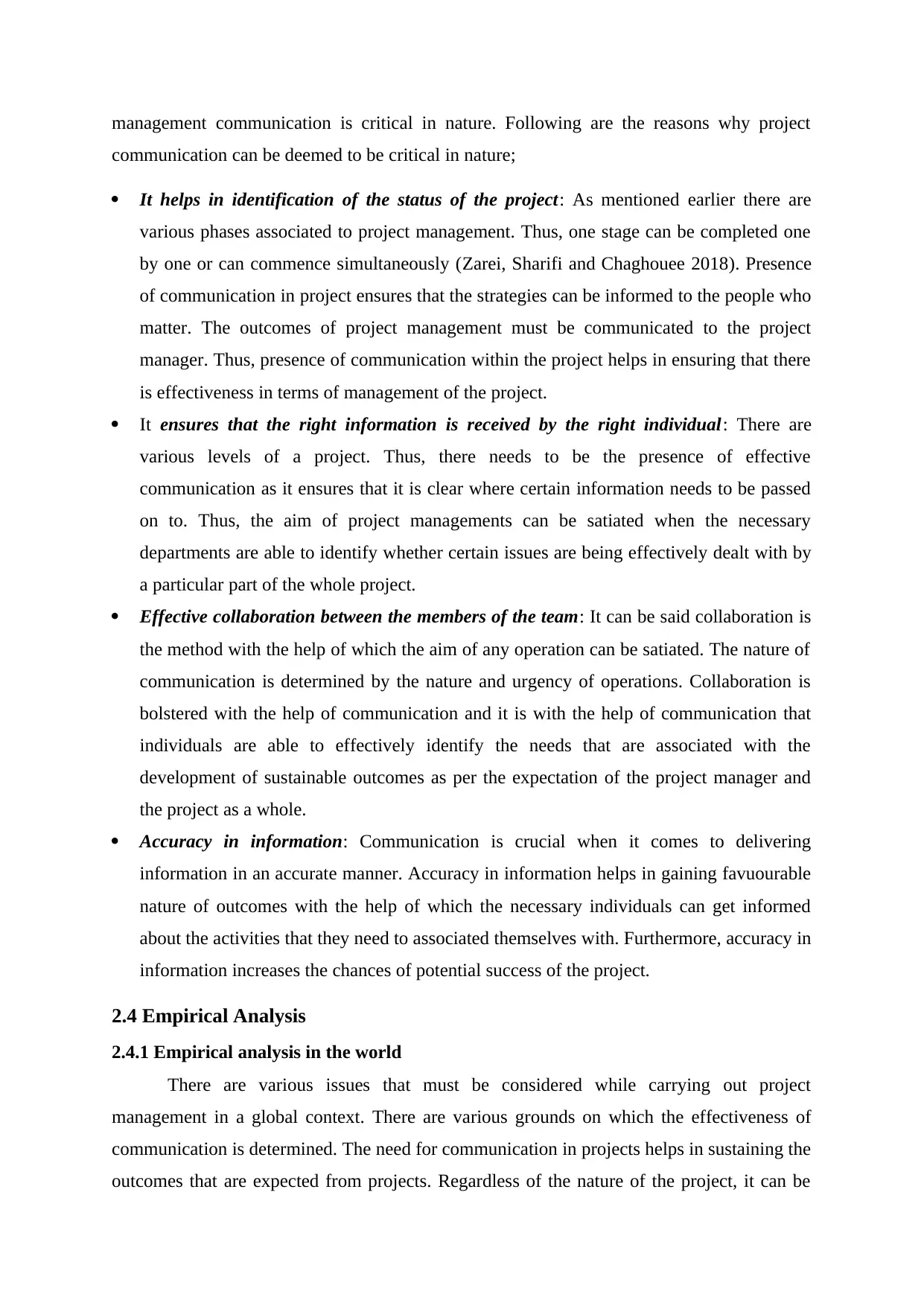
management communication is critical in nature. Following are the reasons why project
communication can be deemed to be critical in nature;
It helps in identification of the status of the project: As mentioned earlier there are
various phases associated to project management. Thus, one stage can be completed one
by one or can commence simultaneously (Zarei, Sharifi and Chaghouee 2018). Presence
of communication in project ensures that the strategies can be informed to the people who
matter. The outcomes of project management must be communicated to the project
manager. Thus, presence of communication within the project helps in ensuring that there
is effectiveness in terms of management of the project.
It ensures that the right information is received by the right individual: There are
various levels of a project. Thus, there needs to be the presence of effective
communication as it ensures that it is clear where certain information needs to be passed
on to. Thus, the aim of project managements can be satiated when the necessary
departments are able to identify whether certain issues are being effectively dealt with by
a particular part of the whole project.
Effective collaboration between the members of the team: It can be said collaboration is
the method with the help of which the aim of any operation can be satiated. The nature of
communication is determined by the nature and urgency of operations. Collaboration is
bolstered with the help of communication and it is with the help of communication that
individuals are able to effectively identify the needs that are associated with the
development of sustainable outcomes as per the expectation of the project manager and
the project as a whole.
Accuracy in information: Communication is crucial when it comes to delivering
information in an accurate manner. Accuracy in information helps in gaining favuourable
nature of outcomes with the help of which the necessary individuals can get informed
about the activities that they need to associated themselves with. Furthermore, accuracy in
information increases the chances of potential success of the project.
2.4 Empirical Analysis
2.4.1 Empirical analysis in the world
There are various issues that must be considered while carrying out project
management in a global context. There are various grounds on which the effectiveness of
communication is determined. The need for communication in projects helps in sustaining the
outcomes that are expected from projects. Regardless of the nature of the project, it can be
communication can be deemed to be critical in nature;
It helps in identification of the status of the project: As mentioned earlier there are
various phases associated to project management. Thus, one stage can be completed one
by one or can commence simultaneously (Zarei, Sharifi and Chaghouee 2018). Presence
of communication in project ensures that the strategies can be informed to the people who
matter. The outcomes of project management must be communicated to the project
manager. Thus, presence of communication within the project helps in ensuring that there
is effectiveness in terms of management of the project.
It ensures that the right information is received by the right individual: There are
various levels of a project. Thus, there needs to be the presence of effective
communication as it ensures that it is clear where certain information needs to be passed
on to. Thus, the aim of project managements can be satiated when the necessary
departments are able to identify whether certain issues are being effectively dealt with by
a particular part of the whole project.
Effective collaboration between the members of the team: It can be said collaboration is
the method with the help of which the aim of any operation can be satiated. The nature of
communication is determined by the nature and urgency of operations. Collaboration is
bolstered with the help of communication and it is with the help of communication that
individuals are able to effectively identify the needs that are associated with the
development of sustainable outcomes as per the expectation of the project manager and
the project as a whole.
Accuracy in information: Communication is crucial when it comes to delivering
information in an accurate manner. Accuracy in information helps in gaining favuourable
nature of outcomes with the help of which the necessary individuals can get informed
about the activities that they need to associated themselves with. Furthermore, accuracy in
information increases the chances of potential success of the project.
2.4 Empirical Analysis
2.4.1 Empirical analysis in the world
There are various issues that must be considered while carrying out project
management in a global context. There are various grounds on which the effectiveness of
communication is determined. The need for communication in projects helps in sustaining the
outcomes that are expected from projects. Regardless of the nature of the project, it can be
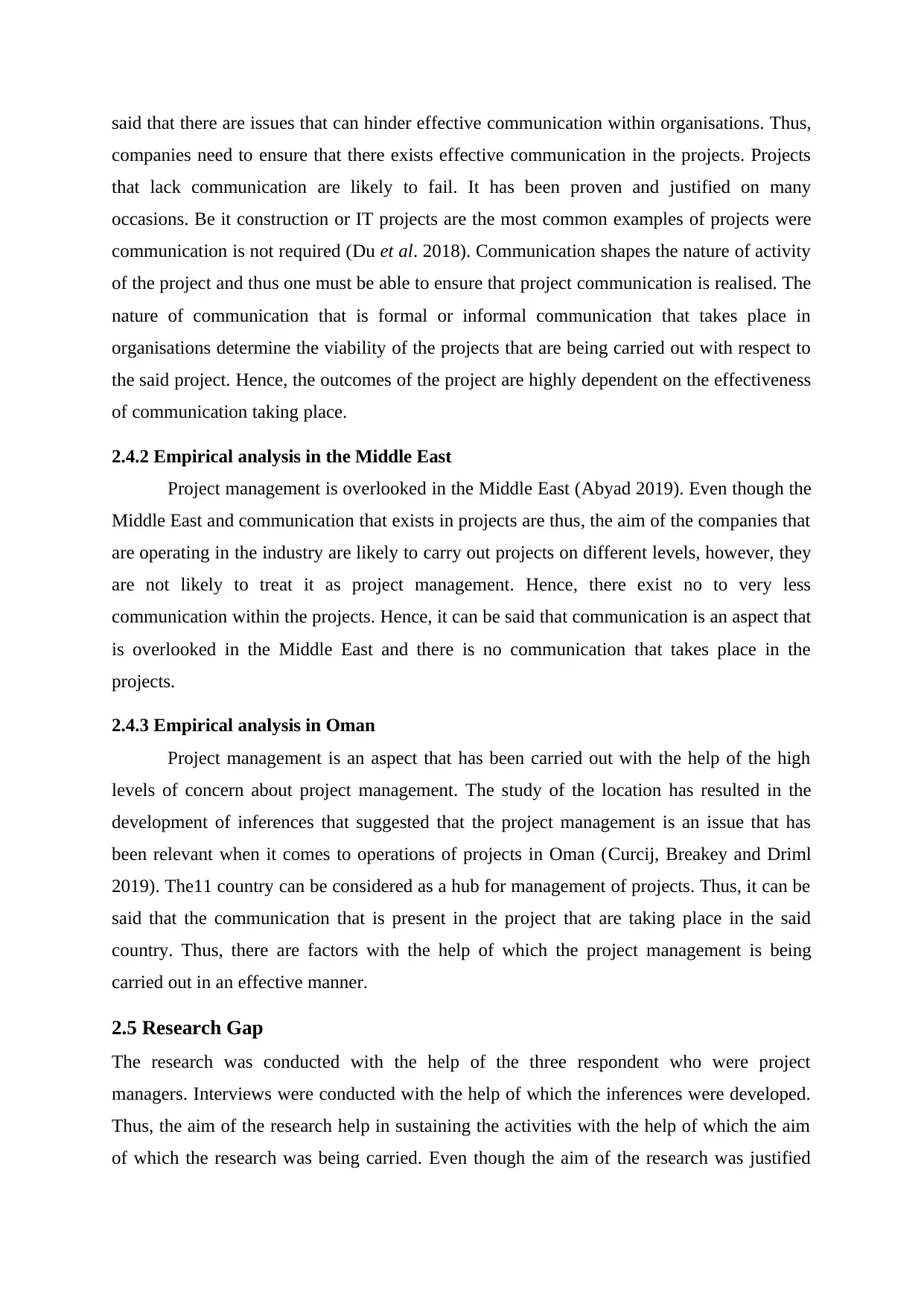
said that there are issues that can hinder effective communication within organisations. Thus,
companies need to ensure that there exists effective communication in the projects. Projects
that lack communication are likely to fail. It has been proven and justified on many
occasions. Be it construction or IT projects are the most common examples of projects were
communication is not required (Du et al. 2018). Communication shapes the nature of activity
of the project and thus one must be able to ensure that project communication is realised. The
nature of communication that is formal or informal communication that takes place in
organisations determine the viability of the projects that are being carried out with respect to
the said project. Hence, the outcomes of the project are highly dependent on the effectiveness
of communication taking place.
2.4.2 Empirical analysis in the Middle East
Project management is overlooked in the Middle East (Abyad 2019). Even though the
Middle East and communication that exists in projects are thus, the aim of the companies that
are operating in the industry are likely to carry out projects on different levels, however, they
are not likely to treat it as project management. Hence, there exist no to very less
communication within the projects. Hence, it can be said that communication is an aspect that
is overlooked in the Middle East and there is no communication that takes place in the
projects.
2.4.3 Empirical analysis in Oman
Project management is an aspect that has been carried out with the help of the high
levels of concern about project management. The study of the location has resulted in the
development of inferences that suggested that the project management is an issue that has
been relevant when it comes to operations of projects in Oman (Curcij, Breakey and Driml
2019). The11 country can be considered as a hub for management of projects. Thus, it can be
said that the communication that is present in the project that are taking place in the said
country. Thus, there are factors with the help of which the project management is being
carried out in an effective manner.
2.5 Research Gap
The research was conducted with the help of the three respondent who were project
managers. Interviews were conducted with the help of which the inferences were developed.
Thus, the aim of the research help in sustaining the activities with the help of which the aim
of which the research was being carried. Even though the aim of the research was justified
companies need to ensure that there exists effective communication in the projects. Projects
that lack communication are likely to fail. It has been proven and justified on many
occasions. Be it construction or IT projects are the most common examples of projects were
communication is not required (Du et al. 2018). Communication shapes the nature of activity
of the project and thus one must be able to ensure that project communication is realised. The
nature of communication that is formal or informal communication that takes place in
organisations determine the viability of the projects that are being carried out with respect to
the said project. Hence, the outcomes of the project are highly dependent on the effectiveness
of communication taking place.
2.4.2 Empirical analysis in the Middle East
Project management is overlooked in the Middle East (Abyad 2019). Even though the
Middle East and communication that exists in projects are thus, the aim of the companies that
are operating in the industry are likely to carry out projects on different levels, however, they
are not likely to treat it as project management. Hence, there exist no to very less
communication within the projects. Hence, it can be said that communication is an aspect that
is overlooked in the Middle East and there is no communication that takes place in the
projects.
2.4.3 Empirical analysis in Oman
Project management is an aspect that has been carried out with the help of the high
levels of concern about project management. The study of the location has resulted in the
development of inferences that suggested that the project management is an issue that has
been relevant when it comes to operations of projects in Oman (Curcij, Breakey and Driml
2019). The11 country can be considered as a hub for management of projects. Thus, it can be
said that the communication that is present in the project that are taking place in the said
country. Thus, there are factors with the help of which the project management is being
carried out in an effective manner.
2.5 Research Gap
The research was conducted with the help of the three respondent who were project
managers. Interviews were conducted with the help of which the inferences were developed.
Thus, the aim of the research help in sustaining the activities with the help of which the aim
of which the research was being carried. Even though the aim of the research was justified
Paraphrase This Document
Need a fresh take? Get an instant paraphrase of this document with our AI Paraphraser
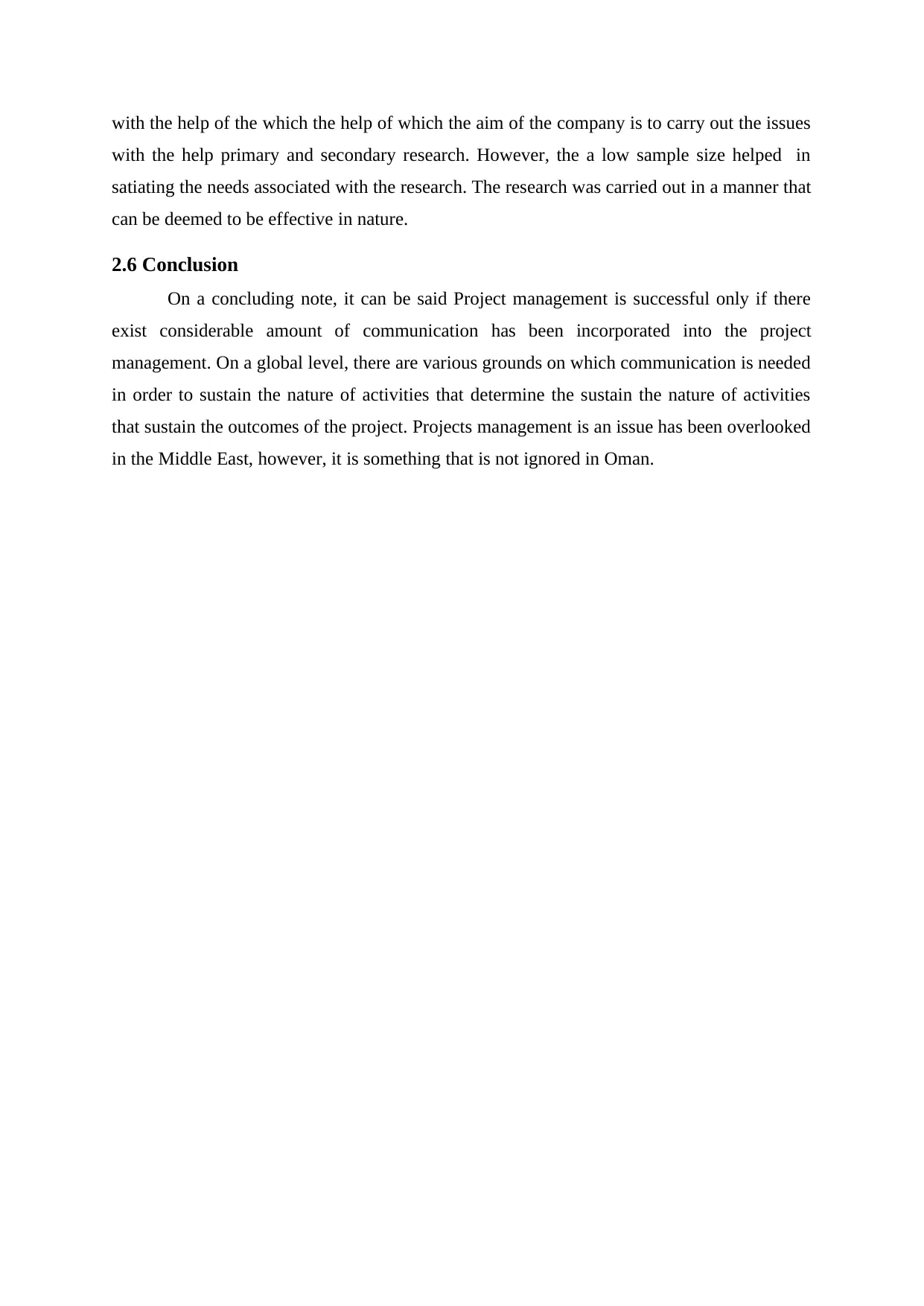
with the help of the which the help of which the aim of the company is to carry out the issues
with the help primary and secondary research. However, the a low sample size helped in
satiating the needs associated with the research. The research was carried out in a manner that
can be deemed to be effective in nature.
2.6 Conclusion
On a concluding note, it can be said Project management is successful only if there
exist considerable amount of communication has been incorporated into the project
management. On a global level, there are various grounds on which communication is needed
in order to sustain the nature of activities that determine the sustain the nature of activities
that sustain the outcomes of the project. Projects management is an issue has been overlooked
in the Middle East, however, it is something that is not ignored in Oman.
with the help primary and secondary research. However, the a low sample size helped in
satiating the needs associated with the research. The research was carried out in a manner that
can be deemed to be effective in nature.
2.6 Conclusion
On a concluding note, it can be said Project management is successful only if there
exist considerable amount of communication has been incorporated into the project
management. On a global level, there are various grounds on which communication is needed
in order to sustain the nature of activities that determine the sustain the nature of activities
that sustain the outcomes of the project. Projects management is an issue has been overlooked
in the Middle East, however, it is something that is not ignored in Oman.
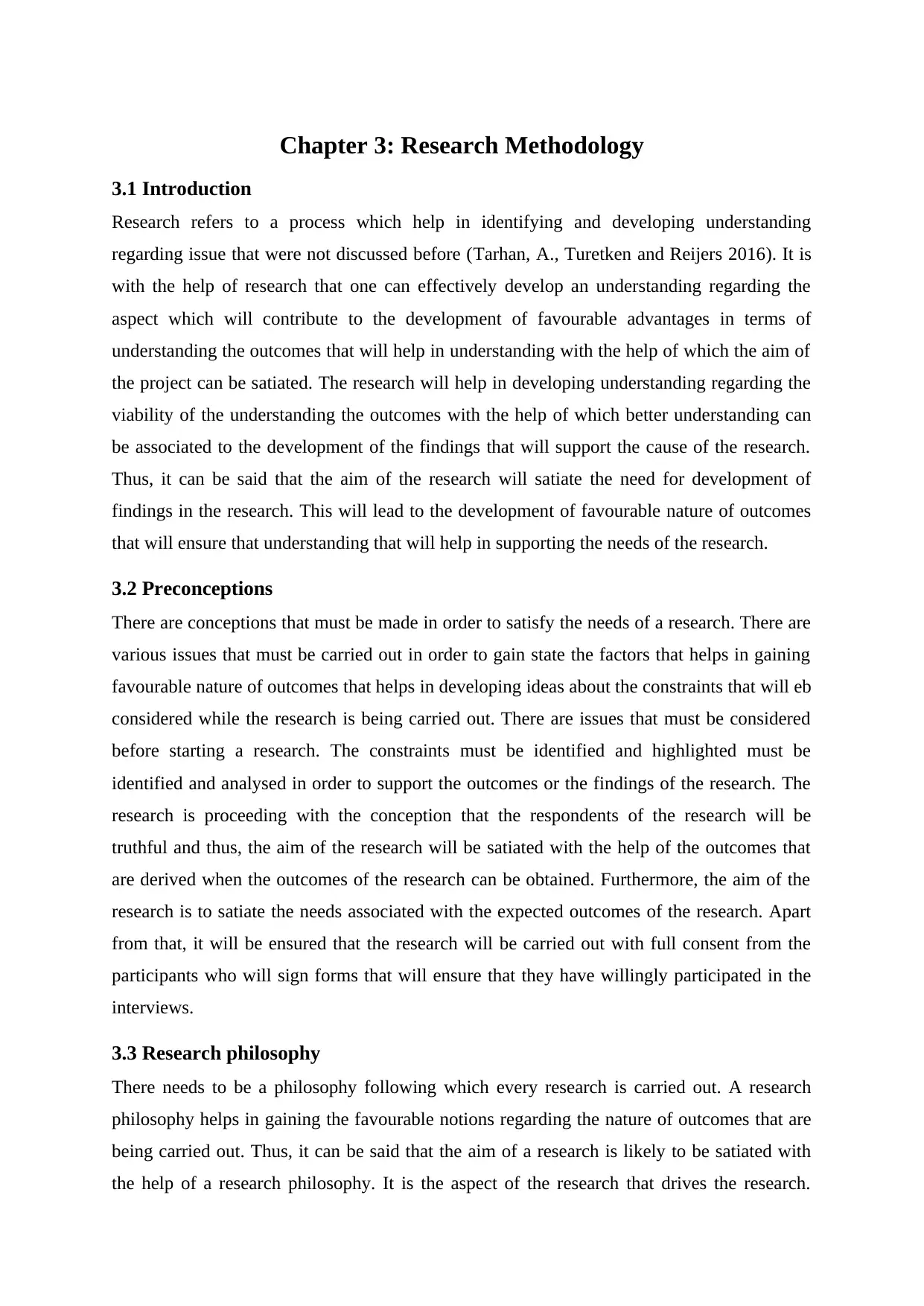
Chapter 3: Research Methodology
3.1 Introduction
Research refers to a process which help in identifying and developing understanding
regarding issue that were not discussed before (Tarhan, A., Turetken and Reijers 2016). It is
with the help of research that one can effectively develop an understanding regarding the
aspect which will contribute to the development of favourable advantages in terms of
understanding the outcomes that will help in understanding with the help of which the aim of
the project can be satiated. The research will help in developing understanding regarding the
viability of the understanding the outcomes with the help of which better understanding can
be associated to the development of the findings that will support the cause of the research.
Thus, it can be said that the aim of the research will satiate the need for development of
findings in the research. This will lead to the development of favourable nature of outcomes
that will ensure that understanding that will help in supporting the needs of the research.
3.2 Preconceptions
There are conceptions that must be made in order to satisfy the needs of a research. There are
various issues that must be carried out in order to gain state the factors that helps in gaining
favourable nature of outcomes that helps in developing ideas about the constraints that will eb
considered while the research is being carried out. There are issues that must be considered
before starting a research. The constraints must be identified and highlighted must be
identified and analysed in order to support the outcomes or the findings of the research. The
research is proceeding with the conception that the respondents of the research will be
truthful and thus, the aim of the research will be satiated with the help of the outcomes that
are derived when the outcomes of the research can be obtained. Furthermore, the aim of the
research is to satiate the needs associated with the expected outcomes of the research. Apart
from that, it will be ensured that the research will be carried out with full consent from the
participants who will sign forms that will ensure that they have willingly participated in the
interviews.
3.3 Research philosophy
There needs to be a philosophy following which every research is carried out. A research
philosophy helps in gaining the favourable notions regarding the nature of outcomes that are
being carried out. Thus, it can be said that the aim of a research is likely to be satiated with
the help of a research philosophy. It is the aspect of the research that drives the research.
3.1 Introduction
Research refers to a process which help in identifying and developing understanding
regarding issue that were not discussed before (Tarhan, A., Turetken and Reijers 2016). It is
with the help of research that one can effectively develop an understanding regarding the
aspect which will contribute to the development of favourable advantages in terms of
understanding the outcomes that will help in understanding with the help of which the aim of
the project can be satiated. The research will help in developing understanding regarding the
viability of the understanding the outcomes with the help of which better understanding can
be associated to the development of the findings that will support the cause of the research.
Thus, it can be said that the aim of the research will satiate the need for development of
findings in the research. This will lead to the development of favourable nature of outcomes
that will ensure that understanding that will help in supporting the needs of the research.
3.2 Preconceptions
There are conceptions that must be made in order to satisfy the needs of a research. There are
various issues that must be carried out in order to gain state the factors that helps in gaining
favourable nature of outcomes that helps in developing ideas about the constraints that will eb
considered while the research is being carried out. There are issues that must be considered
before starting a research. The constraints must be identified and highlighted must be
identified and analysed in order to support the outcomes or the findings of the research. The
research is proceeding with the conception that the respondents of the research will be
truthful and thus, the aim of the research will be satiated with the help of the outcomes that
are derived when the outcomes of the research can be obtained. Furthermore, the aim of the
research is to satiate the needs associated with the expected outcomes of the research. Apart
from that, it will be ensured that the research will be carried out with full consent from the
participants who will sign forms that will ensure that they have willingly participated in the
interviews.
3.3 Research philosophy
There needs to be a philosophy following which every research is carried out. A research
philosophy helps in gaining the favourable notions regarding the nature of outcomes that are
being carried out. Thus, it can be said that the aim of a research is likely to be satiated with
the help of a research philosophy. It is the aspect of the research that drives the research.
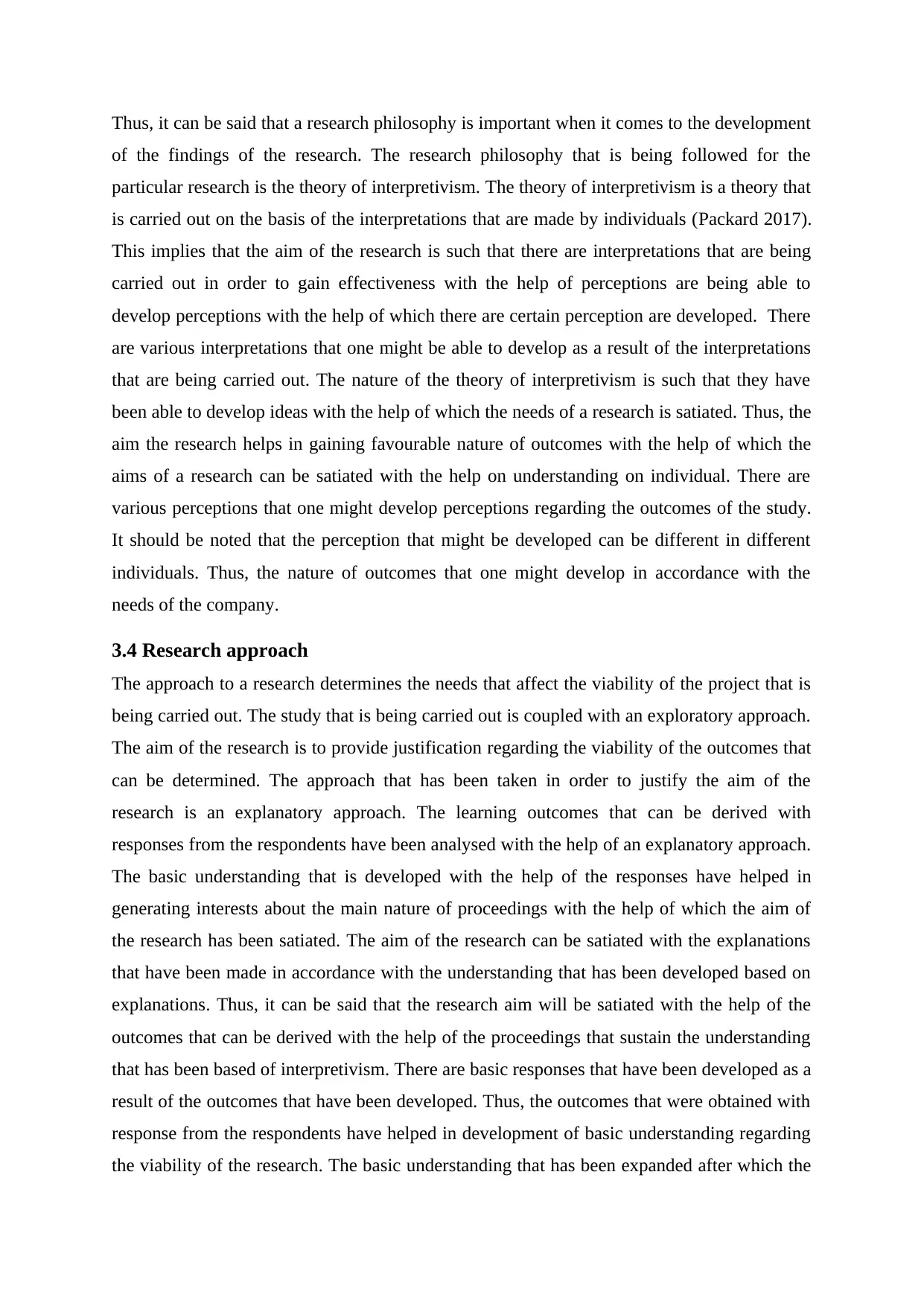
Thus, it can be said that a research philosophy is important when it comes to the development
of the findings of the research. The research philosophy that is being followed for the
particular research is the theory of interpretivism. The theory of interpretivism is a theory that
is carried out on the basis of the interpretations that are made by individuals (Packard 2017).
This implies that the aim of the research is such that there are interpretations that are being
carried out in order to gain effectiveness with the help of perceptions are being able to
develop perceptions with the help of which there are certain perception are developed. There
are various interpretations that one might be able to develop as a result of the interpretations
that are being carried out. The nature of the theory of interpretivism is such that they have
been able to develop ideas with the help of which the needs of a research is satiated. Thus, the
aim the research helps in gaining favourable nature of outcomes with the help of which the
aims of a research can be satiated with the help on understanding on individual. There are
various perceptions that one might develop perceptions regarding the outcomes of the study.
It should be noted that the perception that might be developed can be different in different
individuals. Thus, the nature of outcomes that one might develop in accordance with the
needs of the company.
3.4 Research approach
The approach to a research determines the needs that affect the viability of the project that is
being carried out. The study that is being carried out is coupled with an exploratory approach.
The aim of the research is to provide justification regarding the viability of the outcomes that
can be determined. The approach that has been taken in order to justify the aim of the
research is an explanatory approach. The learning outcomes that can be derived with
responses from the respondents have been analysed with the help of an explanatory approach.
The basic understanding that is developed with the help of the responses have helped in
generating interests about the main nature of proceedings with the help of which the aim of
the research has been satiated. The aim of the research can be satiated with the explanations
that have been made in accordance with the understanding that has been developed based on
explanations. Thus, it can be said that the research aim will be satiated with the help of the
outcomes that can be derived with the help of the proceedings that sustain the understanding
that has been based of interpretivism. There are basic responses that have been developed as a
result of the outcomes that have been developed. Thus, the outcomes that were obtained with
response from the respondents have helped in development of basic understanding regarding
the viability of the research. The basic understanding that has been expanded after which the
of the findings of the research. The research philosophy that is being followed for the
particular research is the theory of interpretivism. The theory of interpretivism is a theory that
is carried out on the basis of the interpretations that are made by individuals (Packard 2017).
This implies that the aim of the research is such that there are interpretations that are being
carried out in order to gain effectiveness with the help of perceptions are being able to
develop perceptions with the help of which there are certain perception are developed. There
are various interpretations that one might be able to develop as a result of the interpretations
that are being carried out. The nature of the theory of interpretivism is such that they have
been able to develop ideas with the help of which the needs of a research is satiated. Thus, the
aim the research helps in gaining favourable nature of outcomes with the help of which the
aims of a research can be satiated with the help on understanding on individual. There are
various perceptions that one might develop perceptions regarding the outcomes of the study.
It should be noted that the perception that might be developed can be different in different
individuals. Thus, the nature of outcomes that one might develop in accordance with the
needs of the company.
3.4 Research approach
The approach to a research determines the needs that affect the viability of the project that is
being carried out. The study that is being carried out is coupled with an exploratory approach.
The aim of the research is to provide justification regarding the viability of the outcomes that
can be determined. The approach that has been taken in order to justify the aim of the
research is an explanatory approach. The learning outcomes that can be derived with
responses from the respondents have been analysed with the help of an explanatory approach.
The basic understanding that is developed with the help of the responses have helped in
generating interests about the main nature of proceedings with the help of which the aim of
the research has been satiated. The aim of the research can be satiated with the explanations
that have been made in accordance with the understanding that has been developed based on
explanations. Thus, it can be said that the research aim will be satiated with the help of the
outcomes that can be derived with the help of the proceedings that sustain the understanding
that has been based of interpretivism. There are basic responses that have been developed as a
result of the outcomes that have been developed. Thus, the outcomes that were obtained with
response from the respondents have helped in development of basic understanding regarding
the viability of the research. The basic understanding that has been expanded after which the
Secure Best Marks with AI Grader
Need help grading? Try our AI Grader for instant feedback on your assignments.
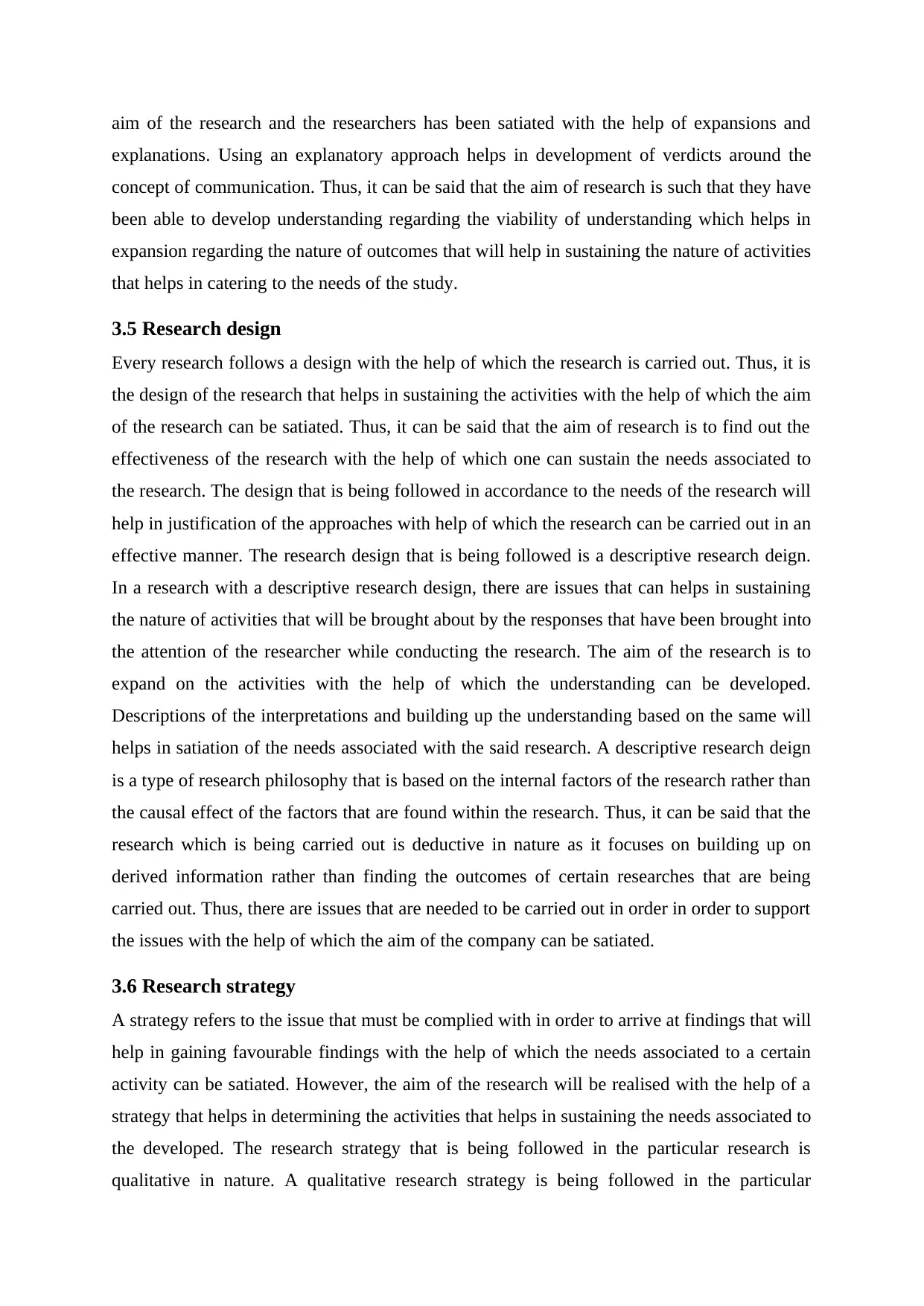
aim of the research and the researchers has been satiated with the help of expansions and
explanations. Using an explanatory approach helps in development of verdicts around the
concept of communication. Thus, it can be said that the aim of research is such that they have
been able to develop understanding regarding the viability of understanding which helps in
expansion regarding the nature of outcomes that will help in sustaining the nature of activities
that helps in catering to the needs of the study.
3.5 Research design
Every research follows a design with the help of which the research is carried out. Thus, it is
the design of the research that helps in sustaining the activities with the help of which the aim
of the research can be satiated. Thus, it can be said that the aim of research is to find out the
effectiveness of the research with the help of which one can sustain the needs associated to
the research. The design that is being followed in accordance to the needs of the research will
help in justification of the approaches with help of which the research can be carried out in an
effective manner. The research design that is being followed is a descriptive research deign.
In a research with a descriptive research design, there are issues that can helps in sustaining
the nature of activities that will be brought about by the responses that have been brought into
the attention of the researcher while conducting the research. The aim of the research is to
expand on the activities with the help of which the understanding can be developed.
Descriptions of the interpretations and building up the understanding based on the same will
helps in satiation of the needs associated with the said research. A descriptive research deign
is a type of research philosophy that is based on the internal factors of the research rather than
the causal effect of the factors that are found within the research. Thus, it can be said that the
research which is being carried out is deductive in nature as it focuses on building up on
derived information rather than finding the outcomes of certain researches that are being
carried out. Thus, there are issues that are needed to be carried out in order in order to support
the issues with the help of which the aim of the company can be satiated.
3.6 Research strategy
A strategy refers to the issue that must be complied with in order to arrive at findings that will
help in gaining favourable findings with the help of which the needs associated to a certain
activity can be satiated. However, the aim of the research will be realised with the help of a
strategy that helps in determining the activities that helps in sustaining the needs associated to
the developed. The research strategy that is being followed in the particular research is
qualitative in nature. A qualitative research strategy is being followed in the particular
explanations. Using an explanatory approach helps in development of verdicts around the
concept of communication. Thus, it can be said that the aim of research is such that they have
been able to develop understanding regarding the viability of understanding which helps in
expansion regarding the nature of outcomes that will help in sustaining the nature of activities
that helps in catering to the needs of the study.
3.5 Research design
Every research follows a design with the help of which the research is carried out. Thus, it is
the design of the research that helps in sustaining the activities with the help of which the aim
of the research can be satiated. Thus, it can be said that the aim of research is to find out the
effectiveness of the research with the help of which one can sustain the needs associated to
the research. The design that is being followed in accordance to the needs of the research will
help in justification of the approaches with help of which the research can be carried out in an
effective manner. The research design that is being followed is a descriptive research deign.
In a research with a descriptive research design, there are issues that can helps in sustaining
the nature of activities that will be brought about by the responses that have been brought into
the attention of the researcher while conducting the research. The aim of the research is to
expand on the activities with the help of which the understanding can be developed.
Descriptions of the interpretations and building up the understanding based on the same will
helps in satiation of the needs associated with the said research. A descriptive research deign
is a type of research philosophy that is based on the internal factors of the research rather than
the causal effect of the factors that are found within the research. Thus, it can be said that the
research which is being carried out is deductive in nature as it focuses on building up on
derived information rather than finding the outcomes of certain researches that are being
carried out. Thus, there are issues that are needed to be carried out in order in order to support
the issues with the help of which the aim of the company can be satiated.
3.6 Research strategy
A strategy refers to the issue that must be complied with in order to arrive at findings that will
help in gaining favourable findings with the help of which the needs associated to a certain
activity can be satiated. However, the aim of the research will be realised with the help of a
strategy that helps in determining the activities that helps in sustaining the needs associated to
the developed. The research strategy that is being followed in the particular research is
qualitative in nature. A qualitative research strategy is being followed in the particular
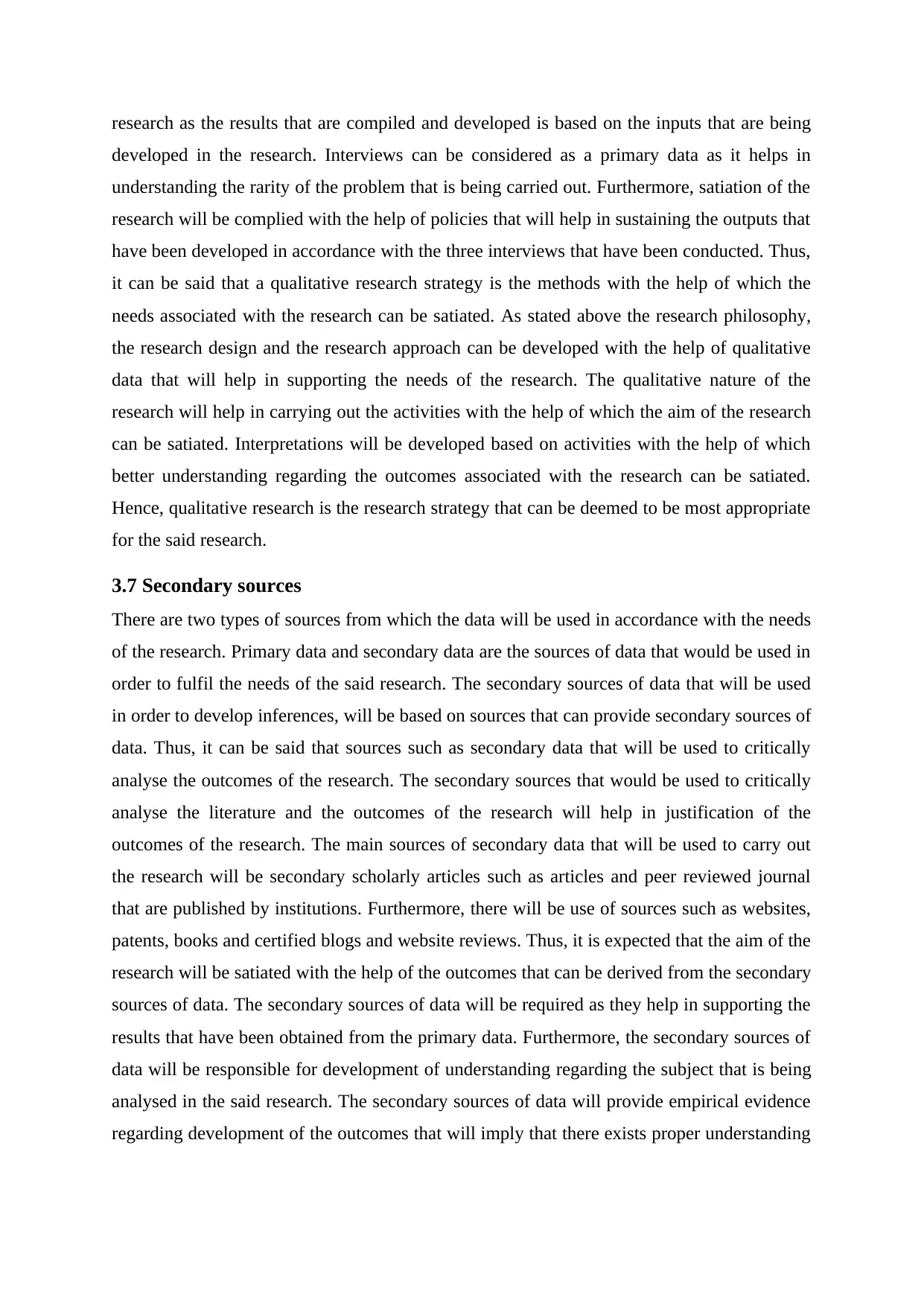
research as the results that are compiled and developed is based on the inputs that are being
developed in the research. Interviews can be considered as a primary data as it helps in
understanding the rarity of the problem that is being carried out. Furthermore, satiation of the
research will be complied with the help of policies that will help in sustaining the outputs that
have been developed in accordance with the three interviews that have been conducted. Thus,
it can be said that a qualitative research strategy is the methods with the help of which the
needs associated with the research can be satiated. As stated above the research philosophy,
the research design and the research approach can be developed with the help of qualitative
data that will help in supporting the needs of the research. The qualitative nature of the
research will help in carrying out the activities with the help of which the aim of the research
can be satiated. Interpretations will be developed based on activities with the help of which
better understanding regarding the outcomes associated with the research can be satiated.
Hence, qualitative research is the research strategy that can be deemed to be most appropriate
for the said research.
3.7 Secondary sources
There are two types of sources from which the data will be used in accordance with the needs
of the research. Primary data and secondary data are the sources of data that would be used in
order to fulfil the needs of the said research. The secondary sources of data that will be used
in order to develop inferences, will be based on sources that can provide secondary sources of
data. Thus, it can be said that sources such as secondary data that will be used to critically
analyse the outcomes of the research. The secondary sources that would be used to critically
analyse the literature and the outcomes of the research will help in justification of the
outcomes of the research. The main sources of secondary data that will be used to carry out
the research will be secondary scholarly articles such as articles and peer reviewed journal
that are published by institutions. Furthermore, there will be use of sources such as websites,
patents, books and certified blogs and website reviews. Thus, it is expected that the aim of the
research will be satiated with the help of the outcomes that can be derived from the secondary
sources of data. The secondary sources of data will be required as they help in supporting the
results that have been obtained from the primary data. Furthermore, the secondary sources of
data will be responsible for development of understanding regarding the subject that is being
analysed in the said research. The secondary sources of data will provide empirical evidence
regarding development of the outcomes that will imply that there exists proper understanding
developed in the research. Interviews can be considered as a primary data as it helps in
understanding the rarity of the problem that is being carried out. Furthermore, satiation of the
research will be complied with the help of policies that will help in sustaining the outputs that
have been developed in accordance with the three interviews that have been conducted. Thus,
it can be said that a qualitative research strategy is the methods with the help of which the
needs associated with the research can be satiated. As stated above the research philosophy,
the research design and the research approach can be developed with the help of qualitative
data that will help in supporting the needs of the research. The qualitative nature of the
research will help in carrying out the activities with the help of which the aim of the research
can be satiated. Interpretations will be developed based on activities with the help of which
better understanding regarding the outcomes associated with the research can be satiated.
Hence, qualitative research is the research strategy that can be deemed to be most appropriate
for the said research.
3.7 Secondary sources
There are two types of sources from which the data will be used in accordance with the needs
of the research. Primary data and secondary data are the sources of data that would be used in
order to fulfil the needs of the said research. The secondary sources of data that will be used
in order to develop inferences, will be based on sources that can provide secondary sources of
data. Thus, it can be said that sources such as secondary data that will be used to critically
analyse the outcomes of the research. The secondary sources that would be used to critically
analyse the literature and the outcomes of the research will help in justification of the
outcomes of the research. The main sources of secondary data that will be used to carry out
the research will be secondary scholarly articles such as articles and peer reviewed journal
that are published by institutions. Furthermore, there will be use of sources such as websites,
patents, books and certified blogs and website reviews. Thus, it is expected that the aim of the
research will be satiated with the help of the outcomes that can be derived from the secondary
sources of data. The secondary sources of data will be required as they help in supporting the
results that have been obtained from the primary data. Furthermore, the secondary sources of
data will be responsible for development of understanding regarding the subject that is being
analysed in the said research. The secondary sources of data will provide empirical evidence
regarding development of the outcomes that will imply that there exists proper understanding
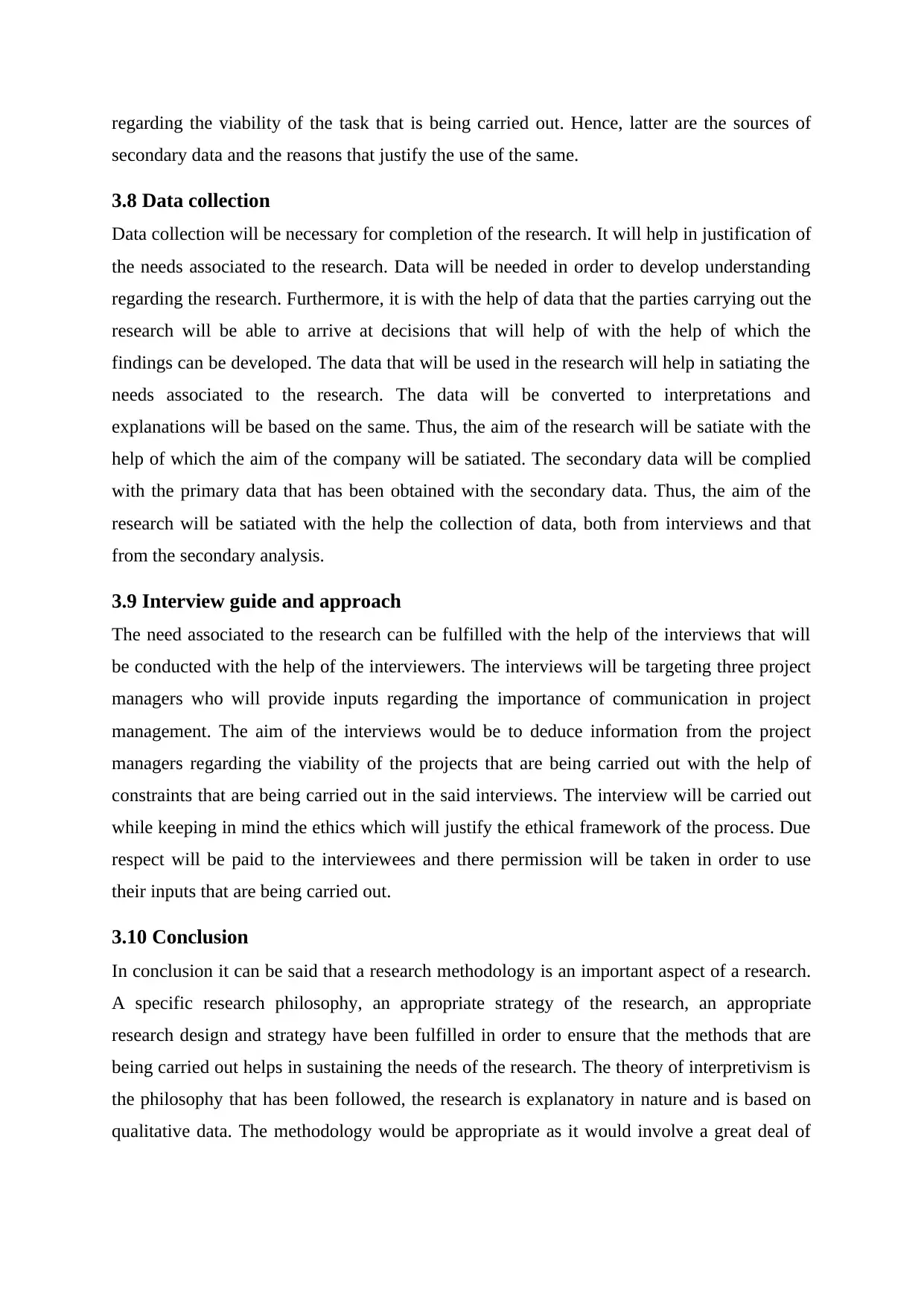
regarding the viability of the task that is being carried out. Hence, latter are the sources of
secondary data and the reasons that justify the use of the same.
3.8 Data collection
Data collection will be necessary for completion of the research. It will help in justification of
the needs associated to the research. Data will be needed in order to develop understanding
regarding the research. Furthermore, it is with the help of data that the parties carrying out the
research will be able to arrive at decisions that will help of with the help of which the
findings can be developed. The data that will be used in the research will help in satiating the
needs associated to the research. The data will be converted to interpretations and
explanations will be based on the same. Thus, the aim of the research will be satiate with the
help of which the aim of the company will be satiated. The secondary data will be complied
with the primary data that has been obtained with the secondary data. Thus, the aim of the
research will be satiated with the help the collection of data, both from interviews and that
from the secondary analysis.
3.9 Interview guide and approach
The need associated to the research can be fulfilled with the help of the interviews that will
be conducted with the help of the interviewers. The interviews will be targeting three project
managers who will provide inputs regarding the importance of communication in project
management. The aim of the interviews would be to deduce information from the project
managers regarding the viability of the projects that are being carried out with the help of
constraints that are being carried out in the said interviews. The interview will be carried out
while keeping in mind the ethics which will justify the ethical framework of the process. Due
respect will be paid to the interviewees and there permission will be taken in order to use
their inputs that are being carried out.
3.10 Conclusion
In conclusion it can be said that a research methodology is an important aspect of a research.
A specific research philosophy, an appropriate strategy of the research, an appropriate
research design and strategy have been fulfilled in order to ensure that the methods that are
being carried out helps in sustaining the needs of the research. The theory of interpretivism is
the philosophy that has been followed, the research is explanatory in nature and is based on
qualitative data. The methodology would be appropriate as it would involve a great deal of
secondary data and the reasons that justify the use of the same.
3.8 Data collection
Data collection will be necessary for completion of the research. It will help in justification of
the needs associated to the research. Data will be needed in order to develop understanding
regarding the research. Furthermore, it is with the help of data that the parties carrying out the
research will be able to arrive at decisions that will help of with the help of which the
findings can be developed. The data that will be used in the research will help in satiating the
needs associated to the research. The data will be converted to interpretations and
explanations will be based on the same. Thus, the aim of the research will be satiate with the
help of which the aim of the company will be satiated. The secondary data will be complied
with the primary data that has been obtained with the secondary data. Thus, the aim of the
research will be satiated with the help the collection of data, both from interviews and that
from the secondary analysis.
3.9 Interview guide and approach
The need associated to the research can be fulfilled with the help of the interviews that will
be conducted with the help of the interviewers. The interviews will be targeting three project
managers who will provide inputs regarding the importance of communication in project
management. The aim of the interviews would be to deduce information from the project
managers regarding the viability of the projects that are being carried out with the help of
constraints that are being carried out in the said interviews. The interview will be carried out
while keeping in mind the ethics which will justify the ethical framework of the process. Due
respect will be paid to the interviewees and there permission will be taken in order to use
their inputs that are being carried out.
3.10 Conclusion
In conclusion it can be said that a research methodology is an important aspect of a research.
A specific research philosophy, an appropriate strategy of the research, an appropriate
research design and strategy have been fulfilled in order to ensure that the methods that are
being carried out helps in sustaining the needs of the research. The theory of interpretivism is
the philosophy that has been followed, the research is explanatory in nature and is based on
qualitative data. The methodology would be appropriate as it would involve a great deal of
Paraphrase This Document
Need a fresh take? Get an instant paraphrase of this document with our AI Paraphraser

collaboration and interlinks between the sources of data that is the primary data and the
secondary data that is being used.
secondary data that is being used.
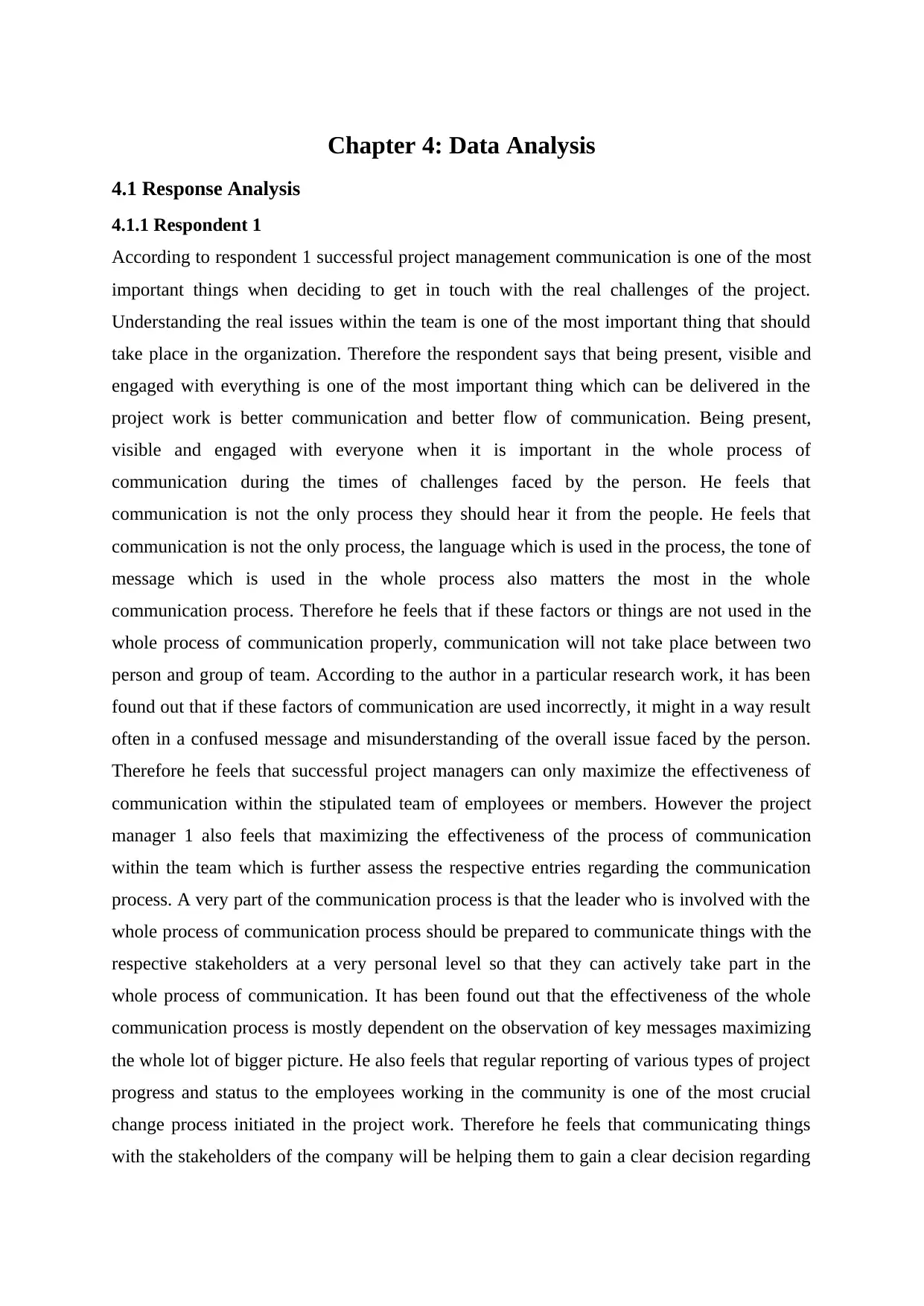
Chapter 4: Data Analysis
4.1 Response Analysis
4.1.1 Respondent 1
According to respondent 1 successful project management communication is one of the most
important things when deciding to get in touch with the real challenges of the project.
Understanding the real issues within the team is one of the most important thing that should
take place in the organization. Therefore the respondent says that being present, visible and
engaged with everything is one of the most important thing which can be delivered in the
project work is better communication and better flow of communication. Being present,
visible and engaged with everyone when it is important in the whole process of
communication during the times of challenges faced by the person. He feels that
communication is not the only process they should hear it from the people. He feels that
communication is not the only process, the language which is used in the process, the tone of
message which is used in the whole process also matters the most in the whole
communication process. Therefore he feels that if these factors or things are not used in the
whole process of communication properly, communication will not take place between two
person and group of team. According to the author in a particular research work, it has been
found out that if these factors of communication are used incorrectly, it might in a way result
often in a confused message and misunderstanding of the overall issue faced by the person.
Therefore he feels that successful project managers can only maximize the effectiveness of
communication within the stipulated team of employees or members. However the project
manager 1 also feels that maximizing the effectiveness of the process of communication
within the team which is further assess the respective entries regarding the communication
process. A very part of the communication process is that the leader who is involved with the
whole process of communication process should be prepared to communicate things with the
respective stakeholders at a very personal level so that they can actively take part in the
whole process of communication. It has been found out that the effectiveness of the whole
communication process is mostly dependent on the observation of key messages maximizing
the whole lot of bigger picture. He also feels that regular reporting of various types of project
progress and status to the employees working in the community is one of the most crucial
change process initiated in the project work. Therefore he feels that communicating things
with the stakeholders of the company will be helping them to gain a clear decision regarding
4.1 Response Analysis
4.1.1 Respondent 1
According to respondent 1 successful project management communication is one of the most
important things when deciding to get in touch with the real challenges of the project.
Understanding the real issues within the team is one of the most important thing that should
take place in the organization. Therefore the respondent says that being present, visible and
engaged with everything is one of the most important thing which can be delivered in the
project work is better communication and better flow of communication. Being present,
visible and engaged with everyone when it is important in the whole process of
communication during the times of challenges faced by the person. He feels that
communication is not the only process they should hear it from the people. He feels that
communication is not the only process, the language which is used in the process, the tone of
message which is used in the whole process also matters the most in the whole
communication process. Therefore he feels that if these factors or things are not used in the
whole process of communication properly, communication will not take place between two
person and group of team. According to the author in a particular research work, it has been
found out that if these factors of communication are used incorrectly, it might in a way result
often in a confused message and misunderstanding of the overall issue faced by the person.
Therefore he feels that successful project managers can only maximize the effectiveness of
communication within the stipulated team of employees or members. However the project
manager 1 also feels that maximizing the effectiveness of the process of communication
within the team which is further assess the respective entries regarding the communication
process. A very part of the communication process is that the leader who is involved with the
whole process of communication process should be prepared to communicate things with the
respective stakeholders at a very personal level so that they can actively take part in the
whole process of communication. It has been found out that the effectiveness of the whole
communication process is mostly dependent on the observation of key messages maximizing
the whole lot of bigger picture. He also feels that regular reporting of various types of project
progress and status to the employees working in the community is one of the most crucial
change process initiated in the project work. Therefore he feels that communicating things
with the stakeholders of the company will be helping them to gain a clear decision regarding
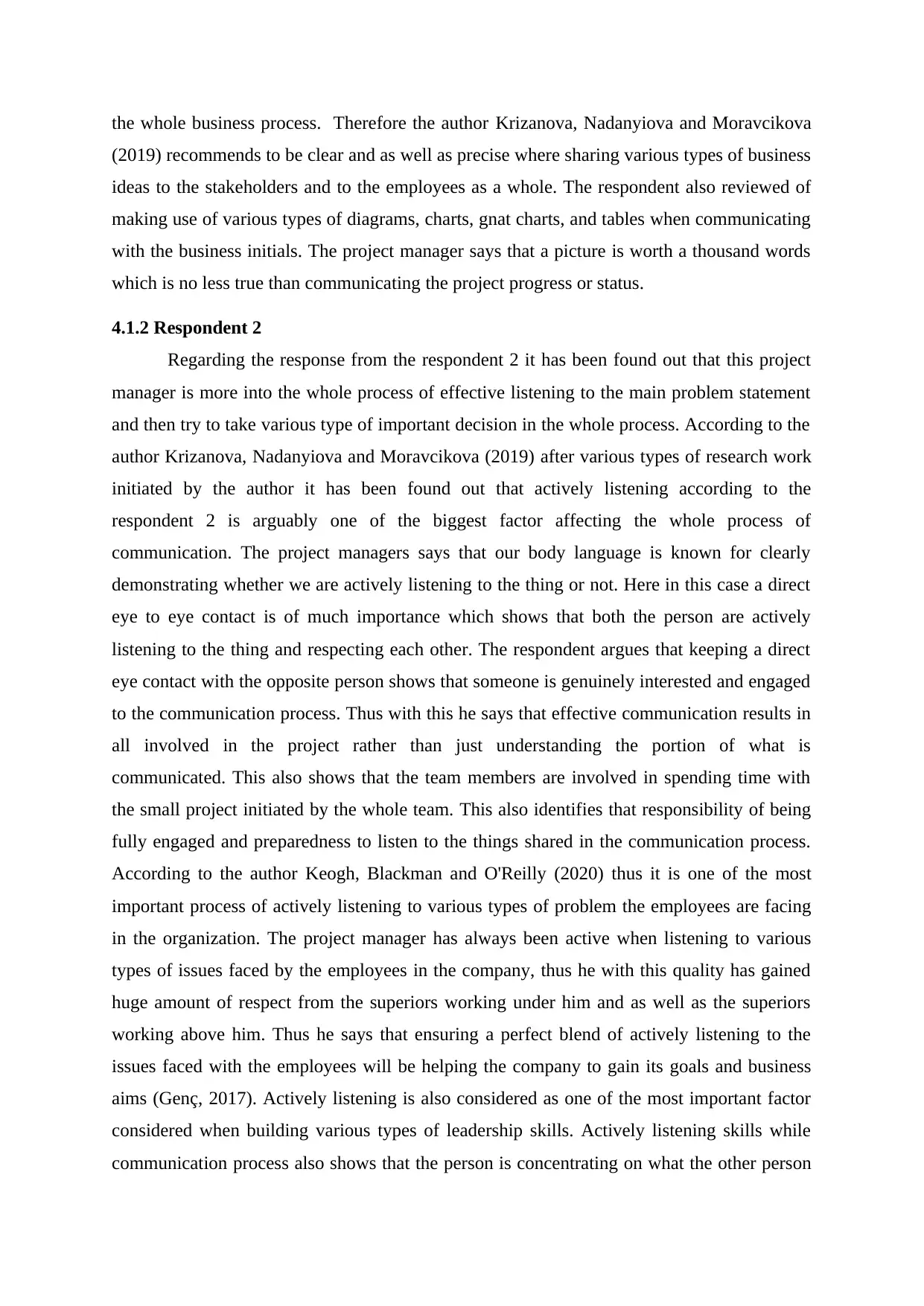
the whole business process. Therefore the author Krizanova, Nadanyiova and Moravcikova
(2019) recommends to be clear and as well as precise where sharing various types of business
ideas to the stakeholders and to the employees as a whole. The respondent also reviewed of
making use of various types of diagrams, charts, gnat charts, and tables when communicating
with the business initials. The project manager says that a picture is worth a thousand words
which is no less true than communicating the project progress or status.
4.1.2 Respondent 2
Regarding the response from the respondent 2 it has been found out that this project
manager is more into the whole process of effective listening to the main problem statement
and then try to take various type of important decision in the whole process. According to the
author Krizanova, Nadanyiova and Moravcikova (2019) after various types of research work
initiated by the author it has been found out that actively listening according to the
respondent 2 is arguably one of the biggest factor affecting the whole process of
communication. The project managers says that our body language is known for clearly
demonstrating whether we are actively listening to the thing or not. Here in this case a direct
eye to eye contact is of much importance which shows that both the person are actively
listening to the thing and respecting each other. The respondent argues that keeping a direct
eye contact with the opposite person shows that someone is genuinely interested and engaged
to the communication process. Thus with this he says that effective communication results in
all involved in the project rather than just understanding the portion of what is
communicated. This also shows that the team members are involved in spending time with
the small project initiated by the whole team. This also identifies that responsibility of being
fully engaged and preparedness to listen to the things shared in the communication process.
According to the author Keogh, Blackman and O'Reilly (2020) thus it is one of the most
important process of actively listening to various types of problem the employees are facing
in the organization. The project manager has always been active when listening to various
types of issues faced by the employees in the company, thus he with this quality has gained
huge amount of respect from the superiors working under him and as well as the superiors
working above him. Thus he says that ensuring a perfect blend of actively listening to the
issues faced with the employees will be helping the company to gain its goals and business
aims (Genç, 2017). Actively listening is also considered as one of the most important factor
considered when building various types of leadership skills. Actively listening skills while
communication process also shows that the person is concentrating on what the other person
(2019) recommends to be clear and as well as precise where sharing various types of business
ideas to the stakeholders and to the employees as a whole. The respondent also reviewed of
making use of various types of diagrams, charts, gnat charts, and tables when communicating
with the business initials. The project manager says that a picture is worth a thousand words
which is no less true than communicating the project progress or status.
4.1.2 Respondent 2
Regarding the response from the respondent 2 it has been found out that this project
manager is more into the whole process of effective listening to the main problem statement
and then try to take various type of important decision in the whole process. According to the
author Krizanova, Nadanyiova and Moravcikova (2019) after various types of research work
initiated by the author it has been found out that actively listening according to the
respondent 2 is arguably one of the biggest factor affecting the whole process of
communication. The project managers says that our body language is known for clearly
demonstrating whether we are actively listening to the thing or not. Here in this case a direct
eye to eye contact is of much importance which shows that both the person are actively
listening to the thing and respecting each other. The respondent argues that keeping a direct
eye contact with the opposite person shows that someone is genuinely interested and engaged
to the communication process. Thus with this he says that effective communication results in
all involved in the project rather than just understanding the portion of what is
communicated. This also shows that the team members are involved in spending time with
the small project initiated by the whole team. This also identifies that responsibility of being
fully engaged and preparedness to listen to the things shared in the communication process.
According to the author Keogh, Blackman and O'Reilly (2020) thus it is one of the most
important process of actively listening to various types of problem the employees are facing
in the organization. The project manager has always been active when listening to various
types of issues faced by the employees in the company, thus he with this quality has gained
huge amount of respect from the superiors working under him and as well as the superiors
working above him. Thus he says that ensuring a perfect blend of actively listening to the
issues faced with the employees will be helping the company to gain its goals and business
aims (Genç, 2017). Actively listening is also considered as one of the most important factor
considered when building various types of leadership skills. Actively listening skills while
communication process also shows that the person is concentrating on what the other person
Secure Best Marks with AI Grader
Need help grading? Try our AI Grader for instant feedback on your assignments.
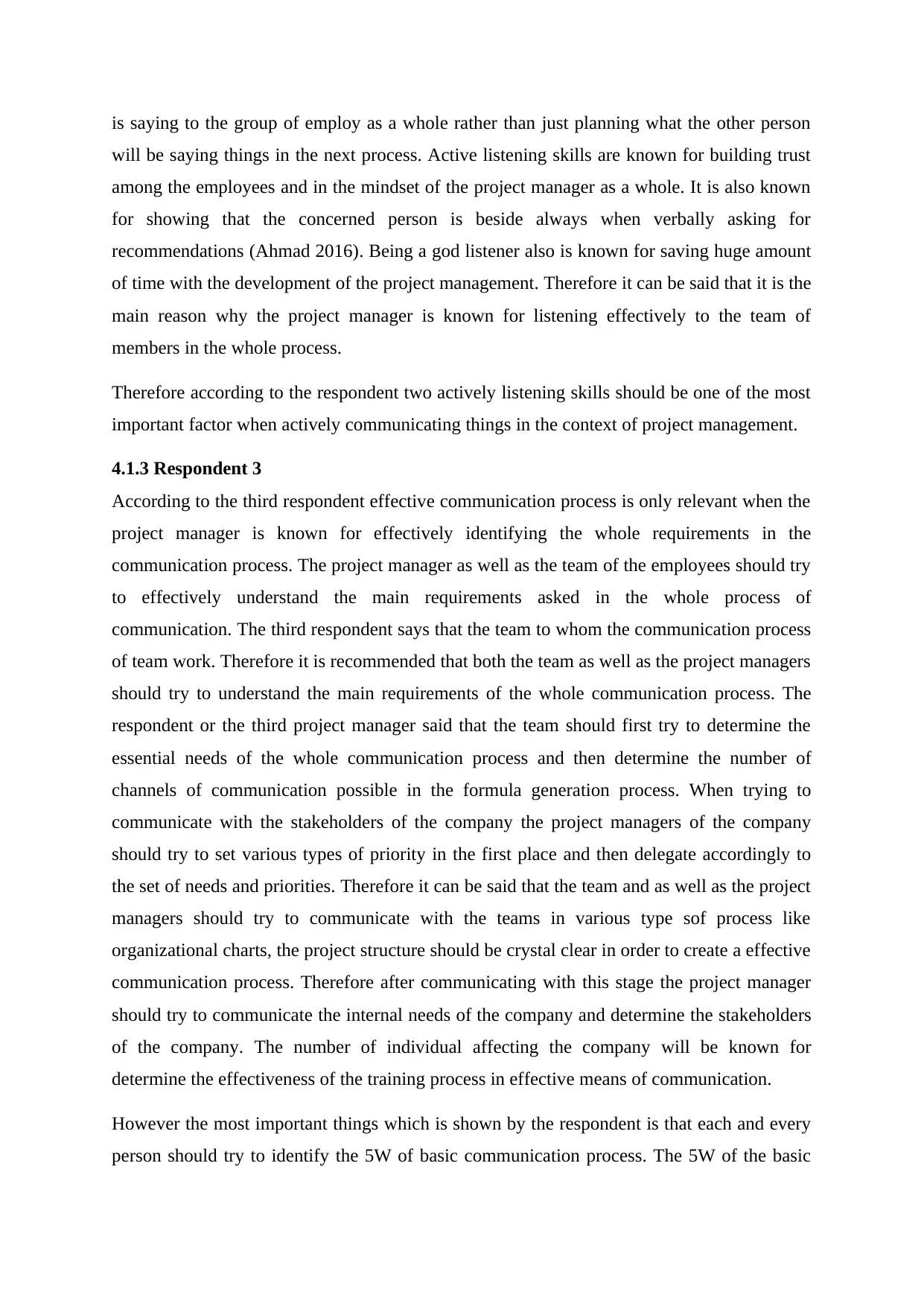
is saying to the group of employ as a whole rather than just planning what the other person
will be saying things in the next process. Active listening skills are known for building trust
among the employees and in the mindset of the project manager as a whole. It is also known
for showing that the concerned person is beside always when verbally asking for
recommendations (Ahmad 2016). Being a god listener also is known for saving huge amount
of time with the development of the project management. Therefore it can be said that it is the
main reason why the project manager is known for listening effectively to the team of
members in the whole process.
Therefore according to the respondent two actively listening skills should be one of the most
important factor when actively communicating things in the context of project management.
4.1.3 Respondent 3
According to the third respondent effective communication process is only relevant when the
project manager is known for effectively identifying the whole requirements in the
communication process. The project manager as well as the team of the employees should try
to effectively understand the main requirements asked in the whole process of
communication. The third respondent says that the team to whom the communication process
of team work. Therefore it is recommended that both the team as well as the project managers
should try to understand the main requirements of the whole communication process. The
respondent or the third project manager said that the team should first try to determine the
essential needs of the whole communication process and then determine the number of
channels of communication possible in the formula generation process. When trying to
communicate with the stakeholders of the company the project managers of the company
should try to set various types of priority in the first place and then delegate accordingly to
the set of needs and priorities. Therefore it can be said that the team and as well as the project
managers should try to communicate with the teams in various type sof process like
organizational charts, the project structure should be crystal clear in order to create a effective
communication process. Therefore after communicating with this stage the project manager
should try to communicate the internal needs of the company and determine the stakeholders
of the company. The number of individual affecting the company will be known for
determine the effectiveness of the training process in effective means of communication.
However the most important things which is shown by the respondent is that each and every
person should try to identify the 5W of basic communication process. The 5W of the basic
will be saying things in the next process. Active listening skills are known for building trust
among the employees and in the mindset of the project manager as a whole. It is also known
for showing that the concerned person is beside always when verbally asking for
recommendations (Ahmad 2016). Being a god listener also is known for saving huge amount
of time with the development of the project management. Therefore it can be said that it is the
main reason why the project manager is known for listening effectively to the team of
members in the whole process.
Therefore according to the respondent two actively listening skills should be one of the most
important factor when actively communicating things in the context of project management.
4.1.3 Respondent 3
According to the third respondent effective communication process is only relevant when the
project manager is known for effectively identifying the whole requirements in the
communication process. The project manager as well as the team of the employees should try
to effectively understand the main requirements asked in the whole process of
communication. The third respondent says that the team to whom the communication process
of team work. Therefore it is recommended that both the team as well as the project managers
should try to understand the main requirements of the whole communication process. The
respondent or the third project manager said that the team should first try to determine the
essential needs of the whole communication process and then determine the number of
channels of communication possible in the formula generation process. When trying to
communicate with the stakeholders of the company the project managers of the company
should try to set various types of priority in the first place and then delegate accordingly to
the set of needs and priorities. Therefore it can be said that the team and as well as the project
managers should try to communicate with the teams in various type sof process like
organizational charts, the project structure should be crystal clear in order to create a effective
communication process. Therefore after communicating with this stage the project manager
should try to communicate the internal needs of the company and determine the stakeholders
of the company. The number of individual affecting the company will be known for
determine the effectiveness of the training process in effective means of communication.
However the most important things which is shown by the respondent is that each and every
person should try to identify the 5W of basic communication process. The 5W of the basic
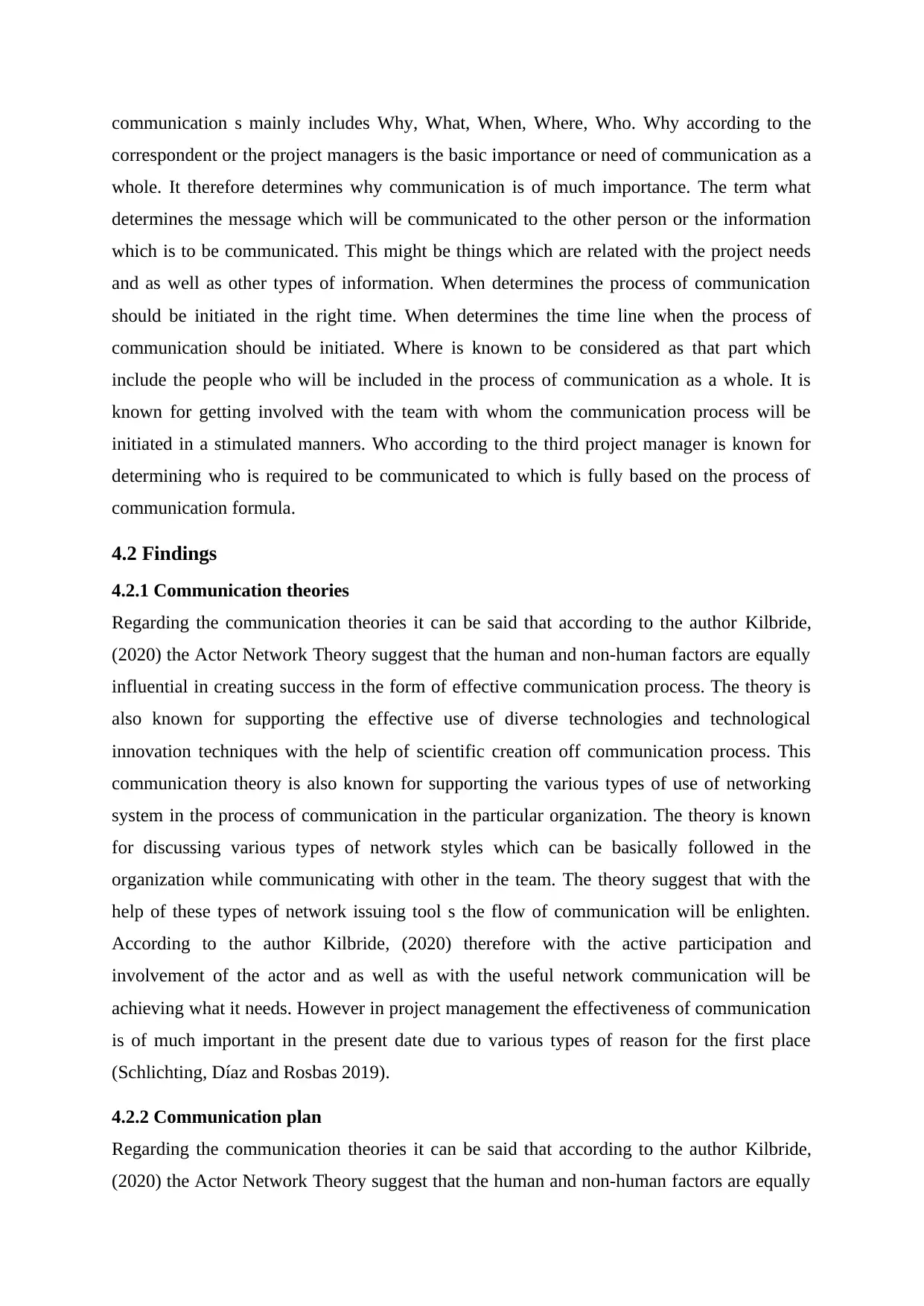
communication s mainly includes Why, What, When, Where, Who. Why according to the
correspondent or the project managers is the basic importance or need of communication as a
whole. It therefore determines why communication is of much importance. The term what
determines the message which will be communicated to the other person or the information
which is to be communicated. This might be things which are related with the project needs
and as well as other types of information. When determines the process of communication
should be initiated in the right time. When determines the time line when the process of
communication should be initiated. Where is known to be considered as that part which
include the people who will be included in the process of communication as a whole. It is
known for getting involved with the team with whom the communication process will be
initiated in a stimulated manners. Who according to the third project manager is known for
determining who is required to be communicated to which is fully based on the process of
communication formula.
4.2 Findings
4.2.1 Communication theories
Regarding the communication theories it can be said that according to the author Kilbride,
(2020) the Actor Network Theory suggest that the human and non-human factors are equally
influential in creating success in the form of effective communication process. The theory is
also known for supporting the effective use of diverse technologies and technological
innovation techniques with the help of scientific creation off communication process. This
communication theory is also known for supporting the various types of use of networking
system in the process of communication in the particular organization. The theory is known
for discussing various types of network styles which can be basically followed in the
organization while communicating with other in the team. The theory suggest that with the
help of these types of network issuing tool s the flow of communication will be enlighten.
According to the author Kilbride, (2020) therefore with the active participation and
involvement of the actor and as well as with the useful network communication will be
achieving what it needs. However in project management the effectiveness of communication
is of much important in the present date due to various types of reason for the first place
(Schlichting, Díaz and Rosbas 2019).
4.2.2 Communication plan
Regarding the communication theories it can be said that according to the author Kilbride,
(2020) the Actor Network Theory suggest that the human and non-human factors are equally
correspondent or the project managers is the basic importance or need of communication as a
whole. It therefore determines why communication is of much importance. The term what
determines the message which will be communicated to the other person or the information
which is to be communicated. This might be things which are related with the project needs
and as well as other types of information. When determines the process of communication
should be initiated in the right time. When determines the time line when the process of
communication should be initiated. Where is known to be considered as that part which
include the people who will be included in the process of communication as a whole. It is
known for getting involved with the team with whom the communication process will be
initiated in a stimulated manners. Who according to the third project manager is known for
determining who is required to be communicated to which is fully based on the process of
communication formula.
4.2 Findings
4.2.1 Communication theories
Regarding the communication theories it can be said that according to the author Kilbride,
(2020) the Actor Network Theory suggest that the human and non-human factors are equally
influential in creating success in the form of effective communication process. The theory is
also known for supporting the effective use of diverse technologies and technological
innovation techniques with the help of scientific creation off communication process. This
communication theory is also known for supporting the various types of use of networking
system in the process of communication in the particular organization. The theory is known
for discussing various types of network styles which can be basically followed in the
organization while communicating with other in the team. The theory suggest that with the
help of these types of network issuing tool s the flow of communication will be enlighten.
According to the author Kilbride, (2020) therefore with the active participation and
involvement of the actor and as well as with the useful network communication will be
achieving what it needs. However in project management the effectiveness of communication
is of much important in the present date due to various types of reason for the first place
(Schlichting, Díaz and Rosbas 2019).
4.2.2 Communication plan
Regarding the communication theories it can be said that according to the author Kilbride,
(2020) the Actor Network Theory suggest that the human and non-human factors are equally
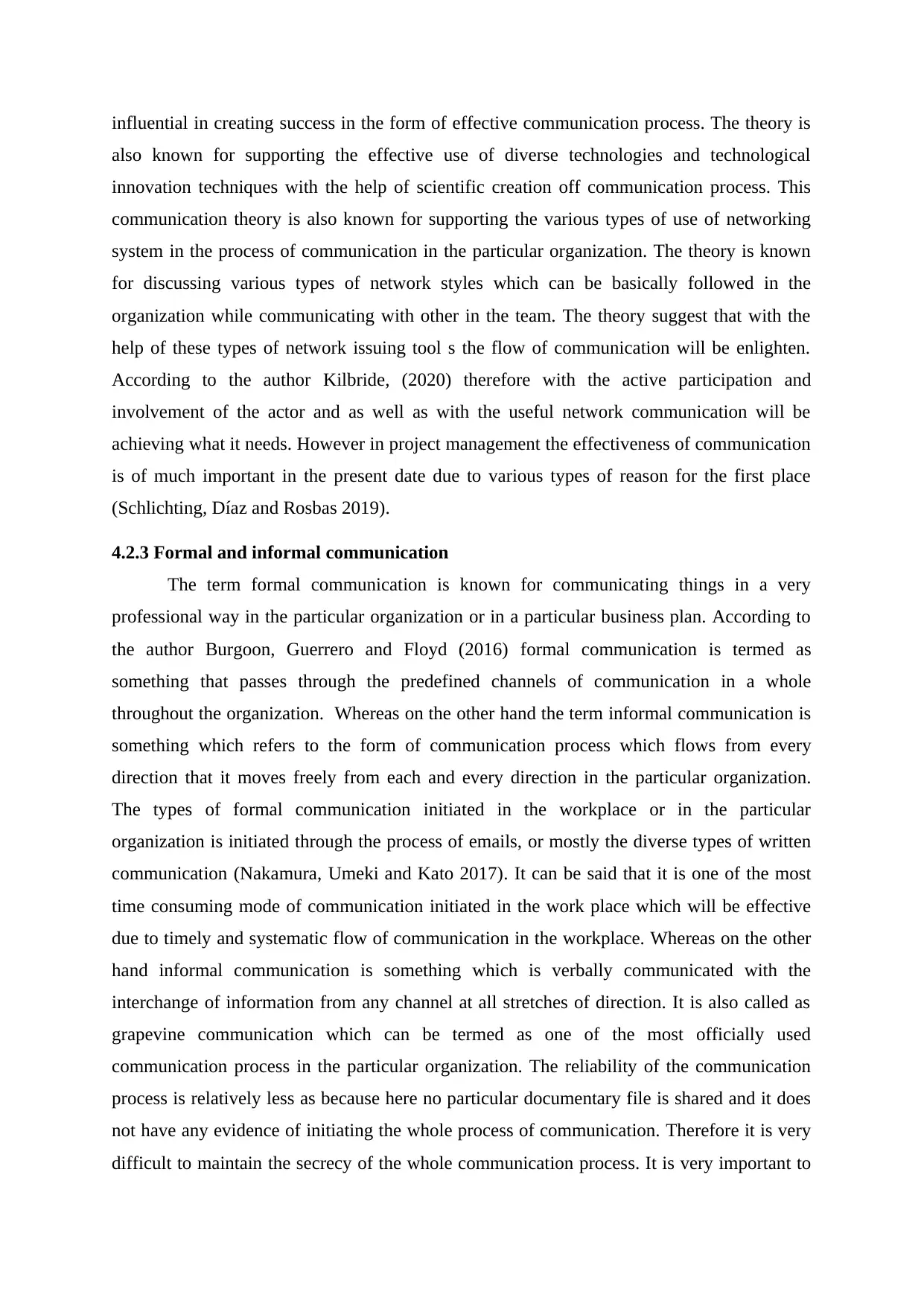
influential in creating success in the form of effective communication process. The theory is
also known for supporting the effective use of diverse technologies and technological
innovation techniques with the help of scientific creation off communication process. This
communication theory is also known for supporting the various types of use of networking
system in the process of communication in the particular organization. The theory is known
for discussing various types of network styles which can be basically followed in the
organization while communicating with other in the team. The theory suggest that with the
help of these types of network issuing tool s the flow of communication will be enlighten.
According to the author Kilbride, (2020) therefore with the active participation and
involvement of the actor and as well as with the useful network communication will be
achieving what it needs. However in project management the effectiveness of communication
is of much important in the present date due to various types of reason for the first place
(Schlichting, Díaz and Rosbas 2019).
4.2.3 Formal and informal communication
The term formal communication is known for communicating things in a very
professional way in the particular organization or in a particular business plan. According to
the author Burgoon, Guerrero and Floyd (2016) formal communication is termed as
something that passes through the predefined channels of communication in a whole
throughout the organization. Whereas on the other hand the term informal communication is
something which refers to the form of communication process which flows from every
direction that it moves freely from each and every direction in the particular organization.
The types of formal communication initiated in the workplace or in the particular
organization is initiated through the process of emails, or mostly the diverse types of written
communication (Nakamura, Umeki and Kato 2017). It can be said that it is one of the most
time consuming mode of communication initiated in the work place which will be effective
due to timely and systematic flow of communication in the workplace. Whereas on the other
hand informal communication is something which is verbally communicated with the
interchange of information from any channel at all stretches of direction. It is also called as
grapevine communication which can be termed as one of the most officially used
communication process in the particular organization. The reliability of the communication
process is relatively less as because here no particular documentary file is shared and it does
not have any evidence of initiating the whole process of communication. Therefore it is very
difficult to maintain the secrecy of the whole communication process. It is very important to
also known for supporting the effective use of diverse technologies and technological
innovation techniques with the help of scientific creation off communication process. This
communication theory is also known for supporting the various types of use of networking
system in the process of communication in the particular organization. The theory is known
for discussing various types of network styles which can be basically followed in the
organization while communicating with other in the team. The theory suggest that with the
help of these types of network issuing tool s the flow of communication will be enlighten.
According to the author Kilbride, (2020) therefore with the active participation and
involvement of the actor and as well as with the useful network communication will be
achieving what it needs. However in project management the effectiveness of communication
is of much important in the present date due to various types of reason for the first place
(Schlichting, Díaz and Rosbas 2019).
4.2.3 Formal and informal communication
The term formal communication is known for communicating things in a very
professional way in the particular organization or in a particular business plan. According to
the author Burgoon, Guerrero and Floyd (2016) formal communication is termed as
something that passes through the predefined channels of communication in a whole
throughout the organization. Whereas on the other hand the term informal communication is
something which refers to the form of communication process which flows from every
direction that it moves freely from each and every direction in the particular organization.
The types of formal communication initiated in the workplace or in the particular
organization is initiated through the process of emails, or mostly the diverse types of written
communication (Nakamura, Umeki and Kato 2017). It can be said that it is one of the most
time consuming mode of communication initiated in the work place which will be effective
due to timely and systematic flow of communication in the workplace. Whereas on the other
hand informal communication is something which is verbally communicated with the
interchange of information from any channel at all stretches of direction. It is also called as
grapevine communication which can be termed as one of the most officially used
communication process in the particular organization. The reliability of the communication
process is relatively less as because here no particular documentary file is shared and it does
not have any evidence of initiating the whole process of communication. Therefore it is very
difficult to maintain the secrecy of the whole communication process. It is very important to
Paraphrase This Document
Need a fresh take? Get an instant paraphrase of this document with our AI Paraphraser
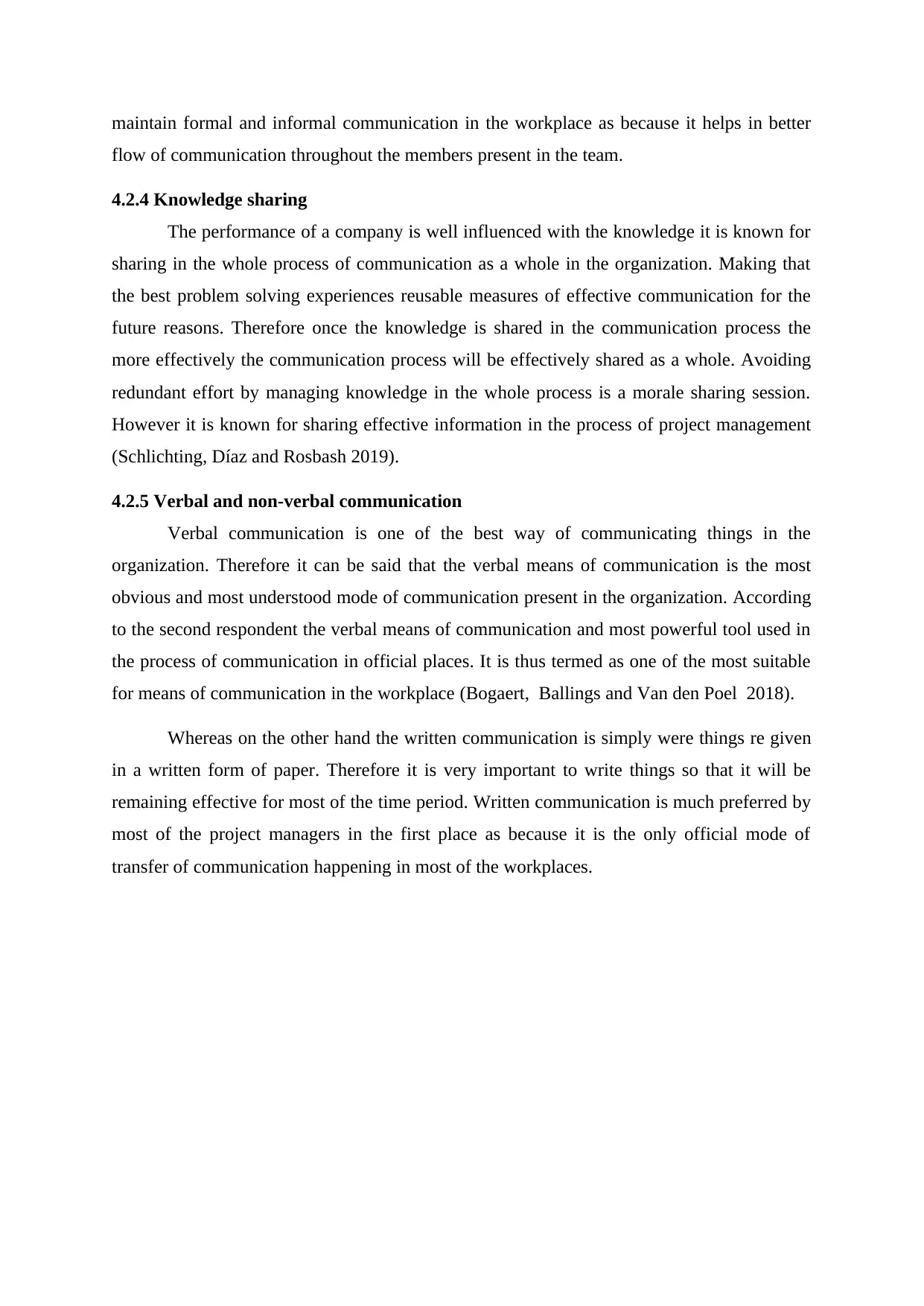
maintain formal and informal communication in the workplace as because it helps in better
flow of communication throughout the members present in the team.
4.2.4 Knowledge sharing
The performance of a company is well influenced with the knowledge it is known for
sharing in the whole process of communication as a whole in the organization. Making that
the best problem solving experiences reusable measures of effective communication for the
future reasons. Therefore once the knowledge is shared in the communication process the
more effectively the communication process will be effectively shared as a whole. Avoiding
redundant effort by managing knowledge in the whole process is a morale sharing session.
However it is known for sharing effective information in the process of project management
(Schlichting, Díaz and Rosbash 2019).
4.2.5 Verbal and non-verbal communication
Verbal communication is one of the best way of communicating things in the
organization. Therefore it can be said that the verbal means of communication is the most
obvious and most understood mode of communication present in the organization. According
to the second respondent the verbal means of communication and most powerful tool used in
the process of communication in official places. It is thus termed as one of the most suitable
for means of communication in the workplace (Bogaert, Ballings and Van den Poel 2018).
Whereas on the other hand the written communication is simply were things re given
in a written form of paper. Therefore it is very important to write things so that it will be
remaining effective for most of the time period. Written communication is much preferred by
most of the project managers in the first place as because it is the only official mode of
transfer of communication happening in most of the workplaces.
flow of communication throughout the members present in the team.
4.2.4 Knowledge sharing
The performance of a company is well influenced with the knowledge it is known for
sharing in the whole process of communication as a whole in the organization. Making that
the best problem solving experiences reusable measures of effective communication for the
future reasons. Therefore once the knowledge is shared in the communication process the
more effectively the communication process will be effectively shared as a whole. Avoiding
redundant effort by managing knowledge in the whole process is a morale sharing session.
However it is known for sharing effective information in the process of project management
(Schlichting, Díaz and Rosbash 2019).
4.2.5 Verbal and non-verbal communication
Verbal communication is one of the best way of communicating things in the
organization. Therefore it can be said that the verbal means of communication is the most
obvious and most understood mode of communication present in the organization. According
to the second respondent the verbal means of communication and most powerful tool used in
the process of communication in official places. It is thus termed as one of the most suitable
for means of communication in the workplace (Bogaert, Ballings and Van den Poel 2018).
Whereas on the other hand the written communication is simply were things re given
in a written form of paper. Therefore it is very important to write things so that it will be
remaining effective for most of the time period. Written communication is much preferred by
most of the project managers in the first place as because it is the only official mode of
transfer of communication happening in most of the workplaces.
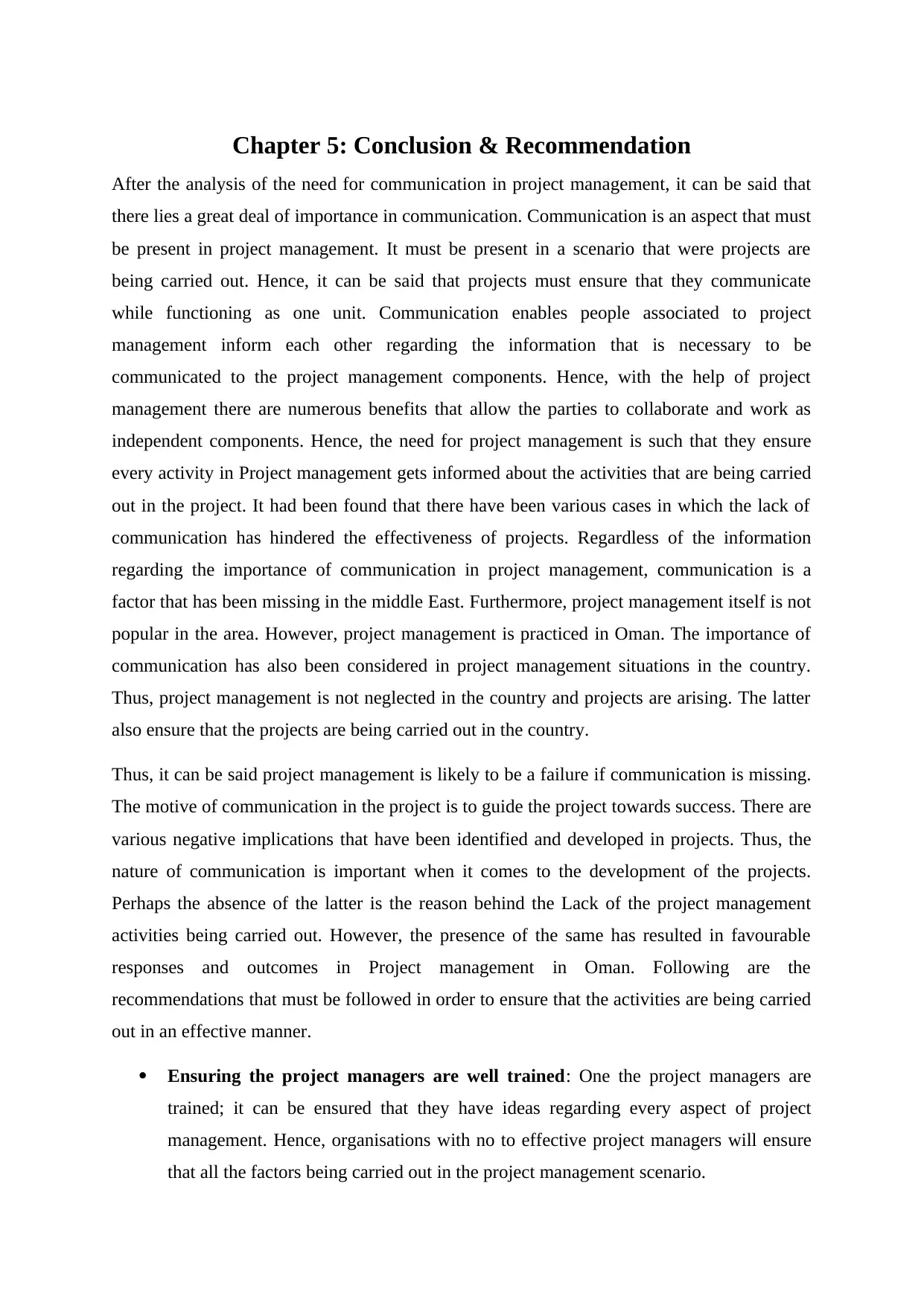
Chapter 5: Conclusion & Recommendation
After the analysis of the need for communication in project management, it can be said that
there lies a great deal of importance in communication. Communication is an aspect that must
be present in project management. It must be present in a scenario that were projects are
being carried out. Hence, it can be said that projects must ensure that they communicate
while functioning as one unit. Communication enables people associated to project
management inform each other regarding the information that is necessary to be
communicated to the project management components. Hence, with the help of project
management there are numerous benefits that allow the parties to collaborate and work as
independent components. Hence, the need for project management is such that they ensure
every activity in Project management gets informed about the activities that are being carried
out in the project. It had been found that there have been various cases in which the lack of
communication has hindered the effectiveness of projects. Regardless of the information
regarding the importance of communication in project management, communication is a
factor that has been missing in the middle East. Furthermore, project management itself is not
popular in the area. However, project management is practiced in Oman. The importance of
communication has also been considered in project management situations in the country.
Thus, project management is not neglected in the country and projects are arising. The latter
also ensure that the projects are being carried out in the country.
Thus, it can be said project management is likely to be a failure if communication is missing.
The motive of communication in the project is to guide the project towards success. There are
various negative implications that have been identified and developed in projects. Thus, the
nature of communication is important when it comes to the development of the projects.
Perhaps the absence of the latter is the reason behind the Lack of the project management
activities being carried out. However, the presence of the same has resulted in favourable
responses and outcomes in Project management in Oman. Following are the
recommendations that must be followed in order to ensure that the activities are being carried
out in an effective manner.
Ensuring the project managers are well trained: One the project managers are
trained; it can be ensured that they have ideas regarding every aspect of project
management. Hence, organisations with no to effective project managers will ensure
that all the factors being carried out in the project management scenario.
After the analysis of the need for communication in project management, it can be said that
there lies a great deal of importance in communication. Communication is an aspect that must
be present in project management. It must be present in a scenario that were projects are
being carried out. Hence, it can be said that projects must ensure that they communicate
while functioning as one unit. Communication enables people associated to project
management inform each other regarding the information that is necessary to be
communicated to the project management components. Hence, with the help of project
management there are numerous benefits that allow the parties to collaborate and work as
independent components. Hence, the need for project management is such that they ensure
every activity in Project management gets informed about the activities that are being carried
out in the project. It had been found that there have been various cases in which the lack of
communication has hindered the effectiveness of projects. Regardless of the information
regarding the importance of communication in project management, communication is a
factor that has been missing in the middle East. Furthermore, project management itself is not
popular in the area. However, project management is practiced in Oman. The importance of
communication has also been considered in project management situations in the country.
Thus, project management is not neglected in the country and projects are arising. The latter
also ensure that the projects are being carried out in the country.
Thus, it can be said project management is likely to be a failure if communication is missing.
The motive of communication in the project is to guide the project towards success. There are
various negative implications that have been identified and developed in projects. Thus, the
nature of communication is important when it comes to the development of the projects.
Perhaps the absence of the latter is the reason behind the Lack of the project management
activities being carried out. However, the presence of the same has resulted in favourable
responses and outcomes in Project management in Oman. Following are the
recommendations that must be followed in order to ensure that the activities are being carried
out in an effective manner.
Ensuring the project managers are well trained: One the project managers are
trained; it can be ensured that they have ideas regarding every aspect of project
management. Hence, organisations with no to effective project managers will ensure
that all the factors being carried out in the project management scenario.
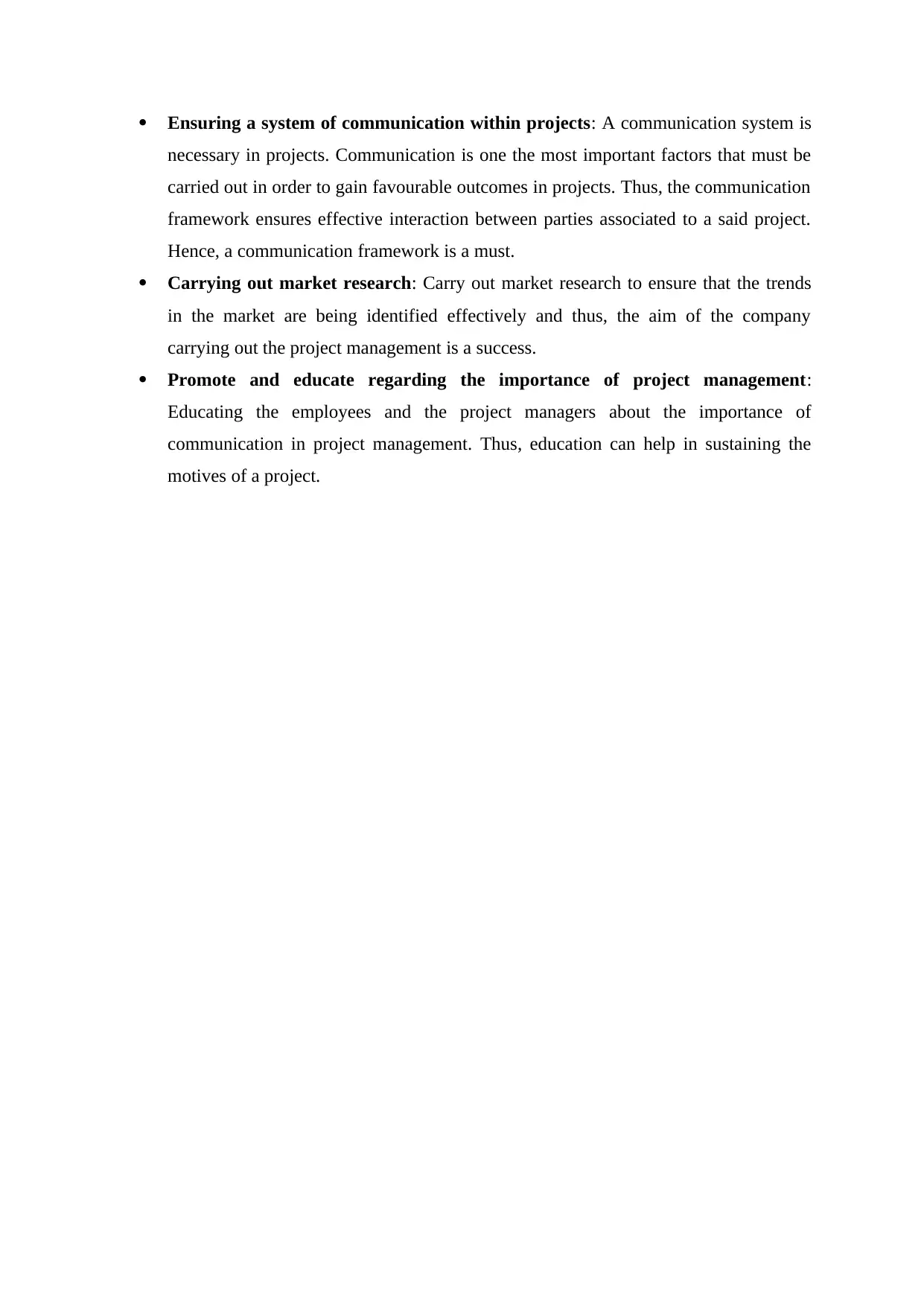
Ensuring a system of communication within projects: A communication system is
necessary in projects. Communication is one the most important factors that must be
carried out in order to gain favourable outcomes in projects. Thus, the communication
framework ensures effective interaction between parties associated to a said project.
Hence, a communication framework is a must.
Carrying out market research: Carry out market research to ensure that the trends
in the market are being identified effectively and thus, the aim of the company
carrying out the project management is a success.
Promote and educate regarding the importance of project management:
Educating the employees and the project managers about the importance of
communication in project management. Thus, education can help in sustaining the
motives of a project.
necessary in projects. Communication is one the most important factors that must be
carried out in order to gain favourable outcomes in projects. Thus, the communication
framework ensures effective interaction between parties associated to a said project.
Hence, a communication framework is a must.
Carrying out market research: Carry out market research to ensure that the trends
in the market are being identified effectively and thus, the aim of the company
carrying out the project management is a success.
Promote and educate regarding the importance of project management:
Educating the employees and the project managers about the importance of
communication in project management. Thus, education can help in sustaining the
motives of a project.
Secure Best Marks with AI Grader
Need help grading? Try our AI Grader for instant feedback on your assignments.
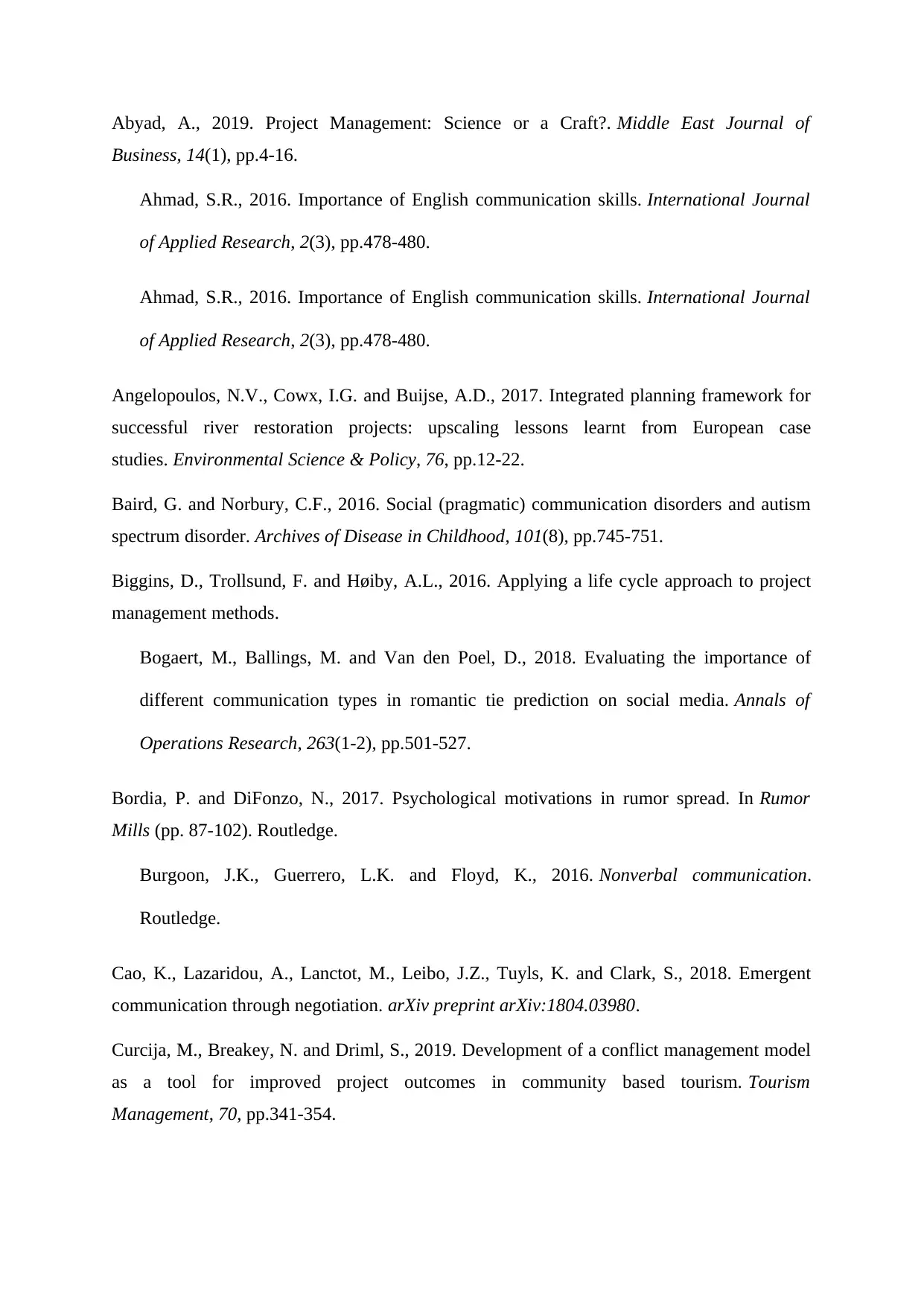
Abyad, A., 2019. Project Management: Science or a Craft?. Middle East Journal of
Business, 14(1), pp.4-16.
Ahmad, S.R., 2016. Importance of English communication skills. International Journal
of Applied Research, 2(3), pp.478-480.
Ahmad, S.R., 2016. Importance of English communication skills. International Journal
of Applied Research, 2(3), pp.478-480.
Angelopoulos, N.V., Cowx, I.G. and Buijse, A.D., 2017. Integrated planning framework for
successful river restoration projects: upscaling lessons learnt from European case
studies. Environmental Science & Policy, 76, pp.12-22.
Baird, G. and Norbury, C.F., 2016. Social (pragmatic) communication disorders and autism
spectrum disorder. Archives of Disease in Childhood, 101(8), pp.745-751.
Biggins, D., Trollsund, F. and Høiby, A.L., 2016. Applying a life cycle approach to project
management methods.
Bogaert, M., Ballings, M. and Van den Poel, D., 2018. Evaluating the importance of
different communication types in romantic tie prediction on social media. Annals of
Operations Research, 263(1-2), pp.501-527.
Bordia, P. and DiFonzo, N., 2017. Psychological motivations in rumor spread. In Rumor
Mills (pp. 87-102). Routledge.
Burgoon, J.K., Guerrero, L.K. and Floyd, K., 2016. Nonverbal communication.
Routledge.
Cao, K., Lazaridou, A., Lanctot, M., Leibo, J.Z., Tuyls, K. and Clark, S., 2018. Emergent
communication through negotiation. arXiv preprint arXiv:1804.03980.
Curcija, M., Breakey, N. and Driml, S., 2019. Development of a conflict management model
as a tool for improved project outcomes in community based tourism. Tourism
Management, 70, pp.341-354.
Business, 14(1), pp.4-16.
Ahmad, S.R., 2016. Importance of English communication skills. International Journal
of Applied Research, 2(3), pp.478-480.
Ahmad, S.R., 2016. Importance of English communication skills. International Journal
of Applied Research, 2(3), pp.478-480.
Angelopoulos, N.V., Cowx, I.G. and Buijse, A.D., 2017. Integrated planning framework for
successful river restoration projects: upscaling lessons learnt from European case
studies. Environmental Science & Policy, 76, pp.12-22.
Baird, G. and Norbury, C.F., 2016. Social (pragmatic) communication disorders and autism
spectrum disorder. Archives of Disease in Childhood, 101(8), pp.745-751.
Biggins, D., Trollsund, F. and Høiby, A.L., 2016. Applying a life cycle approach to project
management methods.
Bogaert, M., Ballings, M. and Van den Poel, D., 2018. Evaluating the importance of
different communication types in romantic tie prediction on social media. Annals of
Operations Research, 263(1-2), pp.501-527.
Bordia, P. and DiFonzo, N., 2017. Psychological motivations in rumor spread. In Rumor
Mills (pp. 87-102). Routledge.
Burgoon, J.K., Guerrero, L.K. and Floyd, K., 2016. Nonverbal communication.
Routledge.
Cao, K., Lazaridou, A., Lanctot, M., Leibo, J.Z., Tuyls, K. and Clark, S., 2018. Emergent
communication through negotiation. arXiv preprint arXiv:1804.03980.
Curcija, M., Breakey, N. and Driml, S., 2019. Development of a conflict management model
as a tool for improved project outcomes in community based tourism. Tourism
Management, 70, pp.341-354.
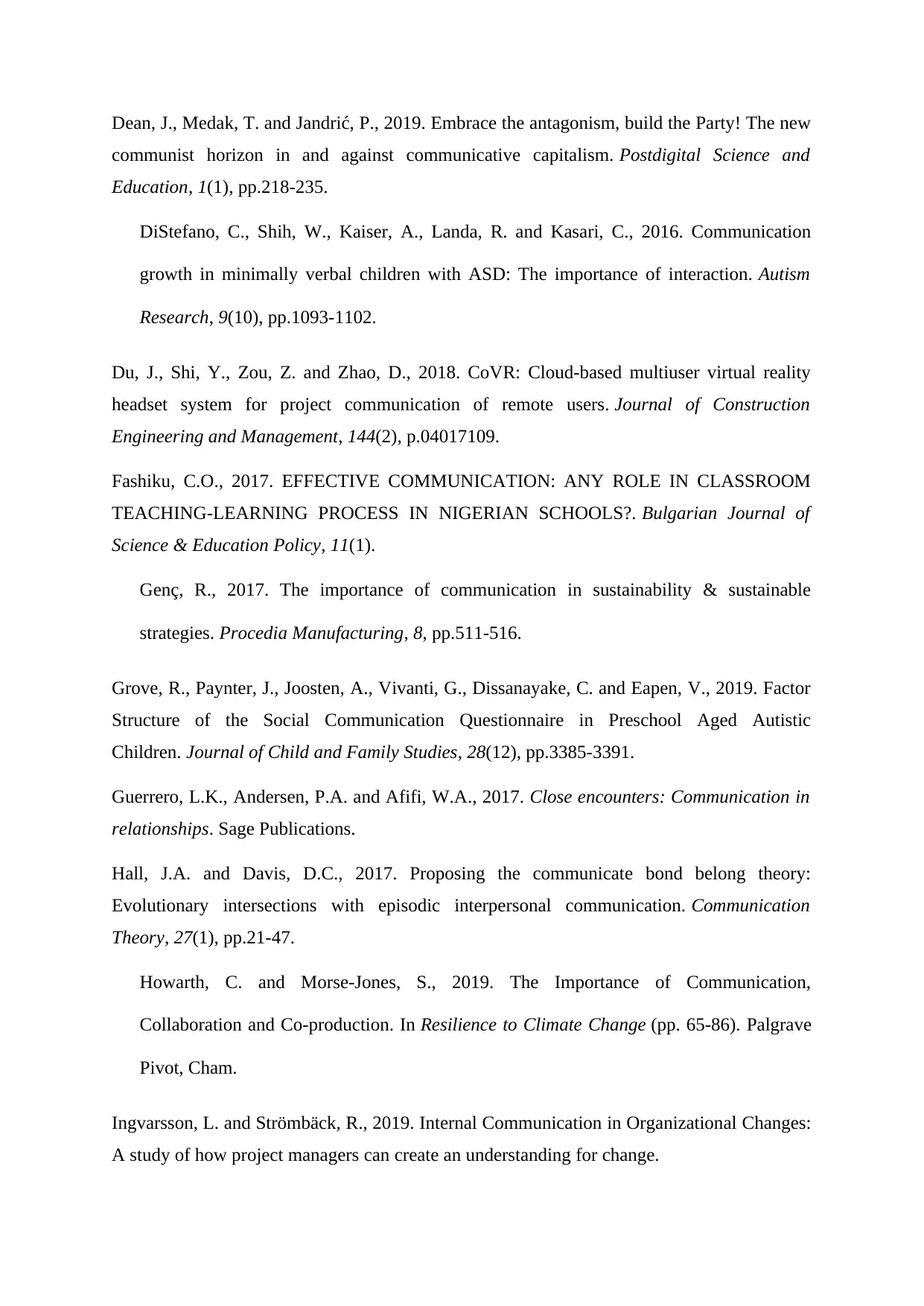
Dean, J., Medak, T. and Jandrić, P., 2019. Embrace the antagonism, build the Party! The new
communist horizon in and against communicative capitalism. Postdigital Science and
Education, 1(1), pp.218-235.
DiStefano, C., Shih, W., Kaiser, A., Landa, R. and Kasari, C., 2016. Communication
growth in minimally verbal children with ASD: The importance of interaction. Autism
Research, 9(10), pp.1093-1102.
Du, J., Shi, Y., Zou, Z. and Zhao, D., 2018. CoVR: Cloud-based multiuser virtual reality
headset system for project communication of remote users. Journal of Construction
Engineering and Management, 144(2), p.04017109.
Fashiku, C.O., 2017. EFFECTIVE COMMUNICATION: ANY ROLE IN CLASSROOM
TEACHING-LEARNING PROCESS IN NIGERIAN SCHOOLS?. Bulgarian Journal of
Science & Education Policy, 11(1).
Genç, R., 2017. The importance of communication in sustainability & sustainable
strategies. Procedia Manufacturing, 8, pp.511-516.
Grove, R., Paynter, J., Joosten, A., Vivanti, G., Dissanayake, C. and Eapen, V., 2019. Factor
Structure of the Social Communication Questionnaire in Preschool Aged Autistic
Children. Journal of Child and Family Studies, 28(12), pp.3385-3391.
Guerrero, L.K., Andersen, P.A. and Afifi, W.A., 2017. Close encounters: Communication in
relationships. Sage Publications.
Hall, J.A. and Davis, D.C., 2017. Proposing the communicate bond belong theory:
Evolutionary intersections with episodic interpersonal communication. Communication
Theory, 27(1), pp.21-47.
Howarth, C. and Morse-Jones, S., 2019. The Importance of Communication,
Collaboration and Co-production. In Resilience to Climate Change (pp. 65-86). Palgrave
Pivot, Cham.
Ingvarsson, L. and Strömbäck, R., 2019. Internal Communication in Organizational Changes:
A study of how project managers can create an understanding for change.
communist horizon in and against communicative capitalism. Postdigital Science and
Education, 1(1), pp.218-235.
DiStefano, C., Shih, W., Kaiser, A., Landa, R. and Kasari, C., 2016. Communication
growth in minimally verbal children with ASD: The importance of interaction. Autism
Research, 9(10), pp.1093-1102.
Du, J., Shi, Y., Zou, Z. and Zhao, D., 2018. CoVR: Cloud-based multiuser virtual reality
headset system for project communication of remote users. Journal of Construction
Engineering and Management, 144(2), p.04017109.
Fashiku, C.O., 2017. EFFECTIVE COMMUNICATION: ANY ROLE IN CLASSROOM
TEACHING-LEARNING PROCESS IN NIGERIAN SCHOOLS?. Bulgarian Journal of
Science & Education Policy, 11(1).
Genç, R., 2017. The importance of communication in sustainability & sustainable
strategies. Procedia Manufacturing, 8, pp.511-516.
Grove, R., Paynter, J., Joosten, A., Vivanti, G., Dissanayake, C. and Eapen, V., 2019. Factor
Structure of the Social Communication Questionnaire in Preschool Aged Autistic
Children. Journal of Child and Family Studies, 28(12), pp.3385-3391.
Guerrero, L.K., Andersen, P.A. and Afifi, W.A., 2017. Close encounters: Communication in
relationships. Sage Publications.
Hall, J.A. and Davis, D.C., 2017. Proposing the communicate bond belong theory:
Evolutionary intersections with episodic interpersonal communication. Communication
Theory, 27(1), pp.21-47.
Howarth, C. and Morse-Jones, S., 2019. The Importance of Communication,
Collaboration and Co-production. In Resilience to Climate Change (pp. 65-86). Palgrave
Pivot, Cham.
Ingvarsson, L. and Strömbäck, R., 2019. Internal Communication in Organizational Changes:
A study of how project managers can create an understanding for change.
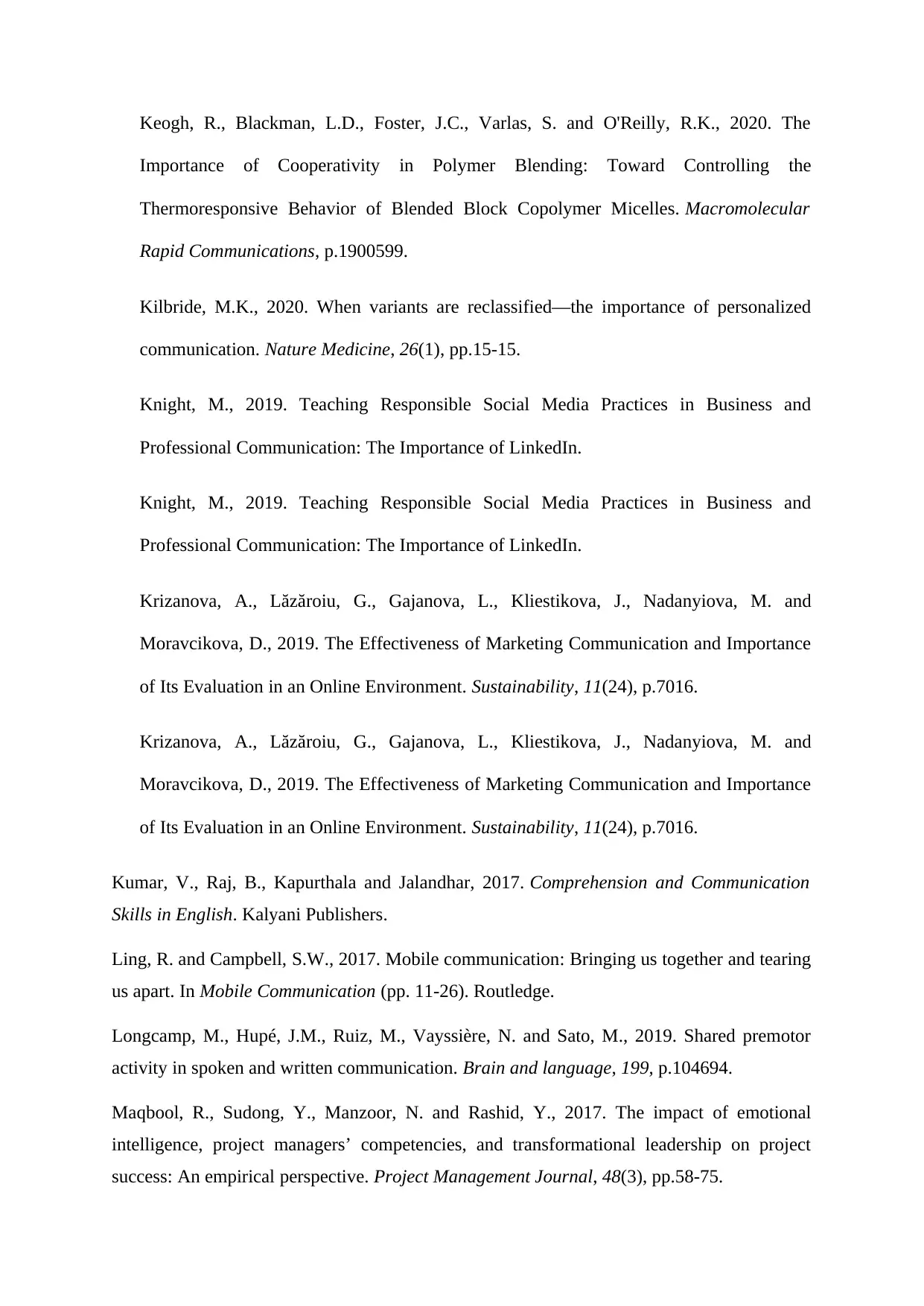
Keogh, R., Blackman, L.D., Foster, J.C., Varlas, S. and O'Reilly, R.K., 2020. The
Importance of Cooperativity in Polymer Blending: Toward Controlling the
Thermoresponsive Behavior of Blended Block Copolymer Micelles. Macromolecular
Rapid Communications, p.1900599.
Kilbride, M.K., 2020. When variants are reclassified—the importance of personalized
communication. Nature Medicine, 26(1), pp.15-15.
Knight, M., 2019. Teaching Responsible Social Media Practices in Business and
Professional Communication: The Importance of LinkedIn.
Knight, M., 2019. Teaching Responsible Social Media Practices in Business and
Professional Communication: The Importance of LinkedIn.
Krizanova, A., Lăzăroiu, G., Gajanova, L., Kliestikova, J., Nadanyiova, M. and
Moravcikova, D., 2019. The Effectiveness of Marketing Communication and Importance
of Its Evaluation in an Online Environment. Sustainability, 11(24), p.7016.
Krizanova, A., Lăzăroiu, G., Gajanova, L., Kliestikova, J., Nadanyiova, M. and
Moravcikova, D., 2019. The Effectiveness of Marketing Communication and Importance
of Its Evaluation in an Online Environment. Sustainability, 11(24), p.7016.
Kumar, V., Raj, B., Kapurthala and Jalandhar, 2017. Comprehension and Communication
Skills in English. Kalyani Publishers.
Ling, R. and Campbell, S.W., 2017. Mobile communication: Bringing us together and tearing
us apart. In Mobile Communication (pp. 11-26). Routledge.
Longcamp, M., Hupé, J.M., Ruiz, M., Vayssière, N. and Sato, M., 2019. Shared premotor
activity in spoken and written communication. Brain and language, 199, p.104694.
Maqbool, R., Sudong, Y., Manzoor, N. and Rashid, Y., 2017. The impact of emotional
intelligence, project managers’ competencies, and transformational leadership on project
success: An empirical perspective. Project Management Journal, 48(3), pp.58-75.
Importance of Cooperativity in Polymer Blending: Toward Controlling the
Thermoresponsive Behavior of Blended Block Copolymer Micelles. Macromolecular
Rapid Communications, p.1900599.
Kilbride, M.K., 2020. When variants are reclassified—the importance of personalized
communication. Nature Medicine, 26(1), pp.15-15.
Knight, M., 2019. Teaching Responsible Social Media Practices in Business and
Professional Communication: The Importance of LinkedIn.
Knight, M., 2019. Teaching Responsible Social Media Practices in Business and
Professional Communication: The Importance of LinkedIn.
Krizanova, A., Lăzăroiu, G., Gajanova, L., Kliestikova, J., Nadanyiova, M. and
Moravcikova, D., 2019. The Effectiveness of Marketing Communication and Importance
of Its Evaluation in an Online Environment. Sustainability, 11(24), p.7016.
Krizanova, A., Lăzăroiu, G., Gajanova, L., Kliestikova, J., Nadanyiova, M. and
Moravcikova, D., 2019. The Effectiveness of Marketing Communication and Importance
of Its Evaluation in an Online Environment. Sustainability, 11(24), p.7016.
Kumar, V., Raj, B., Kapurthala and Jalandhar, 2017. Comprehension and Communication
Skills in English. Kalyani Publishers.
Ling, R. and Campbell, S.W., 2017. Mobile communication: Bringing us together and tearing
us apart. In Mobile Communication (pp. 11-26). Routledge.
Longcamp, M., Hupé, J.M., Ruiz, M., Vayssière, N. and Sato, M., 2019. Shared premotor
activity in spoken and written communication. Brain and language, 199, p.104694.
Maqbool, R., Sudong, Y., Manzoor, N. and Rashid, Y., 2017. The impact of emotional
intelligence, project managers’ competencies, and transformational leadership on project
success: An empirical perspective. Project Management Journal, 48(3), pp.58-75.
Paraphrase This Document
Need a fresh take? Get an instant paraphrase of this document with our AI Paraphraser
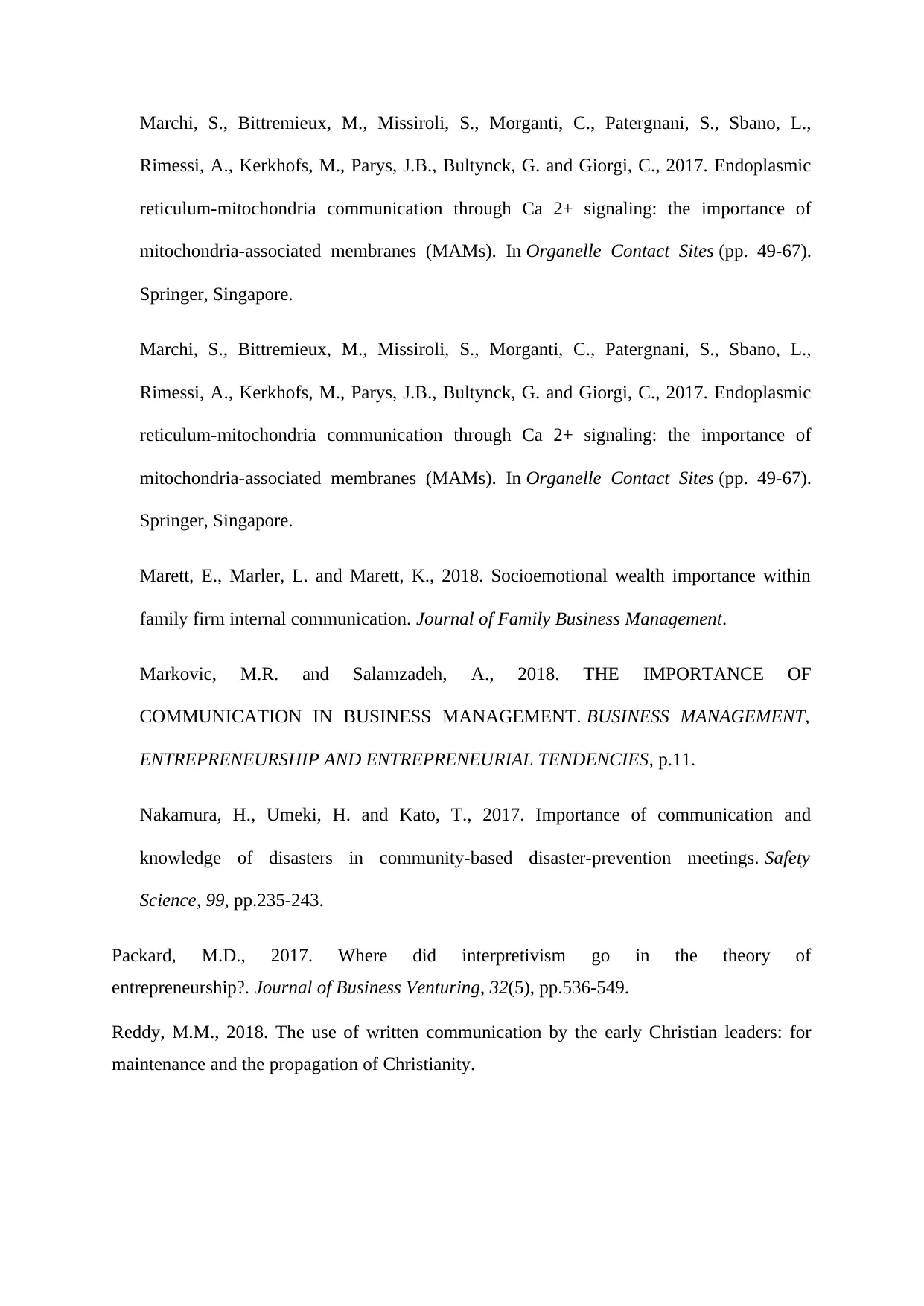
Marchi, S., Bittremieux, M., Missiroli, S., Morganti, C., Patergnani, S., Sbano, L.,
Rimessi, A., Kerkhofs, M., Parys, J.B., Bultynck, G. and Giorgi, C., 2017. Endoplasmic
reticulum-mitochondria communication through Ca 2+ signaling: the importance of
mitochondria-associated membranes (MAMs). In Organelle Contact Sites (pp. 49-67).
Springer, Singapore.
Marchi, S., Bittremieux, M., Missiroli, S., Morganti, C., Patergnani, S., Sbano, L.,
Rimessi, A., Kerkhofs, M., Parys, J.B., Bultynck, G. and Giorgi, C., 2017. Endoplasmic
reticulum-mitochondria communication through Ca 2+ signaling: the importance of
mitochondria-associated membranes (MAMs). In Organelle Contact Sites (pp. 49-67).
Springer, Singapore.
Marett, E., Marler, L. and Marett, K., 2018. Socioemotional wealth importance within
family firm internal communication. Journal of Family Business Management.
Markovic, M.R. and Salamzadeh, A., 2018. THE IMPORTANCE OF
COMMUNICATION IN BUSINESS MANAGEMENT. BUSINESS MANAGEMENT,
ENTREPRENEURSHIP AND ENTREPRENEURIAL TENDENCIES, p.11.
Nakamura, H., Umeki, H. and Kato, T., 2017. Importance of communication and
knowledge of disasters in community-based disaster-prevention meetings. Safety
Science, 99, pp.235-243.
Packard, M.D., 2017. Where did interpretivism go in the theory of
entrepreneurship?. Journal of Business Venturing, 32(5), pp.536-549.
Reddy, M.M., 2018. The use of written communication by the early Christian leaders: for
maintenance and the propagation of Christianity.
Rimessi, A., Kerkhofs, M., Parys, J.B., Bultynck, G. and Giorgi, C., 2017. Endoplasmic
reticulum-mitochondria communication through Ca 2+ signaling: the importance of
mitochondria-associated membranes (MAMs). In Organelle Contact Sites (pp. 49-67).
Springer, Singapore.
Marchi, S., Bittremieux, M., Missiroli, S., Morganti, C., Patergnani, S., Sbano, L.,
Rimessi, A., Kerkhofs, M., Parys, J.B., Bultynck, G. and Giorgi, C., 2017. Endoplasmic
reticulum-mitochondria communication through Ca 2+ signaling: the importance of
mitochondria-associated membranes (MAMs). In Organelle Contact Sites (pp. 49-67).
Springer, Singapore.
Marett, E., Marler, L. and Marett, K., 2018. Socioemotional wealth importance within
family firm internal communication. Journal of Family Business Management.
Markovic, M.R. and Salamzadeh, A., 2018. THE IMPORTANCE OF
COMMUNICATION IN BUSINESS MANAGEMENT. BUSINESS MANAGEMENT,
ENTREPRENEURSHIP AND ENTREPRENEURIAL TENDENCIES, p.11.
Nakamura, H., Umeki, H. and Kato, T., 2017. Importance of communication and
knowledge of disasters in community-based disaster-prevention meetings. Safety
Science, 99, pp.235-243.
Packard, M.D., 2017. Where did interpretivism go in the theory of
entrepreneurship?. Journal of Business Venturing, 32(5), pp.536-549.
Reddy, M.M., 2018. The use of written communication by the early Christian leaders: for
maintenance and the propagation of Christianity.
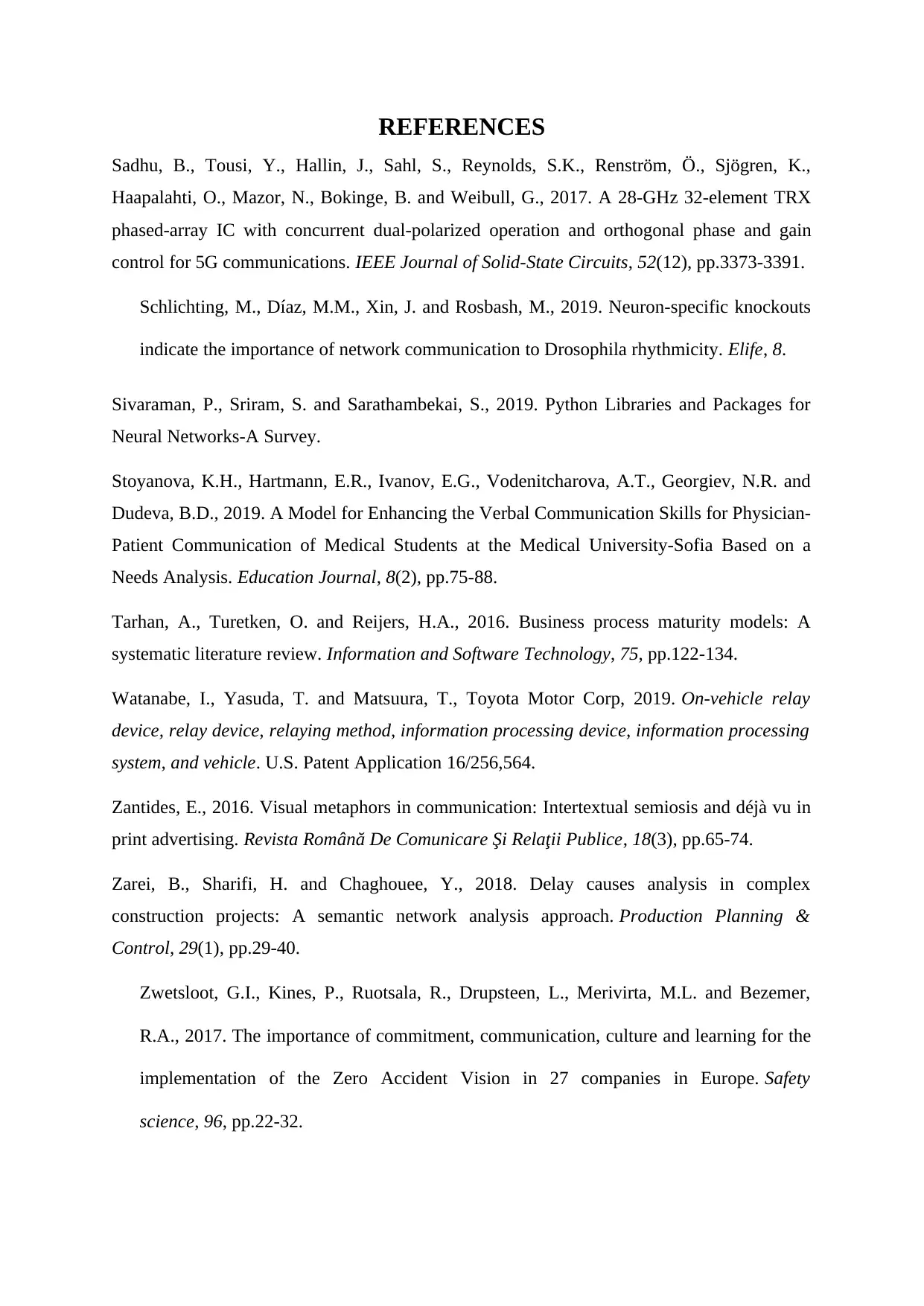
REFERENCES
Sadhu, B., Tousi, Y., Hallin, J., Sahl, S., Reynolds, S.K., Renström, Ö., Sjögren, K.,
Haapalahti, O., Mazor, N., Bokinge, B. and Weibull, G., 2017. A 28-GHz 32-element TRX
phased-array IC with concurrent dual-polarized operation and orthogonal phase and gain
control for 5G communications. IEEE Journal of Solid-State Circuits, 52(12), pp.3373-3391.
Schlichting, M., Díaz, M.M., Xin, J. and Rosbash, M., 2019. Neuron-specific knockouts
indicate the importance of network communication to Drosophila rhythmicity. Elife, 8.
Sivaraman, P., Sriram, S. and Sarathambekai, S., 2019. Python Libraries and Packages for
Neural Networks-A Survey.
Stoyanova, K.H., Hartmann, E.R., Ivanov, E.G., Vodenitcharova, A.T., Georgiev, N.R. and
Dudeva, B.D., 2019. A Model for Enhancing the Verbal Communication Skills for Physician-
Patient Communication of Medical Students at the Medical University-Sofia Based on a
Needs Analysis. Education Journal, 8(2), pp.75-88.
Tarhan, A., Turetken, O. and Reijers, H.A., 2016. Business process maturity models: A
systematic literature review. Information and Software Technology, 75, pp.122-134.
Watanabe, I., Yasuda, T. and Matsuura, T., Toyota Motor Corp, 2019. On-vehicle relay
device, relay device, relaying method, information processing device, information processing
system, and vehicle. U.S. Patent Application 16/256,564.
Zantides, E., 2016. Visual metaphors in communication: Intertextual semiosis and déjà vu in
print advertising. Revista Română De Comunicare Şi Relaţii Publice, 18(3), pp.65-74.
Zarei, B., Sharifi, H. and Chaghouee, Y., 2018. Delay causes analysis in complex
construction projects: A semantic network analysis approach. Production Planning &
Control, 29(1), pp.29-40.
Zwetsloot, G.I., Kines, P., Ruotsala, R., Drupsteen, L., Merivirta, M.L. and Bezemer,
R.A., 2017. The importance of commitment, communication, culture and learning for the
implementation of the Zero Accident Vision in 27 companies in Europe. Safety
science, 96, pp.22-32.
Sadhu, B., Tousi, Y., Hallin, J., Sahl, S., Reynolds, S.K., Renström, Ö., Sjögren, K.,
Haapalahti, O., Mazor, N., Bokinge, B. and Weibull, G., 2017. A 28-GHz 32-element TRX
phased-array IC with concurrent dual-polarized operation and orthogonal phase and gain
control for 5G communications. IEEE Journal of Solid-State Circuits, 52(12), pp.3373-3391.
Schlichting, M., Díaz, M.M., Xin, J. and Rosbash, M., 2019. Neuron-specific knockouts
indicate the importance of network communication to Drosophila rhythmicity. Elife, 8.
Sivaraman, P., Sriram, S. and Sarathambekai, S., 2019. Python Libraries and Packages for
Neural Networks-A Survey.
Stoyanova, K.H., Hartmann, E.R., Ivanov, E.G., Vodenitcharova, A.T., Georgiev, N.R. and
Dudeva, B.D., 2019. A Model for Enhancing the Verbal Communication Skills for Physician-
Patient Communication of Medical Students at the Medical University-Sofia Based on a
Needs Analysis. Education Journal, 8(2), pp.75-88.
Tarhan, A., Turetken, O. and Reijers, H.A., 2016. Business process maturity models: A
systematic literature review. Information and Software Technology, 75, pp.122-134.
Watanabe, I., Yasuda, T. and Matsuura, T., Toyota Motor Corp, 2019. On-vehicle relay
device, relay device, relaying method, information processing device, information processing
system, and vehicle. U.S. Patent Application 16/256,564.
Zantides, E., 2016. Visual metaphors in communication: Intertextual semiosis and déjà vu in
print advertising. Revista Română De Comunicare Şi Relaţii Publice, 18(3), pp.65-74.
Zarei, B., Sharifi, H. and Chaghouee, Y., 2018. Delay causes analysis in complex
construction projects: A semantic network analysis approach. Production Planning &
Control, 29(1), pp.29-40.
Zwetsloot, G.I., Kines, P., Ruotsala, R., Drupsteen, L., Merivirta, M.L. and Bezemer,
R.A., 2017. The importance of commitment, communication, culture and learning for the
implementation of the Zero Accident Vision in 27 companies in Europe. Safety
science, 96, pp.22-32.

1 out of 34
Related Documents
Your All-in-One AI-Powered Toolkit for Academic Success.
+13062052269
info@desklib.com
Available 24*7 on WhatsApp / Email
![[object Object]](/_next/static/media/star-bottom.7253800d.svg)
Unlock your academic potential
© 2024 | Zucol Services PVT LTD | All rights reserved.





